Entering the gates of the Lord
By Dan McWilliams
Archbishop Shelton J. Fabre extended his hand and said only five words to start his homily in the dedication Mass for the new St. Alphonsus Church in Crossville on Sept. 12, and the assembly erupted in applause.
“Well, what do you think?” he asked.
The St. Alphonsus faithful waited 20 years for a traditional worship space after attending Mass in Liguori Hall, their parish life center that was dedicated in 2003.
Archbishop Fabre, apostolic administrator of the Diocese of Knoxville, dedicated the new church and its altar. He installed relics of the parish namesake, St. Alphonsus Liguori, and Blessed Stanley Rother in the altar.

Principal concelebrants were St. Alphonsus pastor Father Mark Schuster and Father Christopher Floersh, parochial vicar of St. John Neumann Parish in Farragut.
Seven additional diocesan priests took part, and Deacons Daniel Herman and Peter Minneci, who serves at St. Alphonsus, assisted. Deacons Hicks Armor and Walt Otey were masters of ceremonies.
The priests concelebrating were Father Michael Woods, pastor of
St. Francis of Assisi in Fairfield Glade; Father Michael Nolan, pastor of St. Thérèse of Lisieux in Cleveland; Father Dominic Nguyen, pastor of Divine Mercy in Knoxville; Father David Carter, rector of the Basilica of Sts. Peter and Paul in Chattanooga; Father Michael Hendershott, associate pastor of Holy Ghost in Knoxville; Father Joseph Austin, parochial vicar of Our Lady of Fatima in Alcoa; and Father Martin Gladysz,
The wait is over
Left: Priests, deacons, altar servers, and St. Alphonsus Parish members process from Liguori Hall to the new St. Alphonsus Church on Sept. 12. Liguori Hall has served for two decades as both worship space and as a parish hall
Below: Participants in the dedication Mass prepare to enter the new St. Alphonsus Church in Crossville.
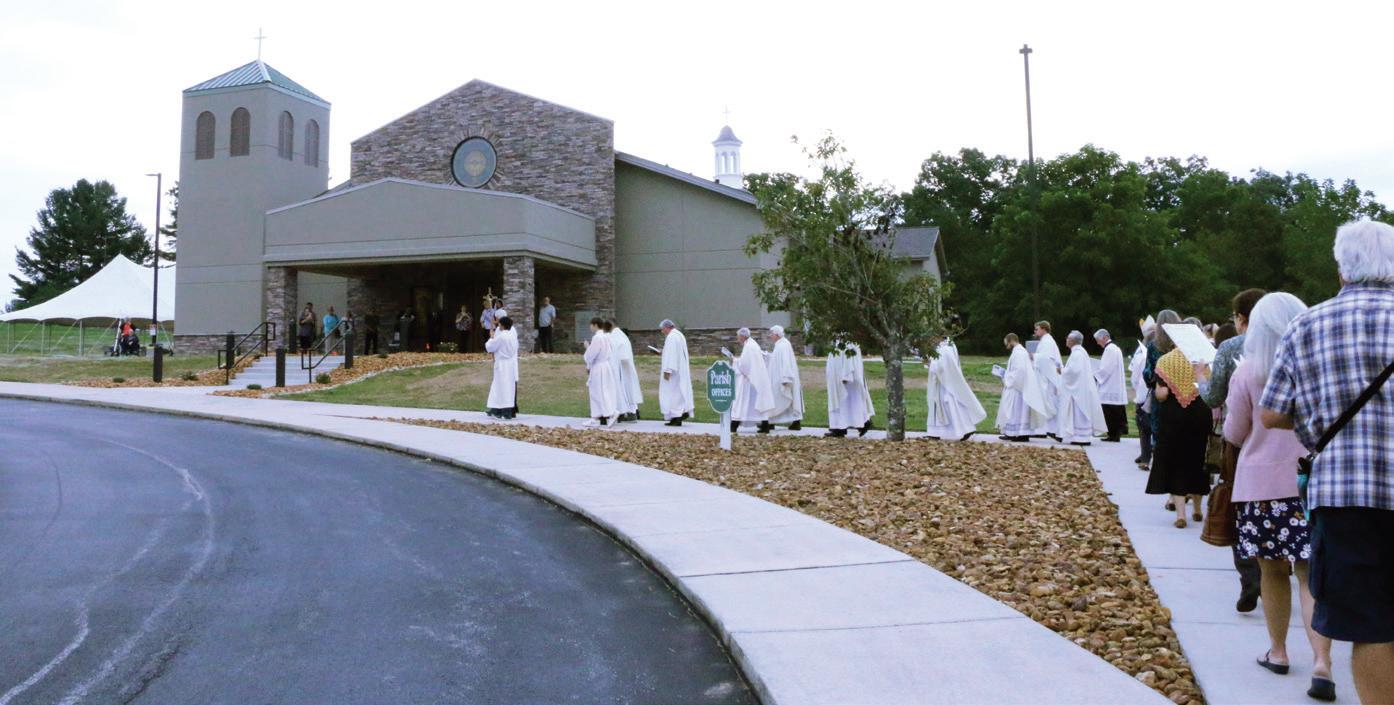
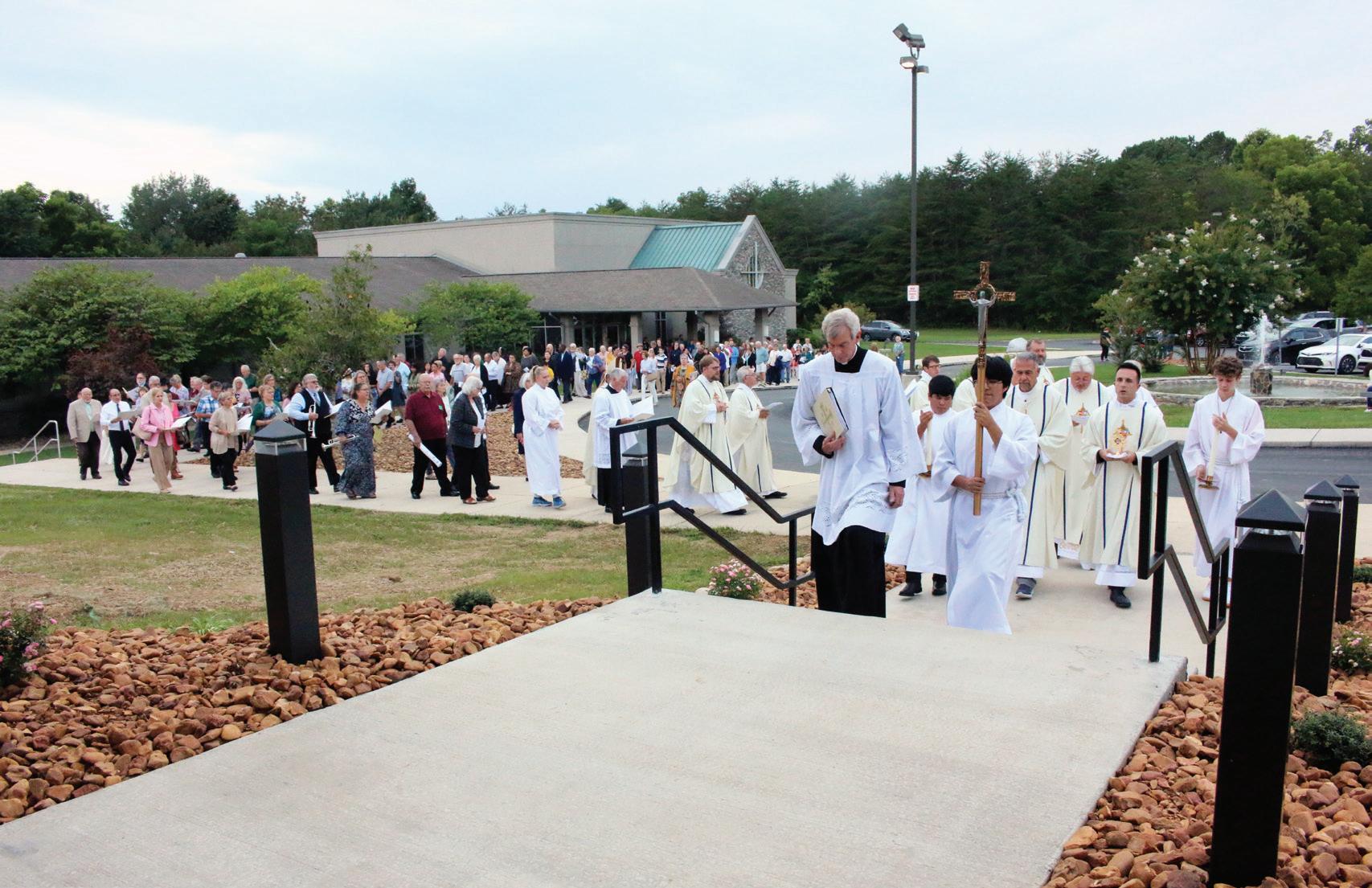
St. Alphonsus Parish moves into its new church with thanksgiving ‘Heroic.
Holy. Humble.’
Life of Fr. Patrick Ryan celebrated at Closing Session of Tribunal in sainthood cause
By Gabrielle Nolan
The Diocese of Knoxville is one step closer in the cause for beatification and canonization of Servant of God Father Patrick Ryan.
The Closing Session of the Tribunal of the Diocese of Knoxville for the inquiry examining the life, virtues, offering of life, reputation of holiness, and signs of intercessory power of the Servant of God Father Patrick Ryan took place on Sept. 28 at the Basilica of Sts. Peter and Paul in Chattanooga.
Archbishop Joseph E. Kurtz, the second bishop of the Diocese of Knoxville who served in East Tennessee from 1999-2007, was the celebrant of the historic occasion.
Clergy in attendance were Father David Carter, episcopal delegate for the cause and rector of the basilica; Deacon Sean Smith, chancellor of the diocese; Deacon Gaspar DeGaetano, vice postulator for the cause; Father John Orr, promoter of justice for the cause; Deacon Hicks Armor, notary; Father Michael Hendershott, associate pastor of Holy Ghost Parish in Knoxville; Monsignor Al Humbrecht, pastor of Holy Spirit in Soddy-Daisy;
Father Mark Schuster, pastor of St. Alphonsus in Crossville; Father Michael Woods, pastor of St. Francis of Assisi in Fairfield Glade;
Father Michael Nolan, pastor of St. Thérèse of Lisieux in Cleveland; and Father Nick Tran, priest in residence at the basilica. Deacon Wade
Eckler also was present. The Closing Session occurred in the context of Liturgy of the Hours’
Father
continued on page A11
Ryan
GABRIELLE NOLAN
St. Alphonsus continued on page A12 DAN MCWILLIAMS BILL BREWER Signed, sealed,
Catholic commentary A3 Parish news B4 Diocesan calendar B5 Columns B6-7 Catholic schools B9-10 La Cosecha Section C GOLDEN GIRLS Religious Sisters of Mercy of Alma mark 50th anniversary A4 CATHOLICS IN CARTER COUNTY St. Elizabeth recalls 100 years of the faith B1 HARPS AND BANJOS Bluegrass Mass performed at Our Lady of Fatima in Alcoa B1 October 1 | 2023 VOL 33 NO 2 IN THIS ISSUE
and ready to be delivered Archbishop
Emeritus Joseph E. Kurtz, center, prepares to seal
documents in the cause
for sainthood for Father Patrick Ryan. Assisting are Father David Carter, left, and Deacon Gaspar DeGaetano.
Archbishop Fabre blesses new CCETN offi ces
Grand reopening event showcases renovated headquarters for the public
By Bill Brewer
Archbishop
Shelton J. Fabre
blessed Catholic Charities of East Tennessee’s newly renovated Knoxville offices on Sept. 27 during a public ribbon-cutting event for supporters, volunteers, staff, and clients of the Diocese of Knoxville social-services agency.

It was the first time members of the public could tour the updated offices that reopened over the summer following a November 2021 arson fire that gutted the building at 119 Dameron Ave. The total project cost was about $2 million.
The fire forced the agency that ministers to people in need to relocate its services for more than a year and a half. The arsonist who set the blaze was never captured.
Archbishop Fabre spoke to the group gathered for the blessing and ribbon-cutting, saying Catholic Charities within the Catholic Church is the true heart and face of Jesus.
“When I desire to see who Jesus
Sr. Regina

calls us to be, I look to two places. I look to the Eucharist, ‘Do this in memory of Me,’ and I look to Catholic Charities because I think
Catholic Charities is the Church at its very, very best. In all of the Gospel messages of Jesus Christ, one of the consistent themes is take care of
those who are needy, respond to the demands of the poor, be the heart of Jesus Christ to those for whom life is difficult, and see Jesus Christ in the faces and in the lives of our brothers and sisters who approach Catholic Charities with need,” said the archbishop, whose episcopal motto is “Comfort my people.”
The shepherd of the Archdiocese of Louisville and the Louisville Province, of which the Diocese of Knoxville is a part, recounted how Catholic Charities time and again ministered to those in need in his native Louisiana, most critically in the wake of hurricanes that batter the Gulf Coast.
“I think Catholic Charities is one of the places where the Church is at its best. Charity, something that our Lord, Jesus Christ, challenges you and me to embrace every single day. Charity is just another word for love. As I see up there (the sign) Catholic Charities, I think you could say this is Catholic love
How to sign up and qualify for Diocese of Knoxville’s safe-environment program
The Diocese of Knoxville has implemented the CMG Connect platform to administer the Safe Environment Program, which replaces the former Safe Environment Program (VIRTUS “Protecting God’s Children”).

element of the Safe Environment Program
The Handmaids of the Precious Blood in 2022 celebrated their Diamond Jubilee: 75 years since their founding in 1947; 75 years of prayer and sacrifice for priests. Did you know you can receive weekly cartoons and short reflections and news from the Handmaids of the Precious Blood? Visit their website, nunsforpriests.org, and sign up for the FIAT newsletter.
October Prayer Intention for the Synod
Pope Francis
DIOCESE OF KNOXVILLE
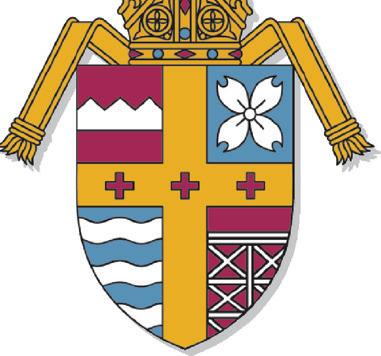

PROCEDURE FOR REPORTING SEXUAL ABUSE
Anyone who has actual knowledge of or who has reasonable cause to suspect an incident of sexual abuse should report such information to the appropriate civil authorities rst, then to the McNabb Center victim's assistance coordinator, 865.321.9080.
CMG Connect is a web-based platform that will assist in ensuring that all employees and volunteers who are in a position of trust with children and vulnerable adults within Diocese of Knoxville schools and parishes are trained to recognize behavior patterns of potential abusers and provide pro-active measures for preventing abuse in any context.
“Safe Haven-It’s Up to You” is a three-part video that provides vignettes of real-life situations to educate the viewer about methods of grooming, desensitization, bullying, and neglect, all of which can lead to abuse.
Each part of the video is immediately followed by a brief questionnaire to further develop understanding.
Education is a key
All clergy, employees, contracted school personnel, volunteers, members of groups and organizations over the age of 18 who work, volunteer, or participate in any capacity are required to complete the diocesan Safe Environment training and a criminal-background check before they can begin employment, volunteer, or participate with ministries, groups, and organizations affiliated with the Diocese of Knoxville.
In addition, the mandatory renewal training must be completed every five years and a new background check submitted before the five-year expiration of prior training.
The Diocese of Knoxville Safe Environment compliance training and renewal training is a condition of employment and for volunteer ministry in the Diocese of Knoxville.
The CMG Connect
WATCH UPDATES DioKnoxTV


platform contains all three elements of the Diocese of Knoxville’s Safe Environment Program:

n Annual review of the Diocese of Knoxville’s Policy and Procedures Relating to Sexual Misconduct; n CMG Connect Safe Haven training program to be completed every five years; n Criminal background check to be completed every five years.
In compliance with the Diocese of Knoxville’s Safe Environment Program, all affiliates require that volunteers and employees complete the requirements prior to working and/or volunteering in a parish, school, The Paraclete, or through Catholic Charities and/or St. Mary’s Legacy Clinic Go to https:// dioknox.org/safeenvironment on the Diocese of Knoxville website for more information ■
> CONTACT US AT 865.584.3307 OR bbrewer @ dioknox.org.
> FIND US AT dioknox.org.

NEWS FROM THE DIOCESE OF KNOXVILLE

ASSISTANT EDITOR Dan McWilliams dan@dioknox.org
MULTIMEDIA REPORTER Gabrielle Nolan gnolan@dioknox.org
CONTACT US 865.584.3307
dioknox.org | etcatholic.org

THE EAST TENNESSEE CATHOLIC A2 n OCTOBER 1, 2023 www.dioknox.org
“We pray for the Church, that she may adopt listening and dialogue as a lifestyle at every level, and allow herself to be guided by the Holy Spirit towards the peripheries of the world.”
© 2023 Handmaids of the Precious Blood
THE EAST TENNESSEE CATHOLIC (USPS 007211) is published monthly by The Diocese of Knoxville, 805 S. Northshore Drive, Knoxville, TN 37919-7551. Periodicals-class postage paid at Knoxville, TN. Printed by the Knoxville News Sentinel. THE EAST TENNESSEE CATHOLIC is mailed to all registered Catholic families in East Tennessee. Subscription rate for others is $15 per year in the United States. Make checks payable to The Diocese of Knoxville. POSTMASTER: Send address changes to THE EAST TENNESSEE CATHOLIC, 805 S. Northshore Drive, Knoxville, TN 37919-7551.
Shelton
Fabre COMMUNICATIONS
PRODUCER Emily
ebooker@dioknox.org
PUBLISHER Archbishop
J.
DIRECTOR Jim Wogan jwogan@dioknox.org DIGITAL MEDIA
Booker
EDITOR Bill Brewer bbrewer@dioknox.org
VISIT US
ONLINE
ADVERTISE IN THE EAST TENNESSEE CATHOLIC FOLLOW US KnoxDiocese STAY CONNECTED dioknox CHECK
OUT
US
knoxdiocese
Official reopening Archbishop Shelton J. Fabre, second from right, is joined by, from left, Deacon David Duhamel, Richard Consoli, Lisa Healy, and Kelsee Gomillion in cutting the ribbon for the grand reopening of Catholic Charities.
DEACON SCOTT MAENTZ
CCETN continued on page A16
‘Synodality is a call from God for the Church today’
Synod undersecretary: gathering to be a lesson on the exchange of gifts of faith
By Paulina Guzik OSV News
The world Synod of Bishops on Synodality aims to be a lesson on the “exchange of gifts,” said Sister Nathalie Becquart, undersecretary of the Vatican’s Synod of Bishops office and one of the highest ranking women in the Vatican.
Asked about her expectations of the synod that Pope Francis opened on Oct. 4, Sister Nathalie said “that we listen to the Holy Spirit, we discern together, and we learn more and more as a Church, really to be a Church of brothers and sisters in Christ,” all through the reception of the Second Vatican Council. The 2023 Synod concludes on Oct. 29.
In 2021, Pope Francis named the 54-yearold French Sister of the Congregation of Xavières the first female undersecretary in the Vatican’s Synod of Bishops office. Since then, she has taken a multitude of flights across the globe to listen to synod participants.

“I like to quote a theologian from Australia, Father Ormond Rush. He says that synodality is the Second Vatican Council in a nutshell. So, this synod is a call to continue the reception of the Second Vatican Council,” Sister Nathalie told OSV News.
“We have discerned that synodality is the path for the Church in the third millennium. It’s the call of God for the Church today in this context, in this time of history,” she said.
“My profound desire is that we answer the call of God, and we discern the concrete way to become a more and more synodal Church, because that’s the call of God for the Church today: to be more a missionary Church and to continue to transmit the faith. Today we need to have this synodal style,” she stressed.
She pointed especially to young people who became important protagonists of the synodal path, the two-year process leading up to the synod’s general meeting, which is being held in two parts: in October 2023 and October 2024.
“My expectation is that we continue personally and together (on) a path of conversion and a path of really listening to each other, to listen to the Holy Spirit also, in a very prayerful way,” she said.
On Sept. 30, Pope Francis presided at an ecumenical prayer service with leaders from

different Christian denominations joining him in prayer “in order to entrust together to the Holy Spirit the work of the 16th Ordinary General Assembly of the Synod of the Catholic Church.”
The service was in St. Peter’s Square with Ecumenical Patriarch Bartholomew of Constantinople and Archbishop Justin Welby of Canterbury among faith leaders in attendance along with thousands of other Christians.
Following the ecumenical prayer service, the synod’s delegates began a three-day retreat outside of Rome to prepare for the synod.
Asked about the attitude of delegates who are from different parts of the world and may be from regions where local churches express disagreement, the synod undersecretary said she hopes “that every synod member could really come to the synod with an open heart to the Holy Spirit.”
“One of the main fruits … coming from all this process is really the experience of the synodal methodology that we call ‘conversa -
tion in the Spirit.’ So, we hope that we can really continue the journey with this methodology. That is a way to bring together and to foster communion between people who are so diverse,” Sister Nathalie said.
Sister Nathalie is used to navigating turbulent waters. She is a sailor, and that’s how she formed young people when she ran youth ministry programs in her native France.
“That’s the Church today. The Church is very diverse, and there are different visions. There are tensions. That’s part of the journey,” the Xavière Missionary Sister said. “But at the end and Pope Francis likes to repeat that every time he speaks about synodality at the end, the Holy Spirit brings harmony. So that’s what we hope that the synod will continue to foster communion to allow the participation of all, so that we are a more missionary Church to better serve the people of today.”
For her, the most important word of this synod is “together.” In a world so polarized with violence and division, she said, “it’s really about that, about togetherness.”
“If you look at the members, you have a diversity of members. That was already the experience in the continental phase. Especially in Europe, you have very, very different visions between western Europe and the Church in eastern Europe. But they said (in the first phases of the synod) it was the first time they could really listen to each other, understand more (of) why the others have another view,” she said.
Recalling her own experience, she said, “Each local church is also very much shaped by the context, the culture, the societies, the history of the society and of the Church. So, we need to understand that we have one face, but expressed in different ways, because we are not coming from the same context and the same culture, and we have different lenses.”
“But really, I think what we hope is that we understand more and more, as Pope Francis said, that unity is not about uniformity, but about the diversity in which there is a dialogue among all. And a mutual listening and trying to have a mutual understanding,” Sister Nathalie said.
The Sept. 30 prayer vigil prior to the synod opening was a “celebration of gratitude centered on four gifts”: gratitude for the gift of unity and for the synodal journey, for the
Synod continued on page A15
Five reasons why St. Francis is a model of synodality
By Father Patrick Briscoe, OP
Our Sunday Visitor
G.K. Chesterton once wrote, “Newspapers not only deal with news, but they deal with everything as if it were entirely new.”
There’s a lot of new talk surrounding synodality. But insofar as synods have been an ancient model for Church governance, there’s something quite old there.
Which is why I propose an old model for us to emulate: St. Francis of Assisi. The October Synod of Bishops opened on St. Francis’ feast, and there’s much from the life of this beloved man of God that can inspire how we approach the synod.
Humility and charity
First, consider St. Francis’ humility. At the heart of synodality is the recognition that our traveling together in faith requires putting up with one another as we carry our raggedy faults and dear sins in our slouch toward the Truth we seek.
St. Francis epitomized humility, stripping away worldly attachments to embrace a life of poverty. In his “Admonitions,” he writes, “Blessed is the servant who does not regard himself as better when he is esteemed and extolled by men than when he is reputed as mean, simple, and despicable: for what a man is in the sight of God, so much he is, and no more.”
In a synodal Church, humility opens the door to genuine dialogue, with preconceived notions and politics being cast aside.
St. Francis also has a remarkable vision of fraternal charity. He writes, “Blessed the servant who loves and respects his brother as much when he is far away from him as when
Commentary
he is with him, and who would not say anything behind his back that he would not say with charity in his presence.”
A synodal Church acknowledges the struggles and joys of our fellow Christians, recognizing their unique perspectives. With respect and charity, we move as brothers pursuing the Lord’s will; if we can remember that none of us are getting it all just right, humility and charity are with us.
St. Francis was humble and charitable because of his vision of Christ.
St. Francis taught, “Let all of us, brothers, consider the Good Shepherd Who bore the suffering of the cross to save His sheep.”
St. Francis’s life was entirely centered on following Jesus Christ. The synodal way must be the way of Christo-centric discipleship. We should be disciples like St. Francis, striving our best to imitate our Master, He who was poor and willing to lay down His life in reparation for our sins. And who loved the people we’d probably dislike.
Conversion
St. Francis’ spirituality was fundamentally eucharistic. St. Francis says: “As He revealed Himself to the holy apostles in true flesh, so He reveals Himself to us now in sacred bread.”
By embracing the Eucharist as the Real Presence of Jesus, St. Francis emphasized not symbolic ritual but an encounter with the living Christ.
This is what it means to be a synodal Church: to have met the living Christ and fervently long to share that experience with others.
Finally, having met the Risen Christ, St. Francis underwent an extraordinary conversion. Conversion means “to turn.”
Francis himself modeled what it meant to continually turn. Conversion is circular in that respect, and never ending. Most people think they’ve turned and that’s that. But it’s more like ascending in concentric circles, because we have to keep turning. We turn and turn in the hope that—as with encircling a mountain—each turn brings us closer to the goal.
St. Francis’ radical transformation of life reminds us that synodality calls us to ongoing conversion (ongoing “turning,” ongoing surrender) and growth in faith. “But as St. Francis did not love humanity but men, so he did not love Christianity but Christ,” writes Chesterton.
In the end, the most important consideration for synodality is that it would help us become saints: men and women who love not their own ideas, but the Lord Jesus. ■
Father Patrick Briscoe, OP, is a Dominican friar and the editor of Our Sunday Visitor. Along with his Dominican brothers, he is host of the podcast Godsplaining and a co-author of "Saint Dominic’s Way of Life: A Path to Knowing and Loving God." He is also the author of the OSV
"My Daily

THE EAST TENNESSEE CATHOLIC OCTOBER 1, 2023 n A3 www.dioknox.org
seasonal devotional,
Visitor."
Fr. Briscoe
Preparing for the Synod Pope Francis meets with officials of the assembly of the Synod of Bishops in the library of the Vatican's Apostolic Palace on Sept. 18. From the left are: Father Riccardo Battocchio, one of the synod's special secretaries; Cardinal Jean-Claude Hollerich, relator general; Cardinal Mario Grech, secretary-general of the synod secretariat; and Jesuit Father Giacomo Costa, the other special secretary of the synod assembly being held Oct. 4-29.
Transmitting the faith Xavière Missionary Sister Nathalie Becquart, an undersecretary of the Synod of Bishops, is pictured outside the media center during World Youth Day in Lisbon, Portugal, on Aug. 4.
CNS
OSV NEWS PHOTO/BOB ROLLER
PHOTO/VATICAN MEDIA
Religious Sisters of Mercy celebrate 50th anniversary
Alma, Mich., Sisters enter a jubilee year; Knoxville convent marks milestone
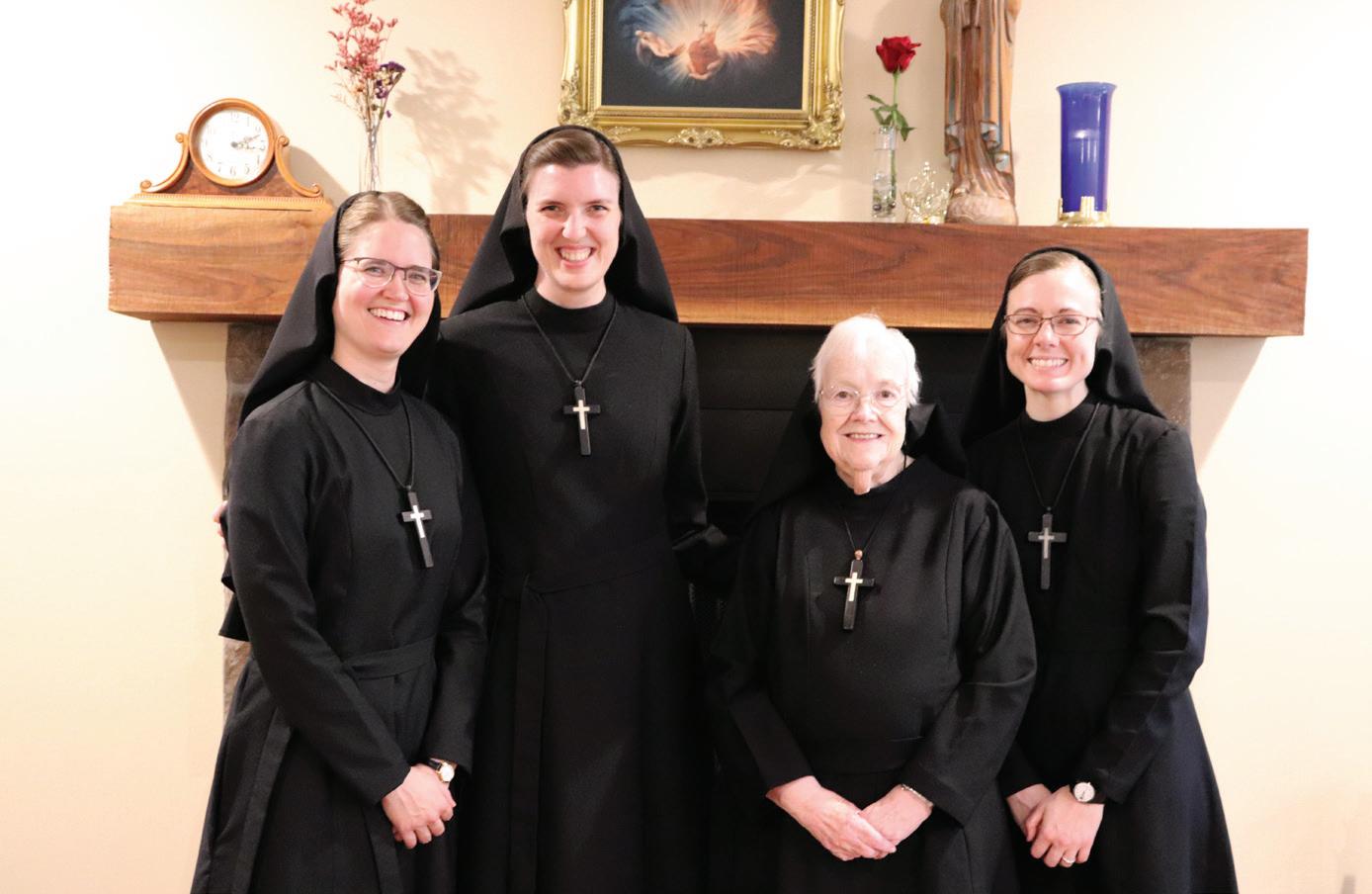 By Gabrielle Nolan
By Gabrielle Nolan
The Religious Sisters of Mercy of Alma, Mich., have entered into a jubilee year of celebration.
Sept. 1 marked the 50th anniversary of the religious order’s founding, which occurred in 1973.
Sister Mary Lisa Renfer, RSM, who serves as the superior of the Knoxville community, said the anniversary is a “time of great gratitude.”
“It’s a time to look at all the blessings of those years and to thank the Lord for where we’re at right now and to look forward to the future. I think it’s just a year of gratitude and thanksgiving for the Lord’s mercy to us,” she said.
The religious order opened its convent doors on Sept. 1 for an open house that included Mass, social time, and adoration.
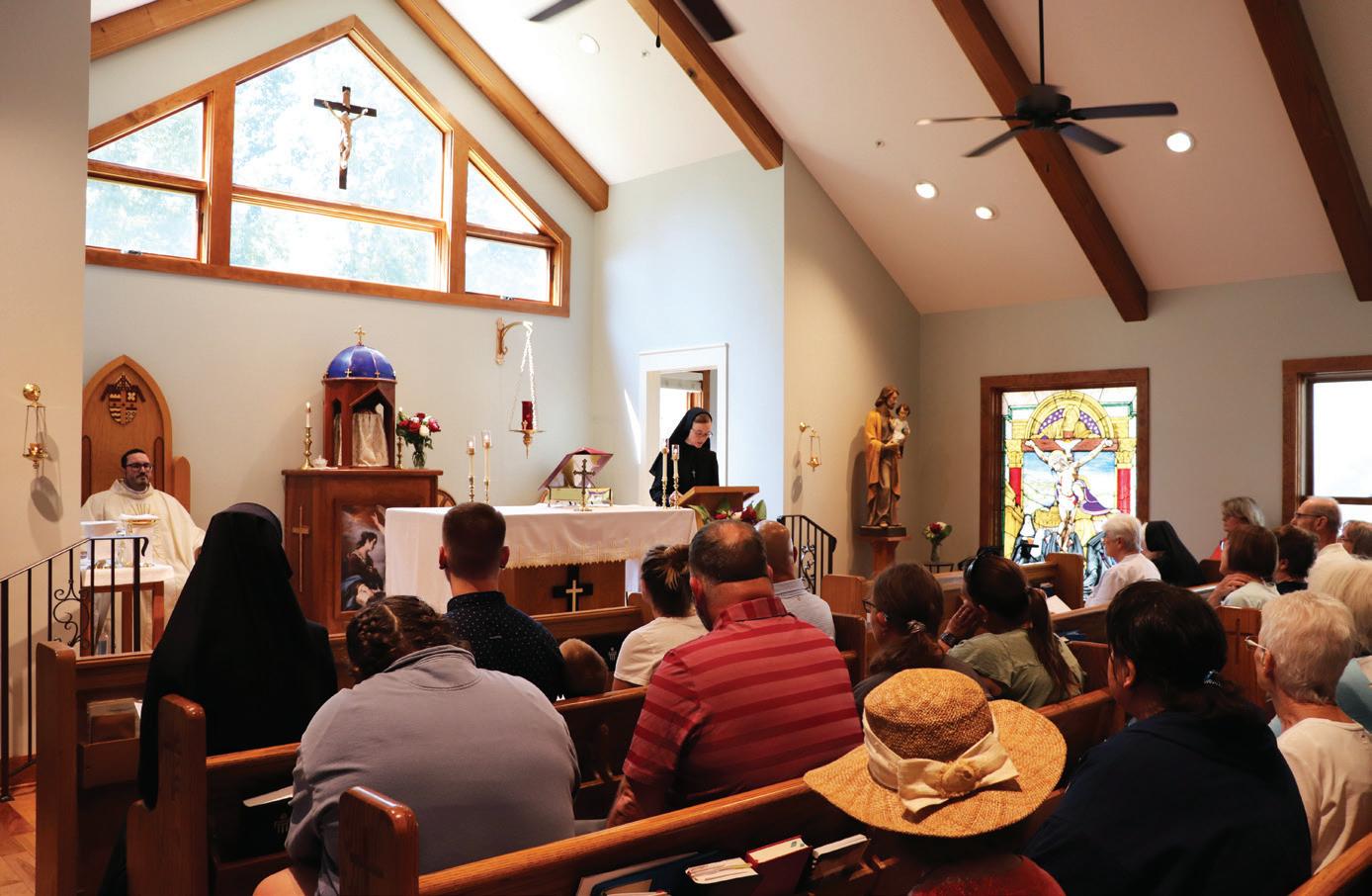
“It was nice to have a full chapel and friends from our apostolate or from over the years here in Knoxville,” Sister Mary Lisa said. “I thought it was a beautiful turnout, and I’m glad that everyone was able to come.”
Father Christopher Floersh, parochial vicar at St. John Neumann Parish in Farragut, celebrated Mass in the convent’s Mercy Chapel. Deacon Sean Smith, chancellor for the Diocese of Knoxville, served as deacon of the Word.
“I’ve often talked about the different vocations as a former vocations director, and I think about when I use different analogies, certainly marriage is the first and easiest one to describe when we speak about people who have fallen in love for 50plus years,” Father Floersh said in his homily.
“Over time, what it requires
is somebody to fall in love with every aspect of the individual,” he continued. “Marriage is the beginning of that love, and over the course of a lifetime we can say this individual truly loved their spouse because they were willing to give up their whole lives and love them in good
times and in bad, as we say, and everything that comes with it.”
“And then when I speak about people who are interested in joining the religious life or joining the priesthood … one of my questions has always been: what did you fall in love with? Perhaps it’s the beautiful liturgies,
perhaps it’s the Gospels, the understanding of Christ, all of the respective Bible. … Perhaps it’s that ministry that has been inspired by Christ to serve others. Music, beautiful architecture, art, whatever it may be, stories of the saints, hold on to that and know that that love should always be there. But in order to become a religious, in order to become a priest, in order to enter into that life, fall in love with every aspect of the Church, every single aspect,” Father Floersh shared. He noted that the celebration of the jubilee year goes beyond 50 years.
“It goes beyond that because that love is not only for the individual Sisters that we have here, the individual Sisters part of the community but also the love of the community itself, 50 years. The love of religious since has been the foundation of the Church. The brides of Christ, that love that even the communities share in, the parents, the grandparents, everyone who brought this community into existence now, who is serving us now, and that is the key, the servants, brides of Christ living out that promise as servants,” the diocesan priest said.
Father Floersh advised that anyone entering into religious life should be “scared about what you’re going to get into.”
“Be fearful because in this process you will lose yourself. You will die to yourself and everything that you love about yourself, but you will gain Christ. You will gain Christ, and you will become Christ. In other words, you will shed the sinful part of yourself and give up everything in order to love Christ fully. This is one of the most impactful things that we can all
Sisters continued on page A11
Faith-based retirement living

Enjoy your lifestyle at your pace, on top of scenic Signal Mountain



Tired of daily chores and considering a maintenance-free lifestyle? Then look no further than Ascension Living Alexian Village Tennessee. Rooted in the loving ministry of Jesus as healer, we are dedicated to helping provide compassionate care and personalized experiences




Picture living your retirement without the worry of home or yard maintenance; allowing you the ability to travel or visit your loved ones, all at your own pace. We offer a variety of living options, amenities, activities and more. Also, take comfort in knowing that you will not have to make another move, even if your health situation changes.

THE EAST TENNESSEE CATHOLIC A4 n OCTOBER 1, 2023 www.dioknox.org
GABRIELLE NOLAN
(2)
Thankful for the RSMs Above: Sister Mary Lisa Renfer, RSM, who serves as medical director for the St. Mary's Legacy Clinic, gives the reading during a Mass to mark the jubilee year for the Religious Sisters of Mercy of Alma, Mich. Below: The Religious Sisters of Mercy of Alma, Mich., include, from left, Sister Celeste Mary Poché, Sister Mary Simone Haakansson, Sister Mary Timothea Elliott, and Sister Mary Lisa Renfer, seen here at their Knoxville convent.
437 Alexian Way | Signal Mountain, TN 37377 | ascensionliving.org/AlexianVillageTN © Ascension 2023. All rights reserved. Call 423-708-4073 to scheduled your
and experience simplified living.
visit



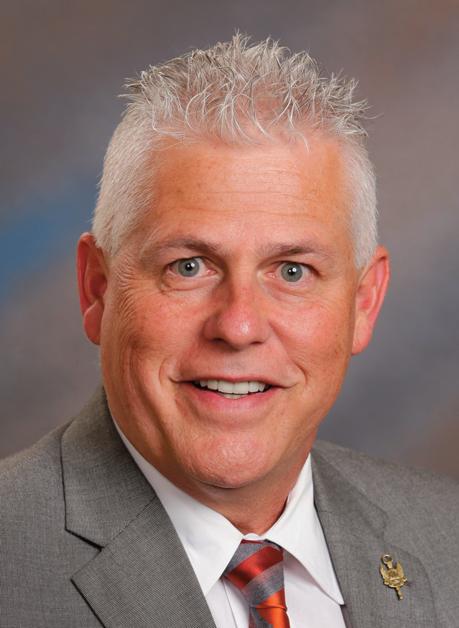

THE EAST TENNESSEE CATHOLIC OCTOBER 1, 2023 n A5 www.dioknox.org LIFE INSURANCE • DISABILITY INCOME INSURANCE • LONG-TERM CARE INSURANCE • RETIREMENT ANNUITIES © Knights of Columbus, 1 Columbus Plaza, New Haven, CT 06510 The Schachle Agency Daniel.schachle@kofc.org Chris Bivens 217-971-1812 Chris.bivens@kofc.org Josh Florea 865-335-1590 Joshua.florea@kofc.org Ron Henry 865-314-9441 Ron.henry@kofc.org Father McGivney’s founding mission was to protect the financial future of members and their families. His mission has
on for
lived
decades.
Relics of Padre Pio exposed in diocese
Faithful from East Tennessee and beyond venerate beloved Italian saint
By Dan McWilliams
Hundreds of the faithful venerated the relics of St. Pio of Pietrelcina on Sept. 26 and 27 as they were exposed first at the Cathedral of the Most Sacred Heart of Jesus in Knoxville and then the next day at the Basilica of Sts. Peter and Paul in Chattanooga.
The beloved Italian saint, more popularly known as Padre Pio, was a Capuchin friar who lived from 1887 to 1968. He is known for his devotion to long hours of prayer, a profound acceptance of suffering, and the intense scrutiny he faced from Church authorities for claims of bilocation, receiving the stigmata, and other mystical experiences.
Richard Ruyack, a representative of the St. Pio Foundation, attended the exposition of relics at the cathedral and basilica. The foundation is dedicated to the promotion of the spiritual legacy of Padre Pio and sponsors a worldwide tour of the relics. The St. Pio Foundation offered personalized devotional items for purchase by those visiting the relics at both churches.
“This tour has been going on for three years now, and we’ve been all across the country and in other countries also,” Mr. Ruyack said.
The response to the tour “has been incredible,” he added.
The tour allows those who can’t make a pilgrimage to Padre Pio sites in San Giovanni Rotundo, Italy, where the intact body of the saint lies in the St. Padre Pio Shrine, to venerate the relics. The shrine receives about 6 million visitors a year.
“People come out from everywhere” on the tour, Mr. Ruyack said. “They feel solace and a sense of well-being once they do come and venerate. We’re a not-for-profit charitable organization, where we have other works beside the relics tour, but our main function as the Pio Foundation is to bring the relics of St. Padre Pio to people who would never have a chance to travel to Italy and go to see where he was born and raised and his tomb.”
Padre Pio received the stigmata—the wounds of Christ on the cross—in 1918. The five relics that appeared at the cathedral and the basilica included a crust from one of his hands that
came from the stigmata. The other four relics were a lock of the saint’s hair, a handkerchief soaked with his sweat only hours before he died, a piece of his mantle, and a cotton gauze with his bloodstains. The handkerchief and the piece of the mantle appeared only in certain archdioceses and dioceses on the tour.
Catholics visiting the relics in East Tennessee touched rosaries and other objects to the relics.
“If you have a relic, any type of religious article, and you touch it to this relic, it becomes a third-class relic,” Mr. Ruyack said.
Padre Pio’s Italian heritage is part of what makes him perhaps the most popular saint for Catholic devotions, but “also
U.S. shrines boast massive numbers of saints’ relics
By Jim Graves OSV News


What is a saint’ s relic? A relic can be one of three things: part of the body of a saint (a first-class relic); an item, such as a piece of clothing, used by a saint (a second-class relic); or an object touched to a first- or second-class relic (a thirdclass relic).
There are multiple examples in Scripture of the benefits of relics, such as when the bones of Elisha came in contact with a dead man, and the man was raised to life (2 Kings 13:21) or when the Christians of Ephesus used handkerchiefs and cloths touched to the person of St. Paul, and they became conduits of grace to heal the sick (Acts 19:12).
While the healings came from God, the relics were His chosen means through which He acted. The fact that God chooses to use relics to work healing and miracles tells us that He wants to draw our attention to the saints as “models and intercessors” (Catechism of the Catholic Church, No. 828).
Several sites in the United States are home to vast collections of relics. The Maria Stein Shrine of the Holy Relics in Maria Stein, Ohio, is home to over 1,100 relics in 970 reliquaries representing 900 saints. It is one of the largest collections of its kind in the world. It is an active collection, as the shrine regularly makes requests for new relics from the Vatican. It is located in the Diocese of Cincinnati.
The shrine was founded in 1875, when Father J.M. Gartner entrusted his collection of relics to the Sisters of the Precious Blood. The site includes two chapels built more than a century ago and is manned by a small staff and many volunteers. One of the chapels holds many of the relics and bears the inscription over its entryway in English and German: “Enter devoutly, O pilgrim, for no place is holier than this in the new continent.”
As many as 400 people visit each month, including school groups, pilgrimages, and tours. A variety of programs is offered to introduce visitors to the lives of the saints.


To be included in the collection, Relics continued on page A15
he was alive when many of us were alive, and that seems to be for me what makes it kind of special, that he was on this earth while we were here,” Mr. Ruyack said.
The relics were exposed at the cathedral from 9 a.m. to 8 p.m., with Mass at noon. The regular noon Mass was celebrated at the basilica, and the relics were exposed afterward from 12:30 to 7 p.m. The relics of Padre Pio first toured the United States in 2017. Knoxville and Chattanooga are two of nearly 30 U.S. cities to host the relics this year.
Jennifer George of Holy Ghost Parish in Knoxville, who came into the Church about four years ago, was among the many venerating Padre Pio’s relics at Sacred Heart.
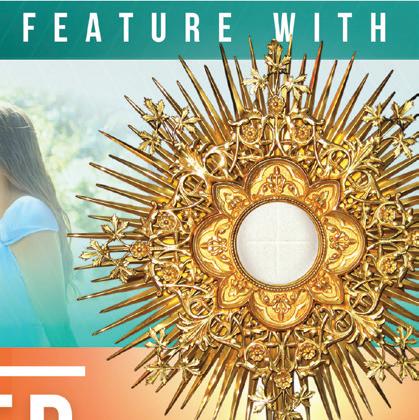

“I’m just overwhelmed. I’m shaking, but I’m so grateful. It’s just awesome—Padre Pio was something else,” she said.
Padre Pio “was a wonderful man, and I think he had a great sense of humor,” Ms. George said. “He went through a lot of troubles. He just kept on and on. I just think he was definitely a man of God.”
Cyndy Leard of St. Thomas the Apostle Parish in Lenoir City also visited the cathedral to see the relics.
“I think it’s a once-in-a-life time opportunity and a very holy and blessed experience,” she said.

Ms. Leard said she “touched my Sacred Heart medals and my scapular medal” to the relics of Padre Pio.
“He’s just a man of the people, and people can relate to him,” she said.
Father David Boettner, rector of the cathedral, celebrated the noon Mass with the relics exposed to the left of the altar steps. Concelebrating were cathedral associate pastor Father Martin Gladysz and two guest priests: Father Tomasz Szopa, rector of the St. John Paul II Shrine in Krakow, Poland, and Father Dustin Collins, pastor of St. Mary Parish in Johnson City.
“What a blessing it is to be able to gather together to pray in the presence of the relics of Padre Pio,” Father Boettner said in his opening remarks. “It’s good to be together. As we begin this Mass, I just invite you to call to mind the people you brought with you, not the ones standing next to you but the ones who are on your heart: the people you are praying for, the people you are thinking about, especially those who are struggling, those who are ill, maybe those who are alone. Bring all of those people to this celebration so that we might also draw them close in the Father’s love and recognize our role as intercessors.”
In Father Boettner’s homily, he talked about two temples and two families. The first temple is the house Catholics worship in, while the second is their bodies, which are the temples of the Holy Spirit.

The COVID pandemic led to churches suspending Mass temporarily as the faithful received Communion spiritually if not
ST. JOHN NEUMANN CATHOLIC CHURCH 633 ST. JOHN COURT KNOXVILLE,
THE EAST TENNESSEE CATHOLIC A6 n OCTOBER 1, 2023 www.dioknox.org
Feeling the presence Above: A parishioner touches her hand to the Padre Pio relic of a lock of the saint's hair at the Cathedral of the Most Sacred Heart of Jesus on Sept. 26. Below: A line of faithful forms inside the Basilica of Sts. Peter and Paul in Chattanooga to venerate the relics of St. Pio, which were on display on Sept. 27
DAN MCWILLIAMS
Padre Pio continued on page A22
chase T ckets th QR Code
Pu
TN 37934
chastity.com/purified Info: lisasinclair@gmail.com ONE DAY - TWO TALKS $25 PURIFIED A LIFE-CHANGING EVENT FOR FAMILIES (AGES 13+) GENDER & THE THEOLOGY OF YOUR BODY (AGES 13+) 3:30 - 5:00 PM
innocence of the family is under attack like never before Come and discover how to protect and heal yours This chastity presentation is for teens, parents and adults. 6:00 - 7:00 PM
the meaning of sex, gender, and the human body? The truth of masculinity and femininity are being questioned like never before. Discover how your body as a man or woman reveals your identity and calling. SUNDAY October 22, 2023 SUNDAY October 22, 2023 FREE RESOURCES FOR EVERY ATTENDEE! Dinner Break 5:00-6:00 PM (Food trucks will be available) Sacrament of Reconciliation & Eucharistic Adoration 7:00-7:30 PM
Tickets:
The
What's
COURTESY
OF THE BASILICA OF STS. PETER AND PAUL
Witnessing the culture
Schools superintendent gets acquainted with students, faculty at all 10 campuses
By Gabrielle Nolan
Mary Ann Deschaine, the new superintendent of Catholic schools, made the journey to all 10 Diocese of Knoxville schools at the beginning of the school year to get better acquainted with diocesan students and their teachers.
She visited the schools August 21-29.

“I wanted to see the people, the kids, engage with the staff and see what great Catholic school opportunities that are out there for our students,” Mrs. Deschaine said. “Each region is different, each location is different, and I want to get to know those uniquenesses of each of the schools.”
The diocese’s 10 schools include two high schools and eight elementary schools located in Chattanooga, Oak Ridge, Kingsport, Johnson City, Farragut, and Knoxville.
“It was delightful to see the students engaged in lessons, playing on playgrounds,” Mrs. Deschaine said. “They were so polite, they stood up in class when we entered, and they had manners. It was just great seeing the kids and seeing them in an educational setting that was so faith-filled and engaging.”
During her first year as superintendent, Mrs. Deschaine has a goal to get to know each individual school community and its culture.
“We’re not cookie-cutter schools; we each have our own Catholic identity in a sense, and how each school reflects that is very exciting to see,” she said. “Walking into a building, you can feel the Holy Spirit there, and it’s wonderful to participate in the Masses and see how each school celebrates who we are a Catholic community. … To see that presence of faith in our students is a true bucket-filler.”
“Supporting our students, staff,
and families on their faith journey is something I hope to be a part of,” she added.
U.S. Catholic schools see strong growth in 2023-24 academic year
By Gina Christian OSV News

As they open their doors for a new academic year, the nation’s Catholic schools are enjoying overall strong growth, along with a firm commitment to mission, experts told OSV News.

“Our school system has grown two years in a row,” said Lincoln Snyder, president and CEO of the National Catholic Educational Association.
Based in Leesburg, Va., the NCEA, an organization that traces its origins to a 1904 conference held in St. Louis, represents close to 140,000 Catholic educators serving 1.6 million students.
According to Mr. Snyder, Catholic schools in the United States on balance experienced a bump in enrollment amid the height of the COVID-19 pandemic, with 3.8 percent growth from 2021-22 and 0.3 percent growth during the 2022-23 academic year.
In addition, “most retention rates are pretty high,” Mr. Snyder said. “Dioceses last year retained 93 percent to 98 percent of students who came (during) COVID.”
The Diocese of Arlington, Va., for example, has seen a three-year rise in enrollment, with the overall student population now at 18,400 in 41 diocesan schools up 10 percent since the 2020-21 academic year.
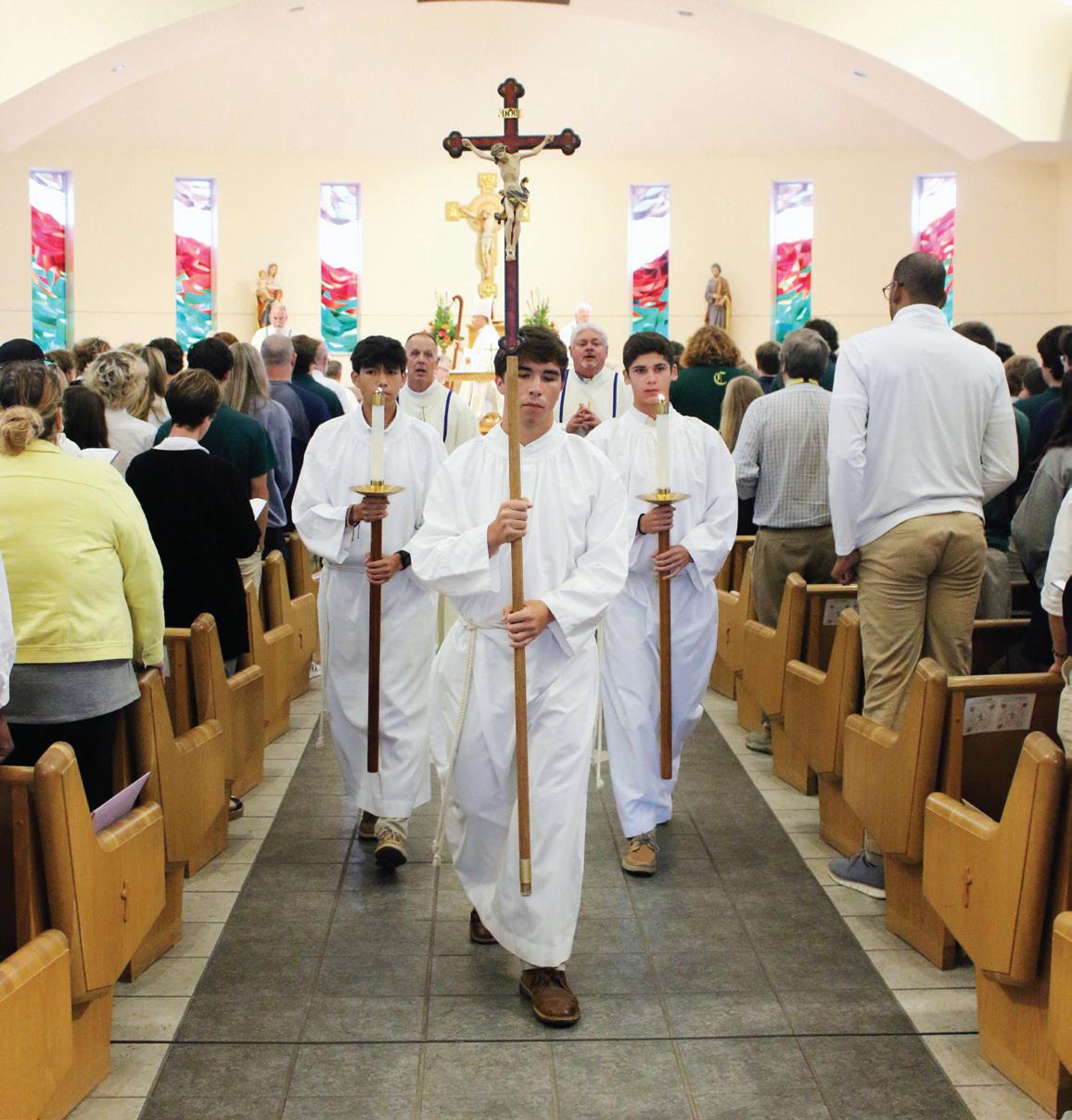
Mr. Snyder attributed such sustained growth to factors that transcended the pandemic.
“By all indications, families who came to Catholic schools were very happy with the community, and they established relationships” with the schools, he said. “Once people have children in a positive environment, they tend
not to change it.”
At the same time, some Catholic schools saw an uptick in numbers due to straightforward demographic shifts, he said.
While declines “tended to be in the Northeast and the Midwest ... most of our growth was seen in southeastern Florida, and some in the (U.S.) Southwest,” Mr. Snyder said.
“We’ve recovered from the pandemic and then some,” said Jim Rigg, superintendent of Catholic schools and secretary of education for the Archdiocese of Miami. “We have the highest enrollment in eight years, up about 3.6 percent year over year.”
One formerly closed school, St. Malachy in Tamarac, Fla., has even reopened for the 2023-24 academic year after a 14-year hiatus, he said.
Mr. Rigg cited an influx of new Florida residents as one factor in enrollment surges. According to the U.S. Census Bureau, Florida is the nation’s third most populous state, as well as the fastest-growing one.
“Substantial numbers of people move here from the northern U.S., and we have continuous waves of immigration from Latin America and the Caribbean, the majority of whom identify as Catholic,” he told OSV News.
Christopher Pastura, superintendent of Catholic schools for the Diocese of St. Petersburg, Fla., agreed. He said Florida’s “robust school-choice programs” also have worked to fill classrooms.
“Florida has moved to a 100 percent choice scholarship program, so everybody has access to that regardless of income,” Mr. Pastura said. “It’s helped our low- and middle-income folks be able to afford a Catholic school education.”
NCEA continued on page A20

Mrs. Deschaine shared that her entry into East Tennessee has been warmly welcomed.
“A couple of things that I’ve learned is that each of our schools are wonderful and faith-filled communities. I’ve enjoyed meeting the kids. Everyone’s been so welcoming and inviting. It’s been delightful to see that and experience all of that,” she said.
“The Diocese of Knoxville has a lot going on. I’m impressed with the way the school leaders work together to function as a system of schools, not a school system, in which we respect each other’s unique personality, each unique culture that they have, but they all understand that the bigger mission is for Catholic school education. I think that that’s what’s important,” she added.
Following her school visits, Mrs. Deschaine touched upon the topics of curriculum, school safety, building upgrades, and priestly support of schools.
From school to school, Mrs. Deschaine said there is a difference between the textbooks and materials being used to teach certain curriculum.
“We are working on unifying and aligning a lot of the textbooks that we are using. All of the elementary schools this year chose to utilize some of their GEER (Governor’s Emergency Education Relief Fund) funds or local funding sources, and they’re using AMPLIFY for science, and that’s in all of the elementary schools,” she noted.
Mrs. Deschaine said she was excited and pleased to see the schools’ safety plans in place.
“If it’s severe weather drills, fire drills, intruder drills, those things all of our schools are prepared for. We’ve had a lot more resource officers available in our buildings, which is a welcomed addition to our school communities,” she shared.
Seine River Cruise Pilgrimage in France


June

THE EAST TENNESSEE CATHOLIC OCTOBER 1, 2023 n A7 www.dioknox.org
Student input Above: Diocese of Knoxville schools superintendent Mary Ann Deschaine, center, talks to Notre Dame High School students during a visit to the Chattanooga school in August. Below: Knoxville Catholic High School students participate in Mass at All Saints Church at the beginning of the 2023-24 academic year. Mrs. Deschaine also visited KCHS.
For More Information Contact: Lisa Morris at 865-567-1245 lisam@select-intl.com Select International Tours at 800-842-4842 jane@select-intl.com www.selectinternationaltours.com including Paris, Giverny, Lisieux, Normandy Beaches and Rouen
STEPHANIE RICHER
an optional pre-tour to Lourdes
9-17, 2024
pre-tour to Lourdes
plus
June
Optional
5-10, 2024 CATHOLIC Schools continued on page A20
BILL BREWER
CARA study shows positive signs for belief in the Eucharist among Catholic faithful
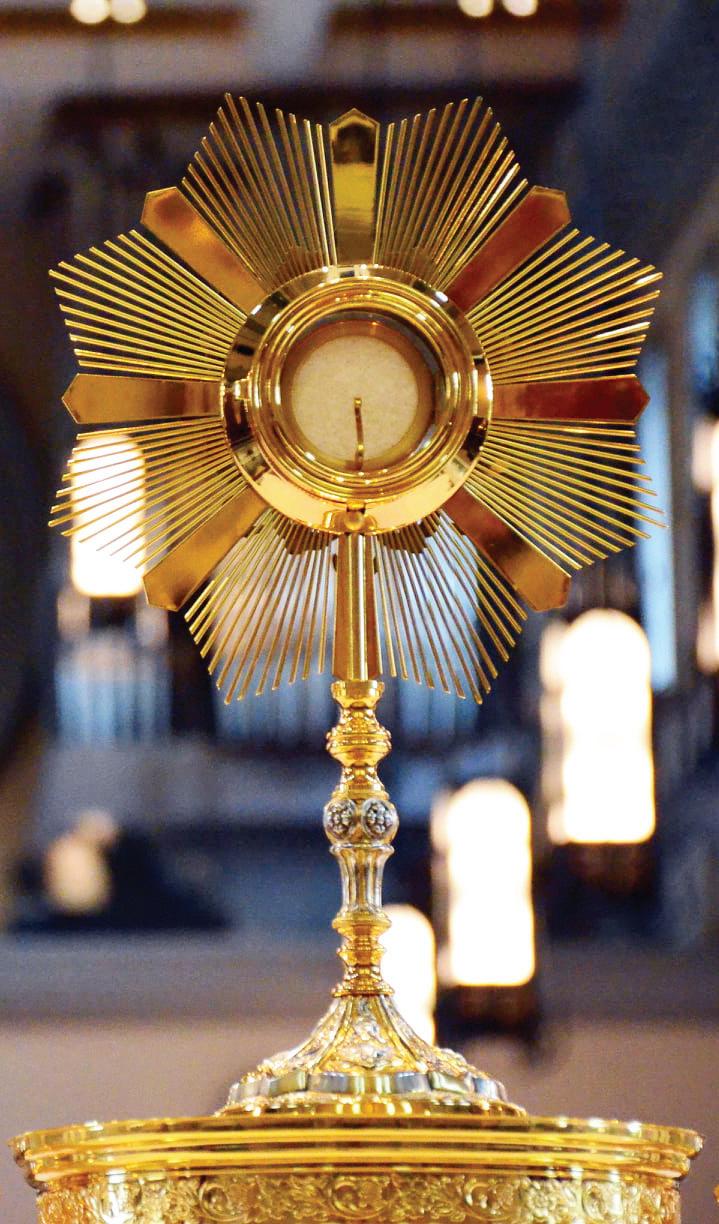
 By Maria Wiering OSV News
By Maria Wiering OSV News
Almost two-thirds of Catholics believe in the Real Presence of Jesus in the Eucharist, but only 17 percent of adult Catholics physically attend Mass at least once per week, according to a newly published survey from Georgetown University’s Center for Applied Research in the Apostolate.
The survey also revealed a high correlation between belief in the Eucharist and weekly or even monthly Mass attendance.
The 2022 survey of self-identified Catholics published Sept. 26 and titled “Eucharist Beliefs: A National Survey of Adult Catholics” found 64 percent of respondents provided responses that indicate they believe in the Real Presence, that the Lord Jesus Christ is truly present under the appearance of bread and wine in the Eucharist.
That conclusion was drawn from both openended and closed-ended questions respondents were asked about their understanding of Church teaching about the Eucharist and additional questions to clarify their beliefs.

According to the CARA study, 49 percent of respondents correctly identified that the Church teaches that “Jesus Christ is truly present under the appearance of bread and wine.” The other 51 percent incorrectly identified the Church’s teaching as “Bread and wine are symbols of Jesus’ actions at the Last Supper, meaning that Jesus is only symbolically present in the consecrated bread and wine.”
“Results of this question indicate that there is substantial confusion about what the Church teaches about the Eucharist, with slightly more adult Catholics not knowing this correctly than those correctly identifying the teachings,” the report stated.
The survey report noted the data from the responses to the questions indicated “most who do not believe in the Real Presence are not rejecting the teaching, as they do not know this is what the Church teaches.”
The survey aimed to test or clarify the findings of a 2019 Pew Research Center survey that found only one-third of U.S. Catholics agree with the Church that the Eucharist is the body and blood of Christ.
According to Pew’s analysis published in August 2019, “nearly seven in 10 Catholics (69 percent) say they personally believe that during Catholic Mass, the bread and wine used in Communion ‘are symbols of the body and blood of Jesus Christ.’ Just one-third of U.S. Catholics (31 percent) say they believe that ‘during Catholic Mass, the bread and wine actually become the body and blood of Jesus.’”
The 2019 Pew survey was part of the impetus for the National Eucharistic Revival that the U.S. Conference of Catholic Bishops launched last year, and which will include a National Eucharistic Congress in Indianapolis in July.
The initiative aims “to inspire a movement of Catholics across the United States who are healed, converted, formed, and unified by an
encounter with Jesus in the Eucharist and who are then sent out on mission ‘for the life of the world,’” the USCCB website states.
In a review of previous surveys asking Catholics about their belief in the Real Presence beginning with a 2008 American National Election Study, CARA indicated that the Pew Research Center’s phrasing for its question on the topic

may have been confusing to respondents. CARA aimed to be as clear as possible with its survey’s approach, which is why it opened with an “unaided and open-ended question”: “In your own words, what do you believe happens to the gifts of bread and wine after consecration during Mass?”
The new CARA study, while showing more Catholics believe in the Real Presence than in the Pew study, still underscores the need for the Eucharistic Revival, said Bishop Andrew H. Cozzens of Crookston, Minn., chairman of the USCCB’s Committee on Evangelization and Catechesis, which is supporting the revival.
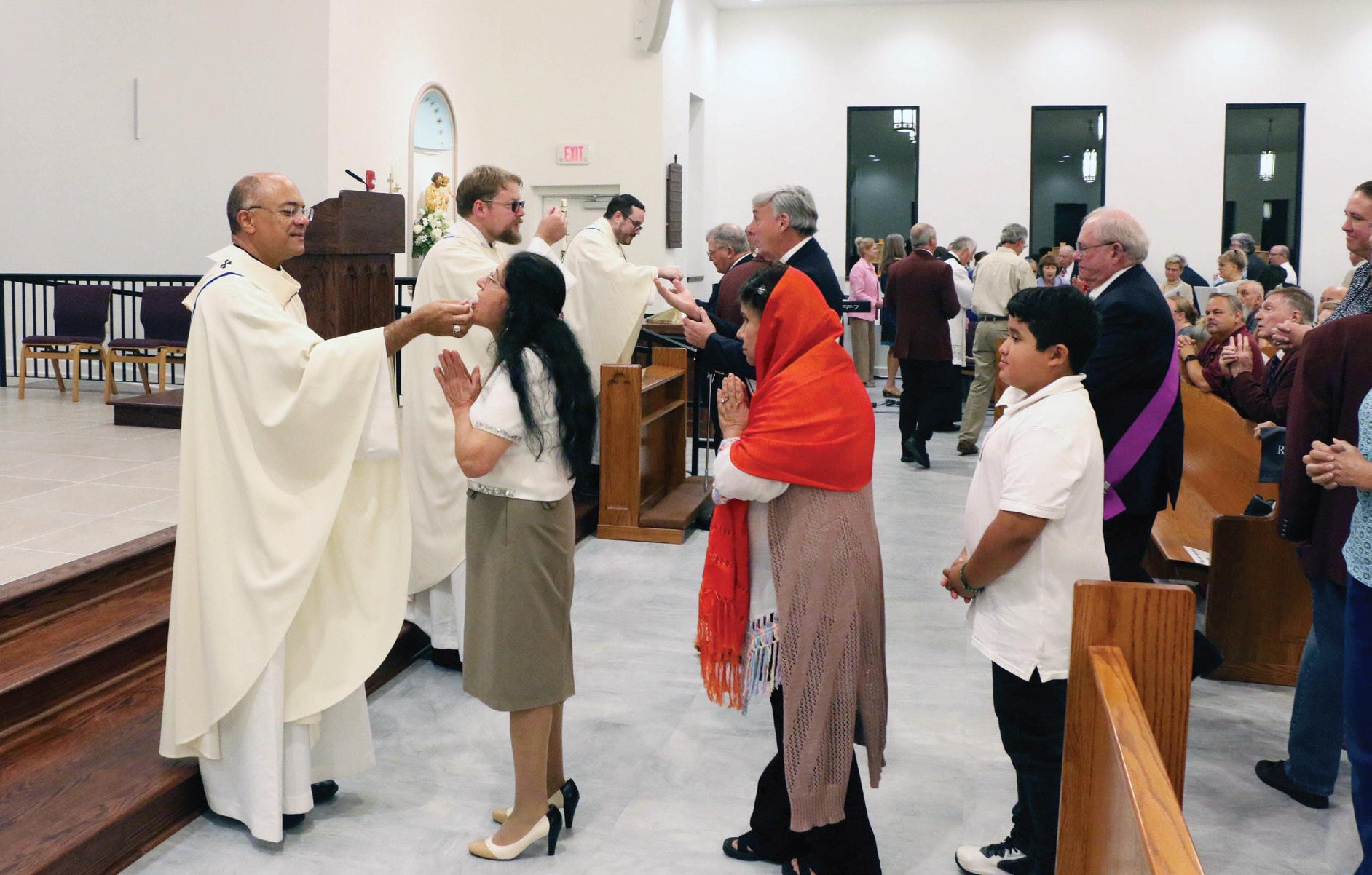
“It’s still not good news,” Bishop Cozzens, who also serves as board chairman of the National Eucharistic Congress nonprofit formed in 2022 to plan the national event, told OSV News. “What it reveals is that there’s ... people who say they believe in the Eucharist, but they don’t go to Mass. In that sense, they obviously haven't had a real encounter with Jesus in the Eucharist.”
“This is what we’re about with the Eucharistic Revival, this encounter with Jesus in the Eucharist that lets me realize He’s a living person and that changes the way I live,” he continued. “That’s what we really need.”
The survey, however, “might actually show us we have more low-hanging fruit than we thought we did,” he said. “In other words, there are people who say they believe in the Eucharist, but they don’t go to Mass every week. ... How do we invite them into an encounter with Jesus in the Eucharist so that their lives can be changed?”
The survey found that knowledge of the Church’s teaching on the Eucharist and belief that teaching is true is highest among Catholics CARA continued on page A19
THE EAST TENNESSEE CATHOLIC A8 n OCTOBER 1, 2023 www.dioknox.org
Reversing the trend
Real and present Archbishop Shelton J. Fabre, left, is joined by Father Mark Schuster, center, and Father Christopher Floersh in distributing Communion at St. Alphonsus Church in Crossville.
Give Thanks, Give Hope, Give Catholic! Join us this Giving Tuesday, November 28, to give back to parishes, schools, and Catholic ministries right here in East Tennessee! Learn More at Knoxville.igiveCatholic.org
BILL BREWER
Commit ted to Catholic Education
"There is an incomprehensible comfort to be able to send your children to a school that offers consistent exposure to Christ, mirrors what is being taught at home, and weaves the love of God into the very fabric of everything taught each day.

One where teachers and leaders are moral role models and encourage children to understand the world and their actions as extensions of God’s presence within themselves. These are gifts freely given and poured bountifully into our children by schools in the Diocese of Knoxville."


Your Commitment Changes Lives
Commit to changing lives with your donation by visiting: or scanning the QR code

https://dioknox.org/schools-collection














Catholic Schools Second Collection weekend: November 11-12

THE EAST TENNESSEE CATHOLIC OCTOBER 1, 2023 n A9 www.dioknox.org
-Parent of children currently receiving tuition assistance through the generosity of donors like you.
2023
Pope asks new cardinals to join Church ‘symphony ’
‘Red hats ’
By Cindy Wooden Catholic News Service

from 16 nations called on to listen to God and one another
Coming from different parts of the world and having different experiences and talents, members of the College of Cardinals are called to create a “symphony,” listening to one another and to the Holy Spirit, Pope Francis said.
The pope used the biblical story of Pentecost to remind the prelates of the roots of their faith, and he invoked the image of a symphony to emphasize their call to be both faithful and creative as he created 21 new cardinals from 16 nations on Sept. 30.
On a warm autumn morning, with shrubs and flowers decorating the steps of St. Peter’s Basilica, Pope Francis held his ninth consistory to create new cardinals. The Vatican said 12,000 people attended the ceremony.
Cardinal Robert F. Prevost, the 68-year-old Chicago-born prefect of the Dicastery for Bishops, was the only U.S. prelate to receive his red hat at the consistory. He was joined by French Cardinal Christophe Pierre, the 77-year-old nuncio to the United States.
Cardinal Luis Pascual Dri, a 96-year-old Capuchin friar from Argentina, was made a cardinal when the pope proclaimed his name at the consistory, but he did not travel to Rome to receive his red hat because of his health.
With the consistory, the College of Cardinals has 242 members from 91 nations, according to Vatican statistics; 137 of the cardinals are under the age of 80 and eligible to vote in a conclave to elect a new pope. The socalled “cardinal electors” come from 71 countries.
Italy with 49 cardinals, of whom 14 are electors continues to dominate the cardinal counts. The United States is second; according to the Vatican, there are 17 U.S. cardinals, including 11 electors. The total is 18 when counting Italian-born Cardinal Silvano Tomasi, a former Vatican official, who is a U.S. citizen.

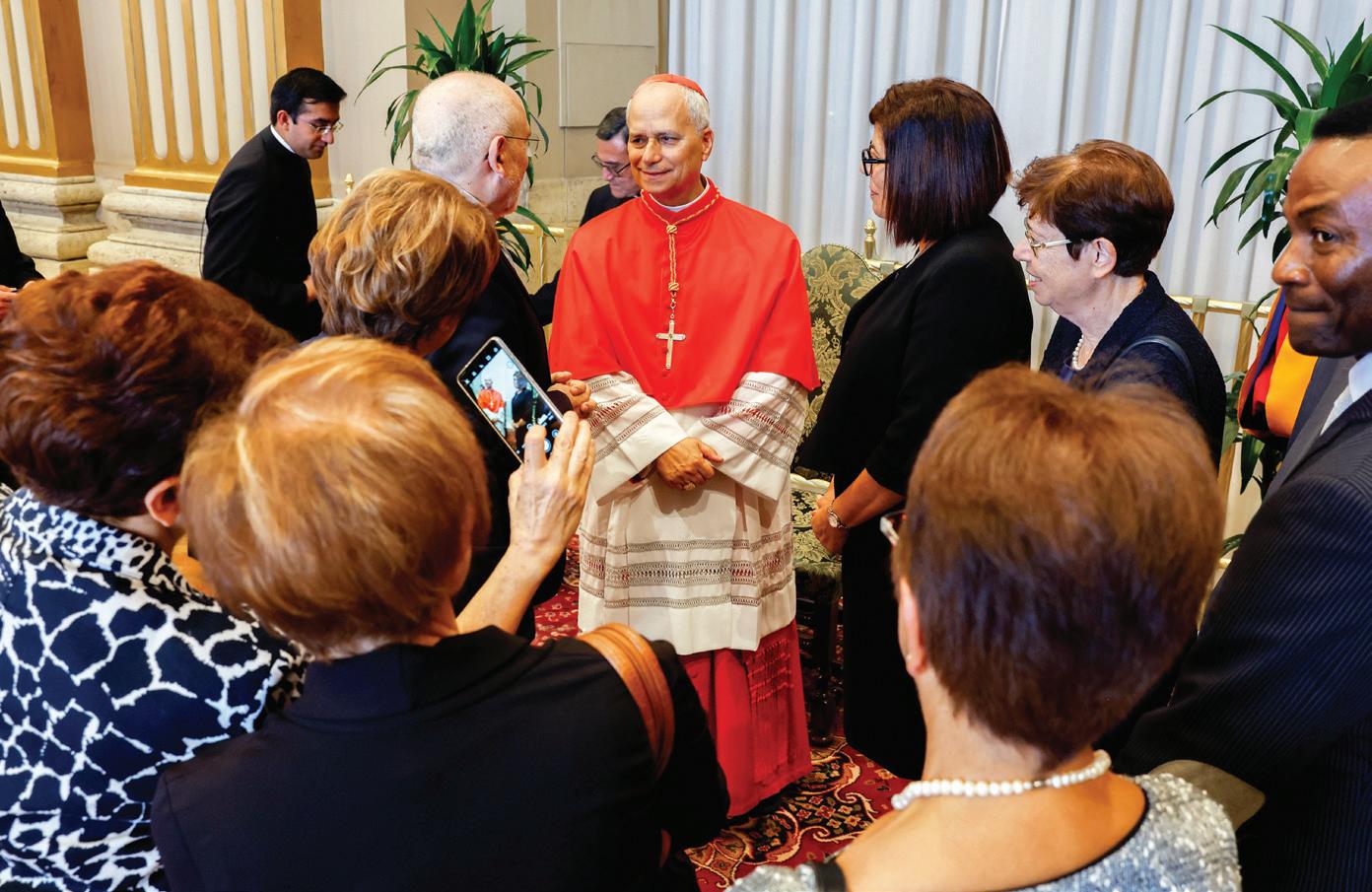
At the beginning of the ceremony, Cardinal Prevost thanked Pope Francis on behalf of the new cardinals, noting how the consistory was taking place just before the opening of the assembly of the Synod of Bishops on synodality.
“The Church is fully such only when it truly listens, when it walks as the new people of God in its wonderful diversity, rediscovering continually her own baptismal call to contribute to the spread of the Gospel and the kingdom of God,” Cardinal Prevost said.
“The beauty of the universality of the Church that will be manifested in the unfolding of the synod will be a very important sign, which will be able to speak of the mission that all of us baptized have received, in communion with the successor of Peter and in the profession of the same faith,” he added.
Before receiving their red hats, their cardinal rings, and the names of their titular churches in Rome an assignment that makes them formally members of the clergy of the Diocese of Rome the new cardinals made a profession of faith, reciting the Creed in Latin, and made an oath of fidelity to Pope Francis and his successors.
Cardinal Prevost, a former superior general of the Augustinian religious order, was given the Church of St. Monica, mother of St. Augustine.
In his homily at the consistory, a prayer service that lasted just over an hour, Pope Francis drew the prelates’ attention to
"We have the Holy Spirit as our master: the interior master of each one of us and the master of walking together. He creates variety and unity; He is harmony itself."
the Pentecost story in the second chapter of the Acts of the Apostles and particularly to its listing of those who heard the Apostles, each in their own language although they were “Parthians, Medes, and Elamites, inhabitants of Mesopotamia, Judea and Cappadocia, Pontus, and Asia.”
“Normally we pastors, when we read the account of Pentecost, identify ourselves with the Apostles,” the pope said. But if the cardinals recognize themselves as members of the crowd, he added, they would “rediscover with amazement the gift of having received the Gospel” in their own languages and would give thanks for having been evangelized among their own people, often by their mothers or grandmothers.
“Indeed, we are evangelizers to the extent we cherish in our hearts the wonder and gratitude of having been evangelized, even of (still) being evangelized, because this is really a gift always present, that must be continually renewed in our memories and in faith,” the pope told the newest members of the College of Cardinals.
In humility, and with that diversity, he said, “the College of Cardinals is called to resemble a symphony orchestra, representing the harmony and synodality of the Church.”
Pope Francis said he referred to “synodality” not only because the synod assembly opened in Rome on Oct. 4, “but also because it seems to me that the metaphor of the orchestra can well illuminate the synodal character of the Church,” which relies on each member making a contribution, occasionally as a soloist, but usually in harmony with others.
“Mutual listening is essential,” he said. “Each musician must listen to the others. If one listens only to himself, however sublime his sound may be, it will not benefit the symphony; and the same would be the case if one section of the orchestra did not listen to the others, but played as if it were alone, as if it were the whole.”
— Pope Francis
“In addition,” the pope said, “the conductor of the orchestra is at the service of this kind of miracle that is each performance of a symphony. He has to listen more than anyone else, and at the same time his job is to help
Joining the symphony
Above: Before receiving their red hats, called birettas, new cardinals stand before Pope Francis to make their public profession of faith and to promise obedience to the pope and his successors at a consistory in St. Peter's Square at the Vatican on Sept. 30.

Left: Chicago-born Cardinal Robert F. Prevost, prefect of the Dicastery for Bishops, greets well-wishers in the Apostolic Palace at the Vatican after a consistory where Pope Francis made him and 20 other prelates cardinals on Sept. 30.
each person and the whole orchestra develop the greatest creative fidelity: fidelity to the work being performed, but also creative, able to give a soul to the score, to make it resonate in the here and now in a unique way.”
“We have the Holy Spirit as our master: the interior master of each one of us and the master of walking together,” Pope Francis said. “He creates variety and unity; He is harmony itself.” ■
Danube River Cruise

Including Munich, Vienna, Bratislava, and Budapest
plus an optional extension to Krakow
11 Day Cruise and Land

October 20-30, 2024




Krakow Extension
Oct. 30-Nov. 3, 2024

THE EAST TENNESSEE CATHOLIC A10 n OCTOBER 1, 2023 www.dioknox.org
CATHOLIC NEWS SERVICE PHOTO/VATICAN MEDIA
NEWS SERVICE
CATHOLIC
PHOTO/LOLA GOMEZ
For More Information Contact: Lisa Morris at 865-567-1245 lisam@select-intl.com jane@select-intl.com selectinternationaltours.com
Dr. Marcellino D’Ambrosio Fr. Tim Nolt, Fr. Casey Jones, Fr. Rick Stansberry, Fr. Bry Shields, and Deacon Pete Markwald
with
CATHOLIC
Evening Prayer, the office for the dead for the season of ordinary time. During the evening’s session, participants recited hymns, antiphons, psalms and intercessions, and listened to a reading and prayers.
Archbishop Kurtz delivered the homily at the beginning of the Closing Session.
“Dear friends, this day is a historic day. Not only in the life of the city of Chattanooga, but most especially in the life of this Basilica of Sts. Peter and Paul, and also in the life of the Diocese of Knoxville and the life of the Church,” Archbishop Kurtz said.
He gave thanks to Archbishop Shelton J. Fabre, apostolic administrator of the Diocese of Knoxville, who could not be in attendance.
“I begin by saying a word of thanks to Archbishop Shelton, the archbishop and metropolitan of Louisville and the administrator of the Diocese of Knoxville, for his gracious invitation for me to come to be his celebrant and stand in his place,” Archbishop Kurtz said.
Archbishop Kurtz also thanked Father Carter and Deacon DeGaetano, who “had the gift of taking the first step” with Father Ryan’s cause.
“Now if I began to thank other people, we would be here until tomorrow morning because legion are the number of people who have brought us to this blessed occasion,” Archbishop Kurtz said.
He asked those in attendance to look at the front cover of their programs.
“Today is a very important step in the life of a road toward canonization,” he said. “Father Carter told me that the officials in Rome said remember when you give an image of Patrick Ryan, do not put a halo on his head yet. But this is a very, very important day.”
Archbishop Kurtz acknowledged the table near the altar that held the nine volumes of pre-sealed documentation to be sent to the Holy See.
“Those of you who see the bound versions of the final study for the cause know that it’s just a page or two shy of 2,000 pages. An exhaustive study required by the Church if we are to present someone to the Vatican for canonization,” the archbishop shared.
The documents for the inquiry included 1,891 pages. Three copies were required; one copy will remain in the Diocese of Knoxville archives collection, while the other two copies have been sent to Rome. Because of the three copies, there was a total of almost 6,000 pages.
The volumes included procedural documents involving decrees and appointments from Roman officials and the ordinary of Knoxville, oaths from nominees, and letters from the local officials of the Cause for Sainthood, required for each step of the Inquiry in the Diocese of Knoxville; testimony from witnesses about Father Ryan’s reputation of holiness; testimony from historical witnesses knowledgeable about Father Ryan and the yellow fever epidemic; and testimony from witnesses of intercessory favors of Servant of God Father Patrick Ryan.
The majority of the work consists of the His-
torical Commission Report, including archived historical documents about the life and times of Father Ryan and his priesthood, the Dioceses of Nashville and Knoxville, the yellow fever epidemic of 1878, and archive images of people he knew. Also included is evidence of the devotion to Father Ryan within the Diocese of Knoxville. Father Ryan was pastor of Sts. Peter and Paul Parish from 1872-78. When the yellow fever epidemic of 1878 spread to Chattanooga, the diocesan priest ministered to those who fell ill from the contagion. While serving the sick and needy, he contracted the dreaded disease and died on Sept. 28, 1878.
Archbishop Kurtz addressed the reading from St. Paul’s first letter to the Corinthians, chapter 15.
“Immediately after [Paul] speaks in that passage of the resurrected body, says, as you heard, these few verses: ‘O death, where is your victory? O death, where is your sting? The sting of death is sin, and the cause of the sting of death is the law.’ But thanks be to God for the victory of Jesus Christ. The canonization of a person is about witnessing to the victory of Jesus Christ over sin and death. And so, we come before us with the life of Father Patrick Ryan,” the archbishop said.
Archbishop Kurtz mentioned that before the ceremony began, he had the privilege of watching the premiere showing of “Father Ryan: A Higher Call” on the Eternal Word Television Network in the parish hall. The docudrama, which had previous showings around the diocese, was featured on EWTN on Sept. 28 as the date
marked the 145th anniversary of Father Ryan’s passing.
The archbishop asked that Father Carter and the two architects of the film, husband-and-wifeduo Marc Aramian and Veronica DiPippo, to raise their hands.
“We want to thank you for the great, great gift that you have given us. And those of you who have not seen that hour program that was just on EWTN, you’ll have sleepless nights until you finally see what a great gift we have,” the archbishop said. “It tells a wonderful story. It’s the story of a young man who was born in Ireland in poverty. He’s a young man who came to the United States, ended up feeling the call by God to become a priest. And indeed was ordained a priest for the Diocese of Nashville, served in Clarksville, Tenn., and then was assigned, I believe in 1872, to become the pastor of Sts. Peter and Paul Church, not yet a basilica. And during the six years in which he served, he made great, great friends and admirers.”
“Now the question is,” the archbishop continued, “did he reflect a conviction of the victory of Jesus Christ over sin and death? When he was confronted with yellow fever and you know how many people in 1872 died here in Chattanooga of yellow fever he did not flee from the ravages. Instead, he ministered to the people he was called to serve. Now some might say, cynically, well maybe he served in order to promote himself, to show himself the heroic one, to show himself good in the eyes of others. And that’s why we have 2,000 pages of testimony. To let us know, and my belief after studying and reading, is that the cause of canonization will move forward, and it will move forward we hope and pray because of three things.”
Archbishop Kurtz focused on the characteristics of heroic, holy, and humble.

“We celebrate, first of all, the gift of a hero. The heroic action of someone who sees a need to do something well, knows the fears and the risks involved and nevertheless goes forward. We’re told that the famous actor, John Wayne, some of you would remember John Wayne, he said that courage is being afraid but still getting on the horse,” the archbishop shared. “I was reflecting, and I thought to myself, did he not find his heart and soul filled with fear? Was he not aware of those who were dying all around him? And yet, he began to go door-to-door to the homes of people, many of whom were deathly poor and deathly sick, in order to minister to them. And as Father Carter said in the docudrama today, to be able to bring the sacraments of Christ to others. He was heroic.”
“Secondly, we honor him because he was not only heroic, but he also in his own blessed way was someone who showed holiness, who showed a love of Christ and a love and a desire to follow Christ as a saint. He did so in the manner in which he not only prayed but also conveyed the sacraments to those in need and those who are distant.”
“And the last H, humility. There is no record,
Father Ryan continued on page A21
Reading with authority Sister Mary Timothea Elliott, RSM, a Scripture scholar, gives the reading during Mass to mark the 50th anniversary of the Religious Sisters of Mercy of Alma, Mich.
Sisters continued from page A4
follow, cer tainly the examples of the brides of Christ but also the example of the Christian life. We can give up ourselves, all of the pain, all of the suffering, give all of that up and allow Christ to take it, even the good parts that we love about ourselves,” he said.
Father Floersh concluded his homily by saying that more individuals will continue to join the Religious Sisters of Mercy of Alma, Mich., because of “the love of God.”
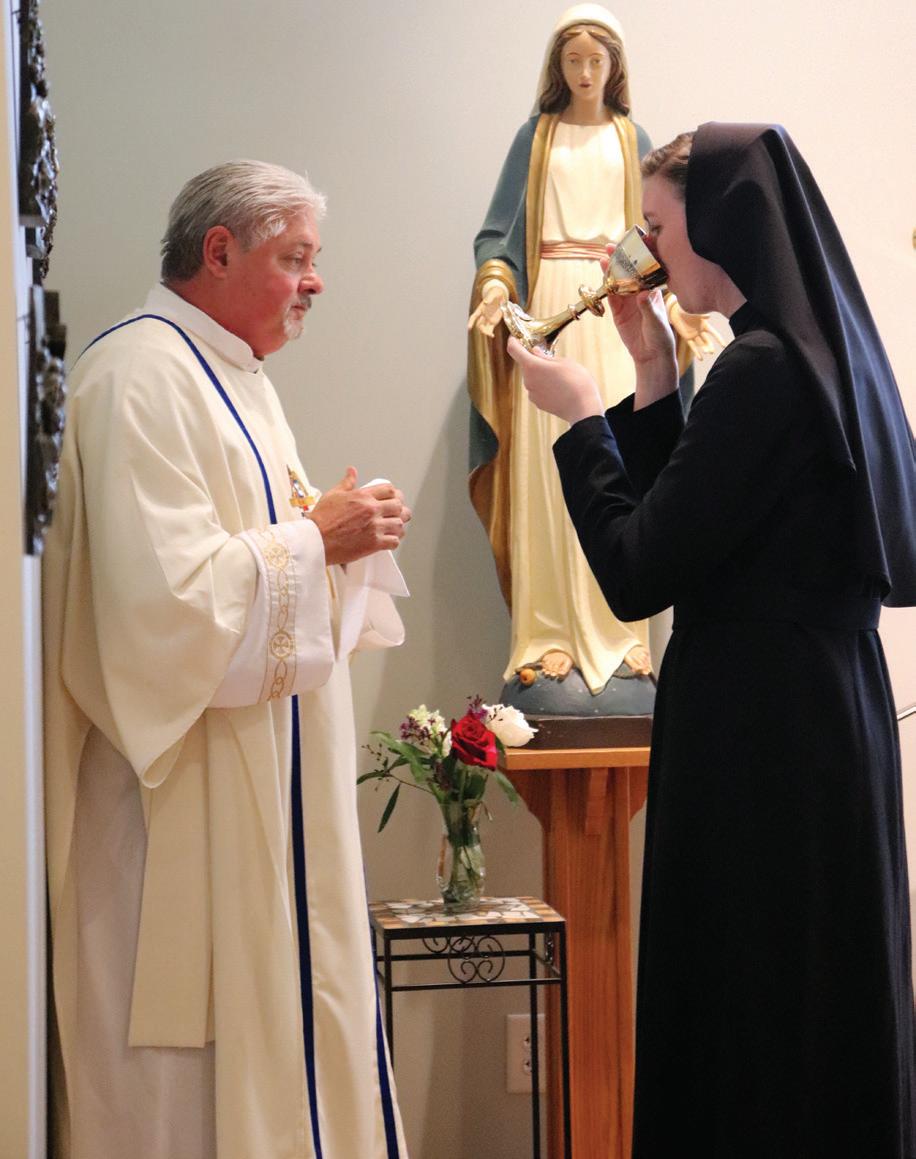
“This is what we’re celebrating, 50 years of true and stable and loving community that has served our diocese, that has served dioceses all over the world, this kind of commitment to God is who we are celebrating,” he said.
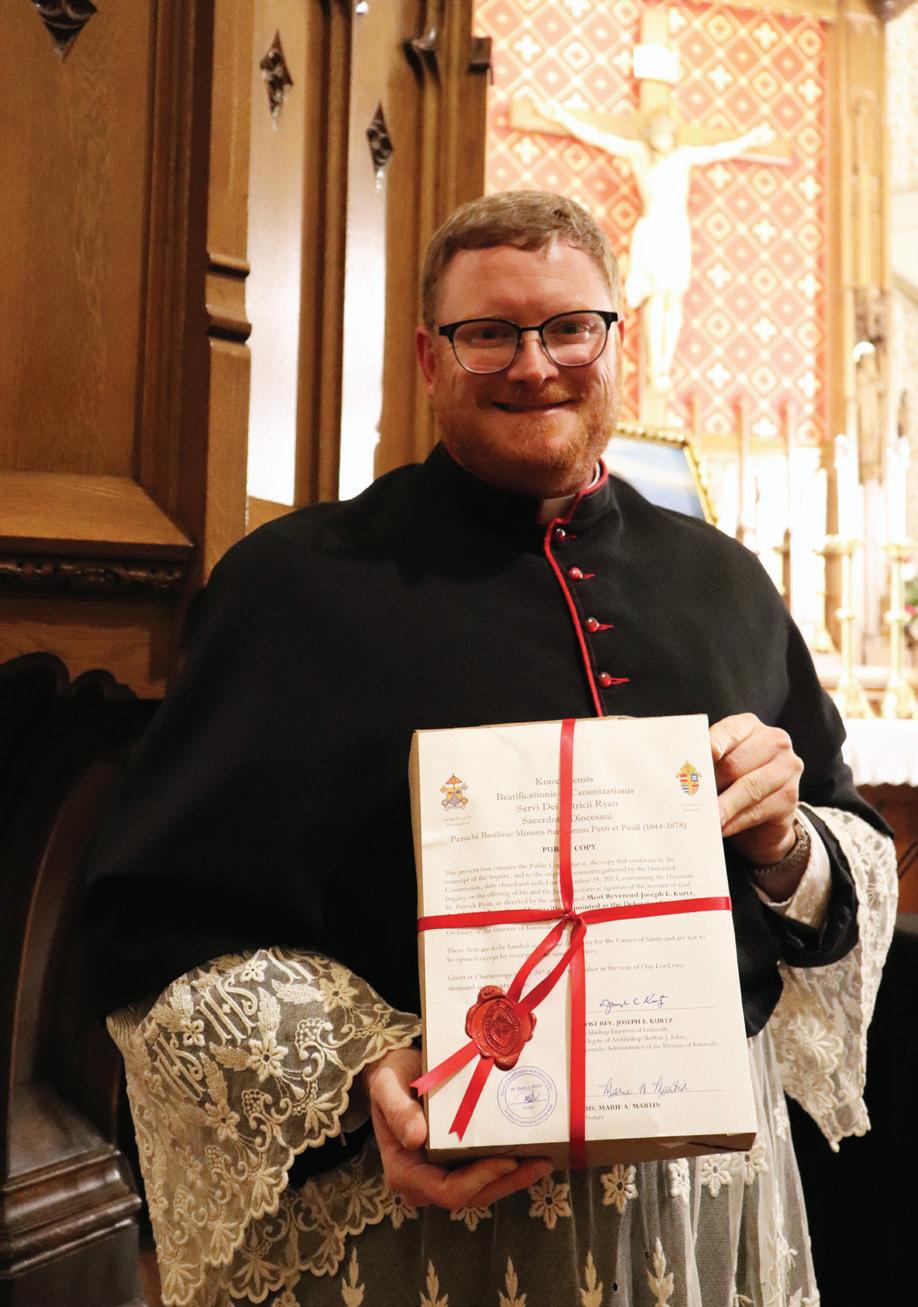
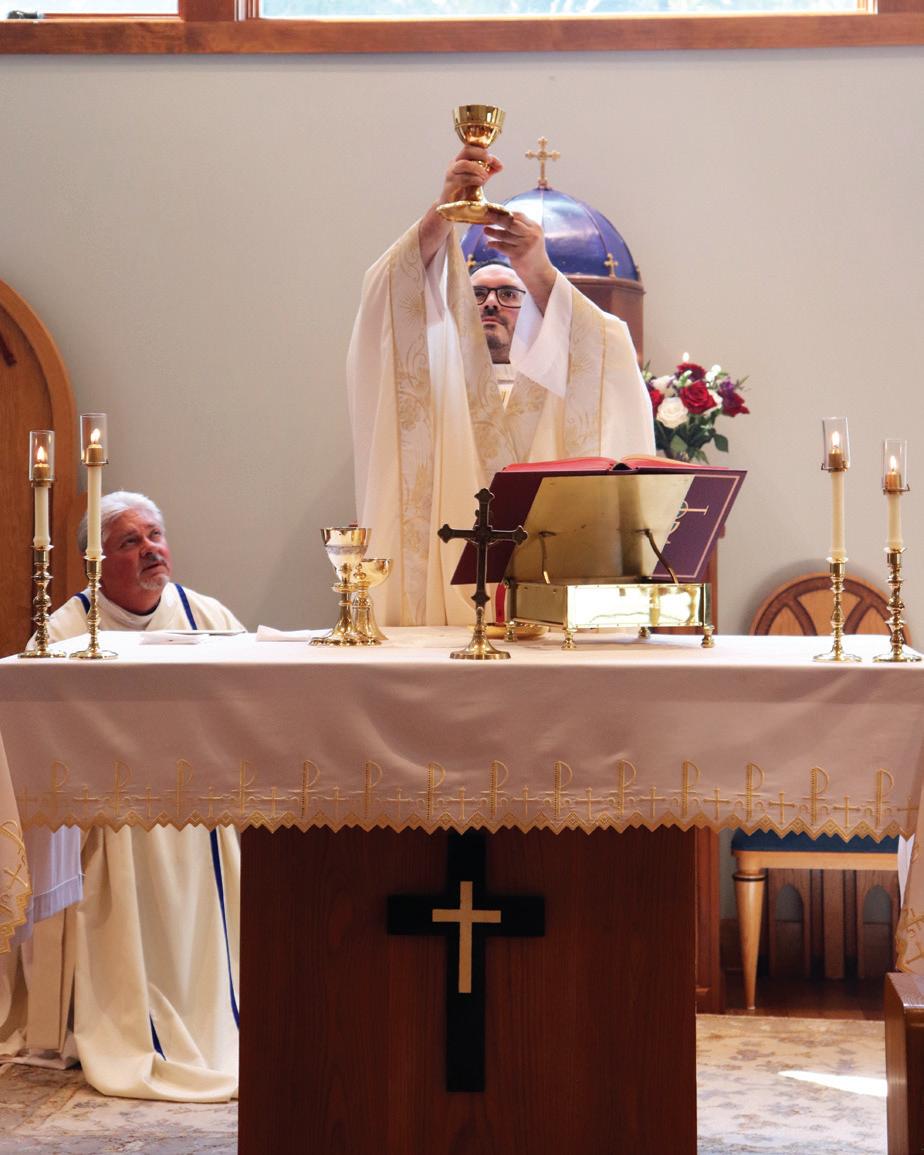
Sister Mary Lisa noted that for anyone who prays in their Mercy Chapel during the jubilee
year, there is a gift of a plenary indulgence.
“I think particularly for our diocese in this time of transition, it’s a time of particular prayer,” she said. “We’re hoping that this can be an opportunity for grace for the people of the diocese, so we’re just encouraging people to come and pray with us. For us, too, we’re looking forward to that time of grace and growing together as a local community.”
Members of the diocese are welcome to pray in the Mercy Chapel on any Saturday for either individual prayer or to join the Sisters’ holy hour, which takes place at 5 p.m. on Saturdays. Those interested should contact the Sisters to let them know they are coming.
Janette Irwin, who attended the open house with a neighbor who invited her, said it was a “wonderful day.”
“It feels like I’m with family when I’m with them, and I could understand how there is so much mercy and kindness that is shown through these Sisters. I love them,” Ms. Irwin said.
She said that she thinks the religious Sisters bring hope to the diocese.
“I think because they’re here and they’re reaching out to the less fortunate, I think that they are what we need as Catholics; we need to do that also,” she said.
For anyone interested in praying in the Mercy Chapel at the Knoxville convent, contact the Religious Sisters of Mercy at knoxville@ almamercy.org or call the Knoxville convent at 865-690-9266.
For more information on the Religious Sisters of Mercy of Alma, Mich., visit their website at almamercy.org ■
THE EAST TENNESSEE CATHOLIC OCTOBER 1, 2023 n A11 www.dioknox.org
GABRIELLE NOLAN (3)
New and eternal covenant Father Christopher Floersh celebrates the anniversary Mass for the Religious Sisters of Mercy of Alma, Mich., at the Sisters' convent in Knoxville on Sept. 1.
Take and drink Deacon Sean Smith, Diocese of Knoxville chancellor, gives Communion to Sister Mary Simone Haakansson, RSM, during the golden jubilee Mass for the Religious Sisters of Mercy.
Father Ryan continued from page A1
GABRIELLE NOLAN
Testimony to a life of virtue Father David Carter, rector of the Basilica of Sts. Peter and Paul, holds a copy of the official documentation on the life and ministry of Father Patrick Ryan. The documents are being sent to the Holy See in Rome.
associate pastor of the Cathedral of the Most Sacred Heart of Jesus.
Religious Sisters of Mercy of Alma, Mich., also were present.
Father Jim Harvey, pastor of Holy Trinity in Jefferson City, was remembered at the dedication Mass in Cumberland County for launching the building project. He served as St. Alphonsus pastor from December 2006 to 2011 and again from 2014 to 2021. Father Schuster succeeded him.


The new $2.2 million church was designed by architect Phil Adams of J&S Construction in Cookeville, also the contractor for the project as well as the original builder of Liguori Hall. Parishioners helped work on the interior of the building. The nave of the church seats more than 300. The new worship space, which sits in front of the parish life center, is some 8,000 square feet including a covered porch, or portico. It also has a cupola and a bell tower.
Worshiping in a new way
The dedication ceremony began with the servers, concelebrating priests, deacons, Archbishop Fabre, and the parishioners processing from Liguori Hall to the front doors of the new church. They sang Psalm 122, “Let us go rejoicing to the house of the Lord” as they went.
John Gray, co-chair of the parish building committee with Angelo Farrugia, presented the church blueprints to Archbishop Fabre.
“Archbishop, the architecture captures the rich tradition of our Catholic heritage,” Mr. Gray said.
The archbishop then uttered the words of Psalm 100:4.
“Enter the gates of the Lord with thanksgiving, His courts with songs of praise,” he said.
Father Schuster knocked twice on one of the front doors, and they were opened from within by parish Knights of Columbus St. Bernard Council 8152 Grand Knight John Peaslee.
“I got to knock on the door. That might be the last time I get to knock on that door,” Father Schuster quipped after Mass.
The celebrants and parishioners entered the church singing “To Jesus Christ, Our Sovereign King.”
Inside the church, Archbishop Fabre blessed the water for sprinkling the people as a sign of repentance and as a remembrance of baptism. He then passed through the church, sprinkling the people, walls, and altar with holy water.
The readings from Nehemiah 8 and 1 Corinthians 3 were proclaimed by Joe Rummel and Cindy Andrews. Deacon Minneci read the Gospel from Matthew 16.
“My dear friends in Christ, what a joy and an honor it is for me to be here to celebrate with you the dedication of this new church for this faith community of St. Alphonsus in Crossville,” Archbishop Fabre said as he began his homily. “I sincerely, sincerely congratulate you on this accomplishment, and I thank you for your enduring faith and for the prayerful and financial sacrifice of this parish community that brought the dream of this new church building to fulfillment.
“I congratulate your good pastor, Father Mark Schuster, your deacon, Peter Minneci, and all who served in parish leadership in their ongoing efforts to bring this church building to reality. What a fantastic job you have all done for the Lord and this parish family.”
The archbishop has a connection to the Crossville parish patron.


“I must also share with you that the first parish I served in as a newly ordained priest was St. Alphonsus in Greenwell Springs, La.,” he said. “Therefore, I do feel very close to your patron saint. This increases the joy I have in being present to dedicate this church under the patronage of St. Alphonsus, a great moral theologian and the founder of the Redemptorist priests and brothers. Through the intercession of St. Alphonsus, may this faith family always know God’s enduring presence and
abundant blessings.”
As a young boy growing up in New Roads, La., the future archbishop attended St. Augustine Church in his hometown.
“I can remember as a child that each time my mother, and indeed many others, would pass in front of the church or any Catholic church, by car or on foot, she would make the sign of the cross,” he recalled. “Intrigued as a child, I once asked my mom why she did this, and she said it was out of reverence for the Eucharist present in the church and as a reminder of all that the church building proclaimed by its presence.”
The archbishop adopted the practice himself.
“From that point forward, each time I pass in front of what I know to be a Catholic church, I try to remember to make the sign of the cross out of reverence for the Eucharist housed there and as a reminder of all that the church proclaims and reminds me by its presence.”
His boyhood church’s location prompted another reason to per-
form the sacramental.
“I must also state that St. Augustine Church is very near to a traffic signal in the town,” Archbishop Fabre said. “It surprised me how many times I myself or others nonetheless made the sign of the cross while attempting to clear the traffic signal before, or even just after, it turned red. Even in situations of temptation to run the traffic light, or giving in to running the light, the church nonetheless reminded us of what was the right thing to do.”
His mother’s actions as she passed a Catholic church “serve as a constant reminder that Catholic church buildings are important structures,” the archbishop said. “In all that is going on in our lives and our world, church buildings are one reminder of our covenant relationship with God, a covenant relationship that we must constantly nurture and surrender to in our words and actions.”
In the first reading at the dedication Mass, Ezra reads from the Book of the Law. The people assembled weep “because they hear
the promises made to God in their relationship with the Lord” and “realize how far they have strayed from what they promise,” Archbishop Fabre said.
At the end of the reading, Ezra, Nehemiah, and the Levites encourage the people not to weep but to rejoice in the Lord. With the knowledge of the relationship with God renewed, “they should rejoice,” the archbishop said. Secondly, people are called to rejoice even in their own sin because “God is a merciful God who forgives transgressions,” he continued.
“We rejoice in this new church building that stands as a silent and yet powerful sentinel of what is true and good, and by its very presence in this community it reminds us of all that our Catholic faith calls us to embrace in this place where the Lord will be housed. In a world today faced with so many temptations to root the center of our lives and our actions on so many transitory and passing things of this world, the physical presence of this church building reminds us that we are both called and challenged by our Lord Jesus Christ to center our lives on things that are eternal and true. The presence of this church building, too, invites us to seek reconciliation, to confess our sins, to rejoice in God’s forgiveness, and to root ourselves anew in our covenant relationship with the living God.”
A church building “is a symbol of the family of faith, the parishioners, you, the people of God, who gather here to pray,” the archbishop said. “All that a church building represents is even more fully expressed in those who fulfill the Lord’s command to keep holy the Sabbath day by participating in the weekend Eucharist and other occasions to worship and pray in this house of God.”
In the second reading, St. Paul states that every person is God’s temple, housing the Holy Spirit.
“As a family of faith, we proclaim, we live, and we pray this reality,” the archbishop said. “All are temples of God’s Spirit.”
The new St. Alphonsus Church “is holy ground,” Archbishop Fabre pointed out to the congregation
“For here in this place, sacred Scripture will be proclaimed to remind us of our responsibilities to the Lord and to one another,” he said. “The family of faith gathers here to celebrate and to receive the Eucharist worthily so that we, in appropriate ways, can become what we receive and be strengthened to live our faith beyond the walls of this building. … The family of faith that gathers here knows that in our words and actions we are to show forth that all are welcome to this place to encounter the love of Jesus Christ and then to accept the challenge that He places before them in living life as His disciples as Catholic Christians.”
St. Alphonsus parishioners are part of a larger family of faith beyond Crossville, “the universal Church of Jesus Christ built on St. Peter’s great faith confession proclaimed in our Gospel,” Archbishop Fabre noted.
“This church building, a part of the universal Catholic Church built on the rock of St. Peter’s faith, stands as a reminder that Jesus sees and loves all people. However, as He did with St. Peter, Jesus also sees and loves the person He is calling us to be, the disciple He is trying to pull out of us.”
The new church building “does not stand here as a kind of ‘divine courthouse’ to render judgment on us or on our faults. This church building is rather to be seen as what Pope Francis calls a ‘field hospital’ for all the battles of our lives,” the archbishop said, adding that “this church building is a reminder that the Church desires to bind and heal the wounds of our faults and failures of life in an ever more confusing and violent world, to heal our sins and transgressions that flow from
imperfections,
THE EAST TENNESSEE CATHOLIC A12 n OCTOBER 1, 2023 www.dioknox.org
St. Alphonsus continued from page A1
our
St. Alphonsus continued on page A13
1
DAN MCWILLIAMS
Plans for a new church 1. John Gray, co-chair of the St. Alphonsus building committee, hands the blueprints of the new church to Archbishop Shelton J. Fabre as Father Mark Schuster and Deacon Walt Otey observe. 2. Knights of Columbus stand at attention as the doors to the new St. Alphonsus Church are officially opened. 3: Archbishop Fabre gives a prayer during the dedication Mass. 4. Parishioner Joe Rummel proclaims a reading during the Mass.
2
BILL BREWER
4
DAN MCWILLIAMS
3
DAN MCWILLIAMS
and to assist Jesus in calling forth each of us to be the disciple He desires us to be.”
In the end, the archbishop concluded, “This new church building is the place where you, every one of you who are a part of this St. Alphonsus Parish community, will encounter the Lord and regularly gather to celebrate the joys, the sorrows, and even the wonderful routine of life, strengthened by the Eucharist and challenged by the words of sacred Scripture. As you do so, pray for one another, those who come here to this church and those who do not. If you have an extra prayer, I ask you to pray for me. St. Alphonsus, patron of this community, pray for us. Amen.”
Following the homily, led by the parish choir, the assembly sang the Litany of the Saints, which mentioned St. Alphonsus and Blessed Stanley Rother. The relics were deposited in the altar, and Archbishop Fabre anointed the altar with chrism. Father Schuster and Father Floersh anointed the walls with chrism. The archbishop incensed the altar and walked around the church incensing the people and the walls. The altar was covered with a linen cloth and then the altar cloth. The sanctuary was decorated with flowers, and candles were brought to the altar. Deacon Minneci and Deacon Herman, from a candle held by the archbishop, lit the candles throughout the church.
“Here, may the flood of divine grace overwhelm human offenses so that your children, Father, being dead to sin, may be reborn to heavenly life,” Archbishop Fabre prayed. “Here, may your faithful, gathered around the table of the altar, celebrate the memorial of the Paschal mystery and be refreshed by the banquet of Christ’s Word and His body. Here, may the joyful offering of praise resound, with human voices joined to the song of angels in unceasing prayer, rise up to you for the salvation of the world. Here, may the poor find mercy, the oppressed attain freedom, and all people be clothed with the dignity of your children until they come exalted to the Jerusalem, which is above.”
You’ve done it!
Father Schuster spoke at the end of Mass, and his opening words also evoked a long ovation.
“Well, look what you’ve done,” he said. “There is so much that has occurred. I think we have all come to learn, especially myself, in sometimes very difficult ways, to trust in the Holy Spirit. And when we did, to see what has come from that, to see this beautiful church, this beautiful sanctuary.”
The St. Alphonsus pastor, speaking on the memorial of the Most Holy Name of Mary, expressed his gratitude to Archbishop Fabre, his brother priests, women religious who attended, deacons, altar servers, and the choir.
Father Harvey “began this process how many years ago and generously handed it on to me,”
Father Schuster said to laughter. “All the priests who have been here since the very beginning who have handed on the faith that we are receiving and handing on ourselves. The building committee, the fundraising committee, the finance council, and the parish council, and my great staff, who have allowed me to be a priest because they anticipate and do these things that need to be done, and they kind of direct me where to go. For all of you and all the others who have done all the fine finishing works in this church and everybody who helps with this church and serves in ministries in this church in some way, I am so grateful.”
The day-to-day life of the parish would continue after the dedication, including its daily Masses, its St. Alphonsus Community Services—which has given away millions of dollars and thousands of meals to Catholics and non-Catholics alike since its founding in 1986— and its hosting of the St. Mary’s Legacy Clinic, Father Schuster said.

“May we continue in our adult faith formation and education for all, from the youngest to the oldest, so we can evangelize ourselves and evangelize the rest of the community,” he said. “We need to complete that project of building a playground for all of the families with kids who need more welcoming and hospitality here and maybe a reward for their children so they stay quiet during Mass. And the adults, too.
“But I’m so grateful, and you can sleep in tonight. Get a good night’s rest. Tomorrow we will begin at 6:30 in the morning with Mass, with exposition of the Blessed Sacrament to follow, and 8:30 Mass after that.”
Deacon Minneci said the dedication of the new church was a long time coming.
“It’s so beautiful to be in here, finally, after 20 years of waiting. It was well worth it,” he said.
Father Schuster has meant “everything” to the parish since his arrival in 2021, Deacon Minneci said.
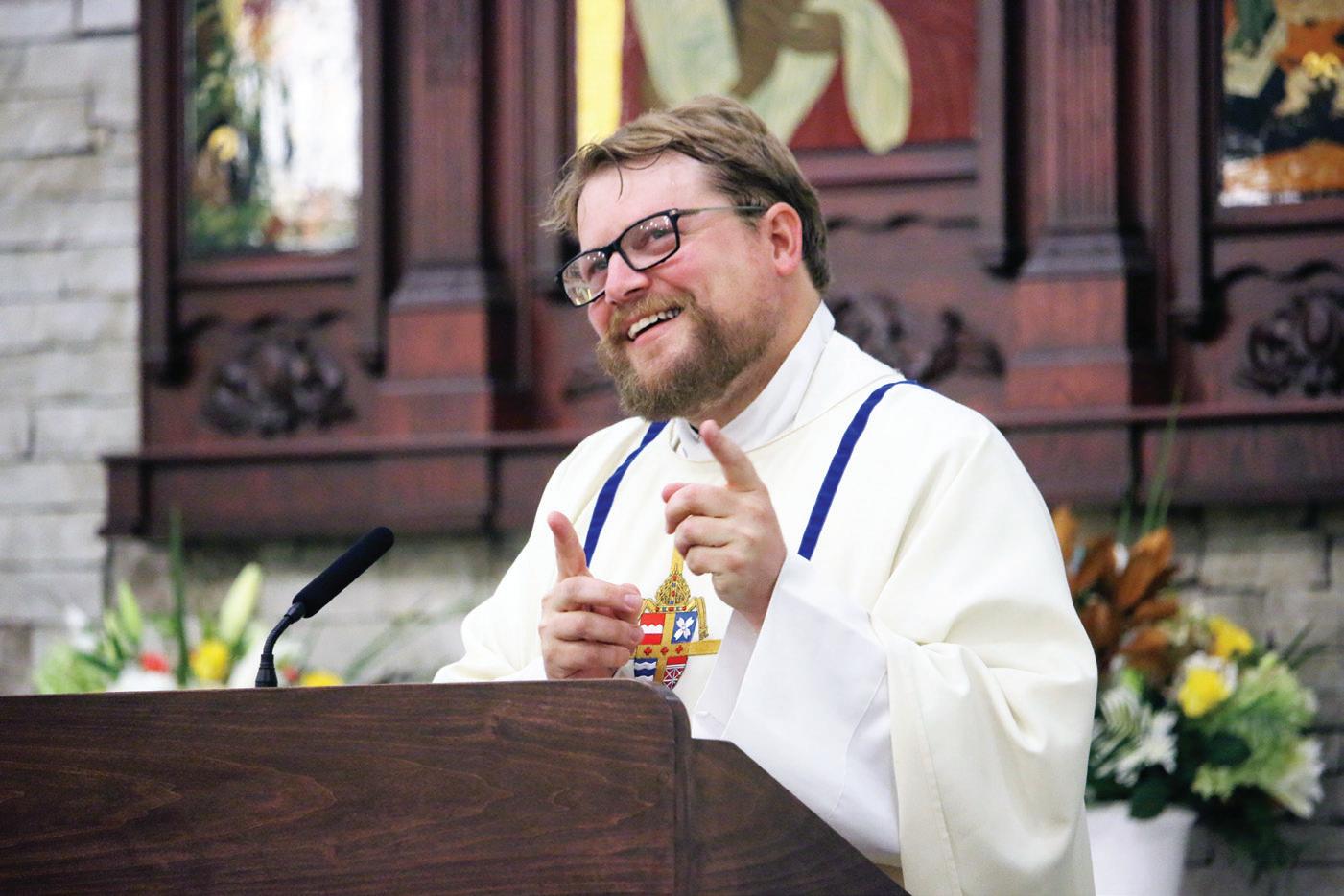

“He’s had a good vision. He’s kept things in line. He’s kept us on track.”
Father Floersh, former diocesan director of vocations, is good friends with Father Schuster and
was delighted to concelebrate the Mass.
“During my time as vocation director, I was able to come here and visit and speak to the parishioners about vocations. I got to know the parish very well.”
He said the parish is like a second home to him.
“In many ways it is,” he said.
Father Floersh said the dedication Mass “was very special, and I can’t imagine all of the work, even though I heard about most of it, that went into it. I was here two months ago, and the place looked so different than it is now. I will say that I was tearing up at several moments during Mass, and I can say that I am embarrassed to say that; however, that is the truth.”
Father Schuster said he has been at St. Alphonsus only a short time while his parishioners have been waiting two decades for a new church.
“Twenty years ago, I was at the University of Tennessee graduating from college, and they were just getting into Liguori Hall, and so now 20 years later to be in here and to work so hard and sacrifice to build this beautiful church, it’s amazing. It’s great to be a part of it.”
The archbishop’s opening line
of his homily, which drew a long applause, evoked “a great feeling to see how much people like what was done here,” Father Schuster said.
The pastor also received a hearty ovation during the Mass.
“I don’t know if I deserved it, but it was very special,” he shared.
Windows to the past
The church is not fully complete, with 17 stained-glass windows remaining to be installed.
“We just signed a contract to complete the stained-glass window project,” Father Schuster said.
“There are 14 windows, seven facing north and seven facing south. The idea was that there are 14 Stations of the Cross—St. Alphonsus Liguori wrote a meditation on the Stations of the Cross; it’s one of the most popular ones, so I thought, let’s make the stained-glass windows the Stations of the Cross.
“There are three other windows that will be put in, and one of them will be St. Cecilia in the choir section. There will also be one with Sts. Monica and Augustine because so many have a devotion to St. Monica because they pray for their children to come back to the faith, and they see St. Augustine as the fruit of that prayer. Then the other one will be St. Juan Diego wearing the tilma of Our Lady of Guadalupe.”
Several windows, manufactured by Lynchburg Glass of Lynchburg, Va., have already been installed.
“In the sanctuary you have St. Alphonsus on the right and St. Francis on the left. They’re both kneeling because they’re surrounding the tabernacle, and it’s a reminder of our relationship with our daughter parish of St. Francis of Assisi in Fairfield Glade, so I thought it would be good to have them in the sanctuary because we’re a community of Catholics up here centered in Christ,” Father Schuster said. “Then in the entryway we have the Baptism of the Lord, the Holy Eucharist, the Last Supper, and the Descent of the Holy Spirit,” the latter a round window over the front door.
“The idea behind that was, I thought, what are the sacraments of initiation, the theological entry into our Church, its baptism, confirmation, and Holy Eucharist. So, therefore, the physical entrance to this church will also reflect that: the Baptism of the Lord, the Last Supper, and the Descent of the Holy Spirit, Pentecost,” Father Schuster continued.
The Knights provided another window.
“The other stained-glass window we did was a Blessed Michael McGivney window, the founder of the Knights of Columbus,” Father Schuster said.
Building committee co-chairs Mr. Gray and Mr. Farrugia “were here every day” during the project, Father Schuster said.
THE EAST TENNESSEE CATHOLIC OCTOBER 1, 2023 n A13 www.dioknox.org
St. Alphonsus continued from page A12
A14
St. Alphonsus continued
on page
Receiving sanctuary Top: Archbishop Shelton J. Fabre blesses the interior of St. Alphonsus Church, sprinkling holy water. Above: The new sanctuary of St. Alphonsus Church is seen before the dedication Mass.
JIM WOGAN (2)
Joyful and thankful Father Mark Schuster, pastor of St. Alphonsus Parish, delivers heartfelt remarks at the conclusion of the dedication Mass for the new St. Alphonsus Church in Crossville on Sept. 12.
DAN MCWILLIAMS
“Once we began and broke ground and signed contracts, they were going to be the point people for the parish, for myself, and the construction company. They ate, slept, and bled, whatever you want to call it—they lived this project out since we broke ground. They’ve been tirelessly working on all of this. They were on site every day when they were doing construction and when they weren’t doing construction. I think I saw them every day. They would ask me questions after every Mass. I think I might miss that. They were very instrumental.”
Other groups were also vital, the St. Alphonsus pastor said.
“We also had a fundraising committee to help to see the feasibility and to go after and to encourage the fundraising, to raise the money. They were also instrumental. There was also someone on the finance council to make sure that we had the money we needed to pay for what we needed at the time.”
The pews had been planned for later, but the building committee put it out to the community, and the funds were raised. The tabernacle, crucifix above the altar, and statues came from the old St. Alphonsus Church across the street.
The triptych icon behind the altar was written by Father Paul Gerard Czerwonka of Wisconsin, who found out St. Alphonsus was building a new church and offered to create it. The icon depicts the Nativity, crucifixion, and resurrection. Father Czerwonka also wrote the icon of Blessed Stanley Rother that hangs in the back of the church.
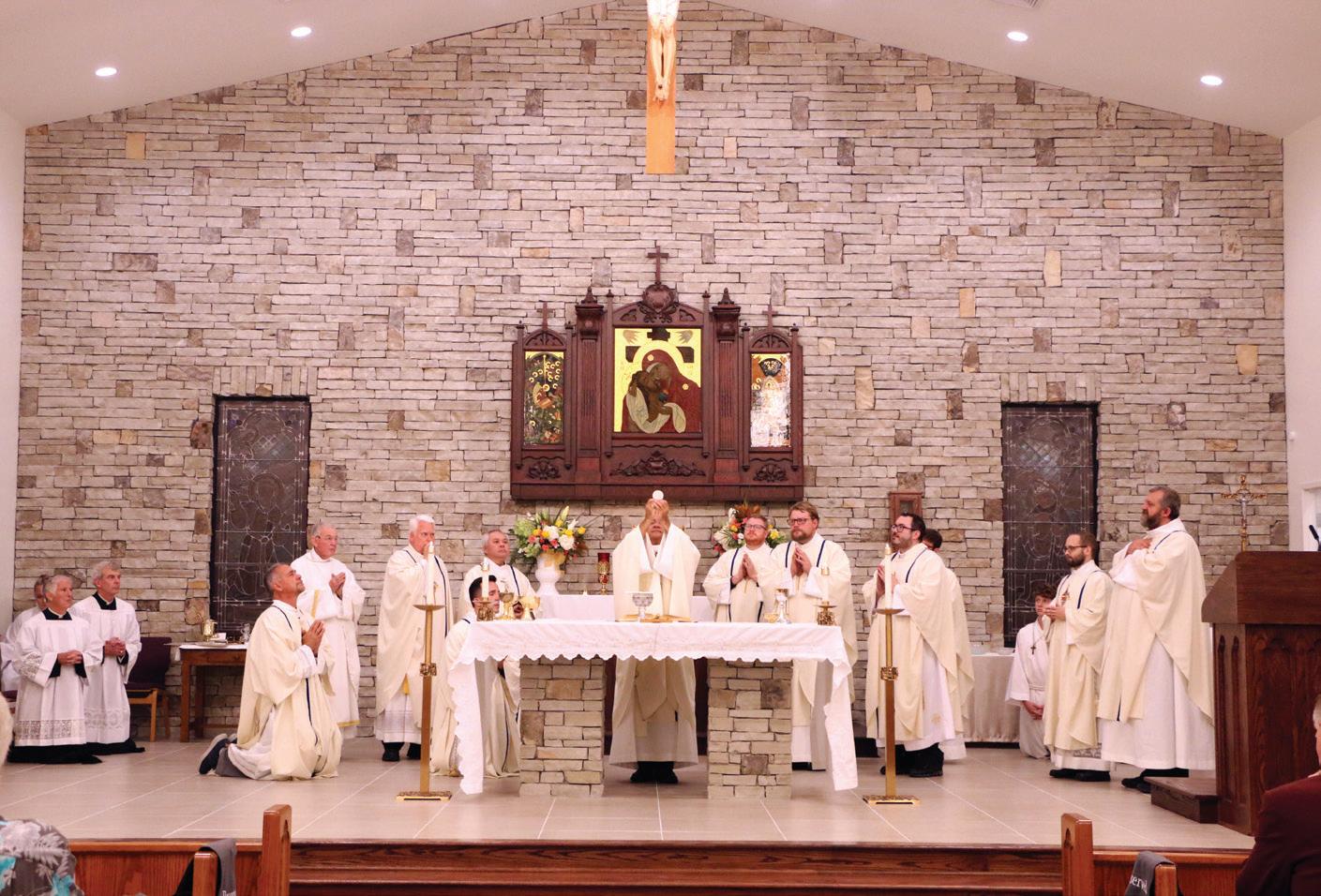

Father Schuster and Father Floersh traveled together to Wisconsin to bring the triptych back.
The new baptismal font was donated by the St. Alphonsus Council of Catholic Women. The statue niches were painted by parishioner Diane Minneci.
Father Schuster said he was grateful to Bishop-emeritus Richard F. Stika, who assigned him to St. Alphonsus in 2021, installed him as pastor in fall 2022 and at the same Mass blessed the bell that was put in the tower this year. Bishop Stika and Father Schuster officiated at the groundbreaking for the new church in December 2021. “It was Bishop Stika who sent
me up here and trusted this project to me. We don’t always get to finish the projects we start. He entrusted me with this, and Archbishop Fabre finished it with the dedication,” Father Schuster said.
The more than century-old bell, named Gabriel, was made by a St. Louis foundry.
“We ring it at the Angelus hours and then 15 and five minutes before every Mass and at funerals,”

Father Schuster noted.
Father Michael Woods, pastor of St. Francis of Assisi Parish in Fairfield Glade, took part in the dedication Mass. He recently presented
Father Schuster with a $30,000 gift from the daughter parish to St. Alphonsus. At that time earlier this year, the church was unfinished, but “so much” work happened in the weeks leading up to the dedication, Father Schuster said.
“Once the pews were in, it really started to take shape more,” he said. “Once the pews were in, we received our occupancy letter, and then we were able to modify the building, but until we had our certificate of occupancy we couldn’t modify beyond the plans.”
The floral arrangements at the dedication Mass were created by parishioners Beatrice Pereira and Sabina Coronado-Massey. The altar dressers were Gloria Casale and June and Manny Martin. The gifts were presented by Charlie Grismore, Justin Diehl, and Michael Boyd. Altar servers were Jake Nelson, Rogelio Hernandez, Angel Torres-Islas, and Paige Peaslee. A reception after Mass was hosted by the Council of Catholic Women, whose members made 200 cookies to look like little churches and little Holy Spirit windows.
Working together
Grand Knight Mr. Peaslee, a 20year member of St. Alphonsus, is also the Knights’ District Deputy for District 16 in Tennessee. He talked about his parish’s “huge project” that spanned more than 20 years.
“We raised the money. We didn’t borrow anything,” he said. “Everybody in this church came out and contributed. They bought windows. They bought pews. The council was allowed to buy a Father McGivney stained-glass window and have it installed. All the woodwork in this new church was done by parishioners. They
purchased the wood on their own. They stained it. They did it all. They made the pulpit.”
Mr. Peaslee said the sanctuary of the new church incorporates the altar from the first St. Alphonsus Church building.
“That altar has been in storage for more than 20 years,” he said. “The first St. Alphonsus Church in Crossville was a converted house. The altar from that building now serves as the center altar on which the tabernacle is placed just behind the altar of sacrifice. The Knights of Columbus purchased the altar stone from which the new altar of sacrifice is made.”
Mr. Peaslee wanted to use the former altar as a way to make the members of the original St. Alphonsus Church an important part of the new church. The Stations of the Cross in the new church were carved by the first priest assigned to St. Alphonsus, he added. The new stained-glass windows will replace all standard windows in the nave of the new church later this year or early next year, he said.
The broader Crossville community came together to help build the new St. Alphonsus Church, with people who are not Catholic donating and installing building material, Mr. Peaslee pointed out.
“A lot of people came out of the woodwork to help with this project,” he said.
Sara Carey, who serves St. Alphonsus Parish as the assistant director of religious education, also assists the parish with liturgy coordination.
“This has been a long time coming. It has been 20 years,” she said. “We moved into the parish life center on May 27, 2003. I was here. I had only been working here about two years at that point.”
She said St. Alphonsus has about 400 families, with families that have children making up about half of that total. She said the parish is growing among its members and from people moving into the Crossville area.
“The original plan was to build a new church within five years of moving into the parish life center. Then the recession hit, and that put a stop to fundraising,” Mrs. Carey said. “Then we had a change in pastors, and then we had some financial issues. So, it was like every time we thought about it, we were
like, no, this is not a good time. Finally, about five years ago, when Father Jim Harvey was here, we got the ball rolling with a building committee and finalized plans. When Father Mark got here, a big chunk of the planning was already done, but he still had to finish out the fundraising and the tweaking that was needed such as permits.”
The project “has taken awhile,” Mrs. Carey said.
“We broke ground in December 2021 during the pandemic, and they didn’t start digging until maybe May of 2022. Our original dedication date was October 2022 and then March 2023, and here we are in September. We moved the dedication three times.”
She said the new church provides much better functionality for parish events. Before, the parish life center would need to be converted from worship space to event space in order to host church functions. Now, each building is dedicated.

Mrs. Carey said it will be so much better to celebrate Mass in the church and then walk next door to the parish life center for related events. “It’s just nice to be able to come and have a church to worship in,” she noted.
St. Alphonsus Parish’s roots date to the 1940s, when monthly Masses were celebrated at the home of Marge Hall with the priest usually traveling from Harriman. Weekly Mass was offered by Father James Murphy beginning in 1954 in an upper room of the old Crossville Play Center/City Hall building. The original church on Sparta Drive was built in 1961 at a cost of approximately $35,000. The parish numbered 30 families at that time. St. Alphonsus officially became a parish in 1974 and had 100 families by 1980. A new church building was dedicated in 1983, with the old structure connected to it serving as a religious-education wing.
Bishop Anthony J. O’Connell gave permission in 1996 for the growing parish to build new facilities on a 27-acre site across Sparta Drive from the old church.
Then Bishop Joseph E. Kurtz and then-pastor Father Patrick Brownell helped break ground on the $2.1 million Liguori Hall in April 2002, and Knoxville’s second bishop presided at the Mass of blessing for the parish life center in May 2003. ■
THE EAST TENNESSEE CATHOLIC A14 n OCTOBER 1, 2023 www.dioknox.org
St. Alphonsus continued from page A13
Prayers of thanksgiving Archbishop Shelton J. Fabre, second from left, celebrates the dedication Mass for the new St. Alphonsus Church. Also kneeling are, from left, Deacon Peter Minneci, Deacon Daniel Herman, Father Mark Schuster, Father Christopher Floersh, and (back) Deacon Walt Otey
Bless this holy place Father Mark Schuster, pastor of St. Alphonsus Parish in Crossville, anoints a wall with holy chrism during the dedication of the new church. Father Schuster was assisted in anointing the walls by Father Christopher Floersh.
Open for worship The new St. Alphonsus Church in Crossville was dedicated on Sept. 12, with Archbishop Shelton J. Fabre celebrating the dedication Mass and priests from around the Diocese of Knoxville concelebrating. The Cumberland County parish has been planning for the church for 20 years.
First Communion Archbishop Shelton J. Fabre consecrates the Eucharist during the first Mass in the new St. Alphonsus Church in Crossville on Sept. 12. Archbishop Fabre was joined in the St. Alphonsus sanctuary by priests and deacons of the Diocese of Knoxville.
JIM WOGAN (2)
BILL BREWER (2)
relics must be first class (although a few are second class), sealed, and authenticated. There are three major relic categories at the shrine.
The first is the earliest saints, including relics of the Apostles, St. Stephen (the first martyr), and the relatives of Jesus.
The second are more recent saints, such as Padre Pio, the Fatima children, and St. Damien of Molokai.
The third grouping includes wellknown saints on the liturgical calendar, including St. Aloysius Gonzaga, St. Teresa of Avila, St. Anthony of Padua, and St. Anne, the mother of Mary.
Additionally, there are relics of many popes, including St. John Paul II and St. Pius X. There are relics related to Christ, such as three pieces of the true cross. And there are remains of saints martyred in ancient Rome.
Among the shrine’s more notable relics are the complete remains of St. Victoria, a third-century martyr, originally enshrined in the catacombs in Rome. The body is not incorrupt, but covered in wax and clothed. The body is encased in glass, so visitors can come up and take a close look. The shrine also is home to the nearly complete remains of St. Concordia, another third-century martyr.
St. Anthony’s Chapel in Pittsburgh boasts an even larger collection of 5,000 relics. The chapel was originally built in two phases by Fa-
Synod continued from page A3
ther Suitbert Mollinger in 1880 and 1892, who used his own family’s money to build the structure and begin collecting relics in Europe.
Father Mollinger died in 1892, two days after the opening of the second section of the chapel.
Today, it is part of Most Holy Name of Jesus Parish in the Diocese of Pittsburgh. The archway at the entry of the chapel bears the inscription in Latin: “The bodies of the saints rest here in peace.”
This shrine draws as many as 200 visitors weekly. Special events, such as the feast day of its namesake, St. Anthony of Padua, draw even larger crowds. On Tuesdays, those
gift of the other, for the gift of peace, and for the gift of creation.
The vigil included listening to the Word of God, praise and intercession, Taizé songs, and silence “a strong sign of fraternity, unity, and peace,” the Vatican said.
“The ecumenical dimension of the synod is very, very important,” Sister Nathalie said. “And through all this dialogue to foster unity among the different Christian churches and communities (is important). We need to learn this exchange of gifts. That doesn't mean that we all have to be exactly the same way.”
“But we share one baptism, one faith, and we follow Christ,” she continued. “I see that this synod is also helping us to learn more and more how to be one Church united, but with and through diversity, because at the end that’s the code of God: ‘May all be one so that the word believes,’” a reference to John 17:20-23.
Thousands of young adults ages 18 to 35 from various countries also took part in a program of workshops and meetings around Rome Sept. 29-Oct. 1 as part of a synodal
22-year-old is U.S. voting delegate at Rome Synod
By Francesca Pollio Fenton Catholic News Agency
At first glance, 22-year-old Julia Oseka seems like your average college student. But the junior at St. Joseph’s University in Philadelphia majoring in physics and theology, a native of Poland, is anything but ordinary.

Ms. Oseka is one of 10 non-bishop voting members from the United States and Canada who are at the Synod on Synodality taking place at the Vatican from Oct. 4–29.
In 2022, Ms. Oseka became a student leader for Synodality in Catholic Higher Education in the Archdiocese of Philadelphia (SCHEAP), which is a coalition of Catholic universities, colleges, and Newman Centers in the Philadelphia area fostering student voices in the synod.
In April 2022, a large, intercollegiate listening session took place at La Salle University, with representatives from all participating colleges and universities and Archbishop Nelson Perez of Philadelphia. Soon after this meeting, Archbishop Perez and other SCHEAP members selected Ms. Oseka as one of three Philadelphia delegates to the synod’s North American Continental Assembly.
In an interview with Catholic News Agency, Ms. Oseka called her participation in the synod “very humbling.”
“I see it as really a sign that the Church is
attending Mass are blessed with a relic of St. Anthony, said Deacon Greg Jelinek, who serves the parish.
“Our Catholic tradition is rooted in the holiness and goodness of the body, which extends to the remains of the saints,” said Deacon Jelinek. “They achieved great holiness in their lives, and it doesn’t cease with their death.”
The collection is random, he said, containing mostly first-class relics. Notable relics include those of St. Demetrius, a fourth-century martyr, whose bones have been carefully wrapped in silk. The skull of St. Macarius of Egypt, a fourth-century monk, is kept behind the altar. Rel-

ics of St. Anthony of Padua include one of his teeth. There are also remains of 20th-century saints, such as Padre Pio and St. Maria Goretti. There are many relics related to Christ’s passion and death, including 14 pieces of the true cross, rocks from the garden of Gethsemane and the column on which Christ was scourged, pieces of the reed and sponge with which He was given a drink of sour wine, and a thorn from Jesus’ crown of thorns. For Deacon Jelinek, the relics are a “physical link, which binds Christians from across the centuries.” He said, “When I’m in the chapel, I feel I’m in the physical presence of a great and glorious communion of saints.”
St. John Cantius Church in Chicago is another historic church that is home to about 1,800 relics. The relics were donated to the church from a variety of sources but mostly from priests. Most of the relics are secured in a vault, with a small portion on public display.
A portion of the collection includes relics of the saints from the Lenten Station Churches of Rome. A custom that dates back to the fourth century, pilgrims to Rome could journey to Rome and visit churches honoring various saints. The bishop of Rome, the pope, would come celebrate Mass for them in the churches. The practice fell out of use when the papacy temporarily moved to Avignon, France, in 1309, but it was revived by Popes Leo XIII and St. John XXIII. ■
“A synodal Church is a Church for everybody, with everybody listening to everybody.

So, it’s very important to connect with young people, especially (because) during the consultation (phase) and the continental meetings, the topic of young people was one of the main concerns. How can we connect better with young people, reach them, proclaim the Gospel to them,” she said.
“Together” program.
Workshop themes included hearing refugees share their experiences, learning from other denominations and faiths, visiting the work of the city missions to the marginalized, recognizing Christ in the diversity of Catholic traditions, ecumenical panel discussions, and caring for creation.
Sister Nathalie said young people are crucial for the synodal process.
“I always say, if we are living this synod now, it’s a fruit of the synod on youth, because through the synod on youth, we have understood that young people want to be listened to,” she said of the 15th world Synod of Bishops that took place in Rome in 2018 that is commonly referred to as the Synod on Young People.
For Sister Nathalie, World Youth Day in Lisbon Aug. 1-6 was a perfect preparation for the synod in Rome. It was a “gift” to be there, she said, “also to experience synodality.”
“Young people, priests, bishops, men and women, consecrated people” were “journeying together,” she said, which she saw as “synodality in action.” ■
THE EAST TENNESSEE CATHOLIC OCTOBER 1, 2023 n A15 www.dioknox.org
United States Postal Service Statement of ownership, management, and circulation Required by 39 U.S.C. 3685 1. Publication title: The East Tennessee Catholic 2. Publication number: 0007-211 3. Filing date: Sept. 29, 2023 4. Issue frequency: Monthly 5. Number of issues published annually: 12 6. Annual subscription price: $15 7. Complete mailing address of known office of publication: 805 S. Northshore Drive, Knoxville, Knox County, TN 37919-7551 8. Complete mailing address of headquarters or general business office of publisher: Same 9. Full names and complete addresses of publisher, editor, and managing editor: publisher, Archbishop Shelton J. Fabre, Diocese of Knoxville, 805 S. Northshore Drive, Knoxville, TN 37919-7551; editor, Bill Brewer, 805 S. Northshore Drive, Knoxville, TN 37919-7551; managing editor, Dan McWilliams, 805 S. Northshore Drive, Knoxville, TN 37919-7551 10. Owner: Roman Catholic Diocese of Knoxville, 805 S. Northshore Drive, Knoxville, TN 37919-7551 11. Known bondholders, mortgagees, and other security holders owning or holding 1 percent or more of total amount of bonds, mortgages, or other securities: None 12. Tax status (for completion by nonprofit organizations authorized to mail at nonprofit rates): Has not changed during preceding 12 months 13. Publication name: The East Tennessee Catholic 14. Issue date for circulation data below: Sept. 3, 2023 15. Extent and nature of circulation Average number copies each Number copies of single issue during preceding 12 months issue published nearest to filing date A. Total number of copies (net press run) 21,467 21,200 B. (1) Mailed outside-county paid subscriptions stated on PS Form 3541 20,547 20,294 (2) Mailed in-county paid subscriptions stated on PS Form 3541 0 0 (3) Paid distribution outside the mails 0 0 (4) Paid distribution by other classes of mail 0 0 C. Total paid distribution 20,547 20,294 D. Free or nominal rate distribution (1) Outside-county copies on Form 3541 467 438 (2) In-county copies on Form 3541 0 0 (3) Copies mailed at other classes 0 0 (4) Copies distributed outside the mail 0 0 E. Total free or nominal rate distribution 467 438 F. Total distribution 21,014 20,732 G. Copies not distributed 453 468 H. Total 21,467 21,200 I. Percent paid 97.8 97.9 16. Electronic copy circulation 17. Statement of ownership will be printed in the Oct. 1, 2023, issue of this publication. 18. Signature and title of editor, publisher, business manager, or owner: Bill Brewer, editor. Date: Sept. 29, 2023 I certify that all information furnished on this form is true and complete. I understand that anyone who furnishes false or misleading information on this form or who omits material or information requested on the form may be subject to criminal sanctions (including fines and imprisonment) and/or civil sanctions (including civil penalties).
Relics continued from page A6 CATHOLIC NEWS SERVICE PHOTO/VATICAN MEDIA Voter continued on page A19
Papal veneration Pope Francis kisses one of the relics Coptic Orthodox Pope Tawadros II of Alexandria, Egypt, gave him of the 21 Coptic martyrs murdered by Islamic State terrorists in 2015. The two popes met on May 11 in the library of the Apostolic Palace at the Vatican.
Ms. Oseka
Pope Francis leads spiritual retreat ahead of Synod
Holy Father prays Church members embrace silence
By Justin McLellan Catholic News Service
On the eve of a three-day spiritual retreat for participants in the assembly of the Synod of Bishops, Pope Francis prayed that members of the Church may embrace silence to listen to the voice of God and one another.
“Silence, in the ecclesial community, makes fraternal communication possible, where the Holy Spirit draws together points of view,” the Holy Father said to members of the Synod on Synodality, Christian leaders, and young people in St. Peter’s Square on Sept. 30
“To be synodal is to welcome one another like this, in the knowledge that we all have something to share and to learn, gathering together to listen to the spirit of truth in order to know what the Lord is saying to the churches,” the Holy Father added.
Synod participants spent three days together at a spiritual re -
offered to the community, and that love is offered in the name of Jesus Christ,” Archbishop Fabre said.
The blessing and ribbon-cutting ceremony took place on the feast of St. Vincent de Paul, the patron saint of charitable societies, who Archbishop Fabre called “the apostle to the poor, whose very name engenders in us a reminder of our responsibility to those who approach us with need.”
He said Sept. 27 is a day of giving thanks for all that Catholic Charities of East Tennessee has endured in recent months and all the agency has accomplished since the fire.
“That fire did not break Catholic Charities. It has made Catholic Charities stronger and even more determined to continue the mission of serving the most vulnerable just as Jesus Christ has invited we do, just as Jesus Christ demands that we do,” he noted.
He quoted the motto for Catholic Charities of East Tennessee, which is “Providing help and creating hope.”
“I think that is a wonderful motto because when we do provide help, we engender within that person hope, hope that someone cares, hope that someone sees them, and hope that someone has responded to their need,” the archbishop continued.
He pointed out that CCETN does just that provide help and create hope every day.
He also noted that Catholic Charities serves those in need regardless of their faith belief or even if they have no faith belief.
“As the saying goes, we help them not because they are Catholic but because we are Catholic, and that is what Jesus Christ invites us to do,” he continued.
He underscored the fact that Catholic Charities provides programs to support families in crisis, programs that support children in crisis, and programs that provide the basic necessity of food and assistance with housing stability.
And he emphasized that people who carry the cross of food insecurity, housing insecurity, problem pregnancies, mental-health issues, or other needs are greatly aided by Catholic Charities, which helps them carry their crosses and reassures them that they are not alone.
The archbishop, who compared Catholic Charities to Simon of Cyrene, who helped Jesus carry His cross, thanked Catholic Charities and its staff, volunteers, and those who pray for the ministry of the agency and those who support it financially, especially as it endeavored to rebuild after the fire.
“In the name of our Lord, Jesus Christ, I thank you, and I simply say I am always, always humbled whenever I visit Catholic Charities across the country in dioceses
treat outside Rome before the synod assembly formally opened on Oct. 4.
Seated before the San Damiano cross, in front of which St. Francis of Assisi said he heard Jesus tell him to “rebuild my Church,” Pope Francis prayed that “the synod be a ‘kairos’ (moment) of
in
order to hear God's voice
stantinople, Anglican Archbishop
Justin Welby of Canterbury, Syriac Orthodox Patriarch Ignatius Aphrem II, and the Rev. Anne Burghardt, who is the general secretary of the Lutheran World Federation.
Some 4,700 young people from 51 countries who belong to different Christian traditions also were present in St. Peter ’s Square, according to the ecumenical Taizé Community, which organized the event

The Vatican said some 18,000 in total were presen t.
fraternity, a place where the Holy Spirit will purify the Church from gossip, ideologies, and polarization.”
Alongside Pope Francis were the leaders of 12 Christian churches and communities, including Orthodox Ecumenical Patriarch Bartholomew of Con -
Many of the young participants in the prayer vigil completed a pilgrimage through Rome, walking to St. Peter’s Square after a time of praise and worship at the Basilica of St. John Lateran, which is the cathedral of the Diocese of Rome, on the other side of the city Pope Francis told the group that just as silence is necessary to listen to the different perspectives that exist within the Catholic Church, “silence is es -
Retreat continued on page A22
programs during the 18-month rebuild,” she noted.
“First, it opened the sixth pregnancy help center in Helenwood, Tenn. Second, CCETN opened a Safe Place for Kids, the second children’s emergency shelter designed to support the (Tennessee) Department of Children’s Services and the children in their custody. And by the grace of God, CCETN received state licensure and opened an infant adoption program, saving lives and building families through adoption. Then CCETN purchased its first ultrasound machine, preparing for the expansion of its Knoxville pregnancy center with ultrasound services scheduled for next spring.”
Bless this ministry Above: Archbishop Shelton J. Fabre delivers a blessing for the newly renovated Catholic Charities of East Tennessee offices in Knoxville. Assisting Archbishop Fabre is Deacon David Duhamel, who is serving as interim executive director of CCETN. Below: Deacon Sean Smith, chancellor of the Diocese of Knoxville, talks with Lisa Healy, who has retired as executive director of Catholic Charities, in a new room that highlights the agency's clients.
While expanding its portfolio of services, Mrs. Healy pointed out that all CCETN pregnancy help centers also remained open as did community supportive-housing services, offices of immigration services, the Samaritan Place shelter for homeless seniors, the Crazy Quilt Friendship Center and food pantry, Hope Kitchen, Columbus Home Assisting Parents, and counseling services.
She also thanked people and organizations critical to rebuilding its headquarters, including Diocese of Knoxville vice chancellor Paul Simoneau, the city of Knoxville, George Armour Ewart Architect, Rouse Construction, OfficeWorks office furniture, Coldwell Banker real estate, and Knoxville Leadership Foundation.
Mrs. Healy delivered special appreciation to Jesus Christ and His healing ministry on which Catholic Charities models itself.
because what you do is so critically important to the Church, and I really do believe that it is an expression of the Catholic Church at its very best. So, I thank you for the love, I thank you for the hope, I thank you for the presence, I thank you for the assistance that you provide to so many. And through the intercession of St. Vincent de Paul, may God continue to bless you in this very important work,” he concluded.
Deacon David Duhamel, diocesan vice chancellor of strategic planning, training, and school sustainability, emceed the ceremony. Deacon Duhamel also is serving as interim executive director of CCETN while a search is underway to find a perment executive director.
Lisa Healy, who was hired as chief operating office of CCETN in 2017, served as executive director from 2019 until her retirement over the summer.
Mrs. Healy was on hand to welcome Archbishop Fabre, deliver remarks about CCETN’s grand reopening, and participate in the ribbon-cutting.
She also was recognized and thanked by Deacon Sean Smith, chancellor of the Diocese of Knoxville, for her service to Catholic Charities of East Tennessee and her work in leading the recovery efforts following the devastating fire.
Mrs. Healy singled out the CCETN staff with appreciation for their daily diligence in serving those in need and for making sure that services continued following the 2021 incident.
“One of the most wonderful things to share is that despite the hardship brought on by an unexpected arson fire, CCETN continued uninterrupted social-service programming for over 3,000 clients in the first year alone,” Mrs. Healy said. “During the rebuilding, Catholic Charities continued to focus on the mission: growing family and children programming.”
She pointed out that when the fire occurred, CCETN operated 11 social-service programs.
“Amazingly, Catholic Charities expanded its service footprint with the expansion of four of its
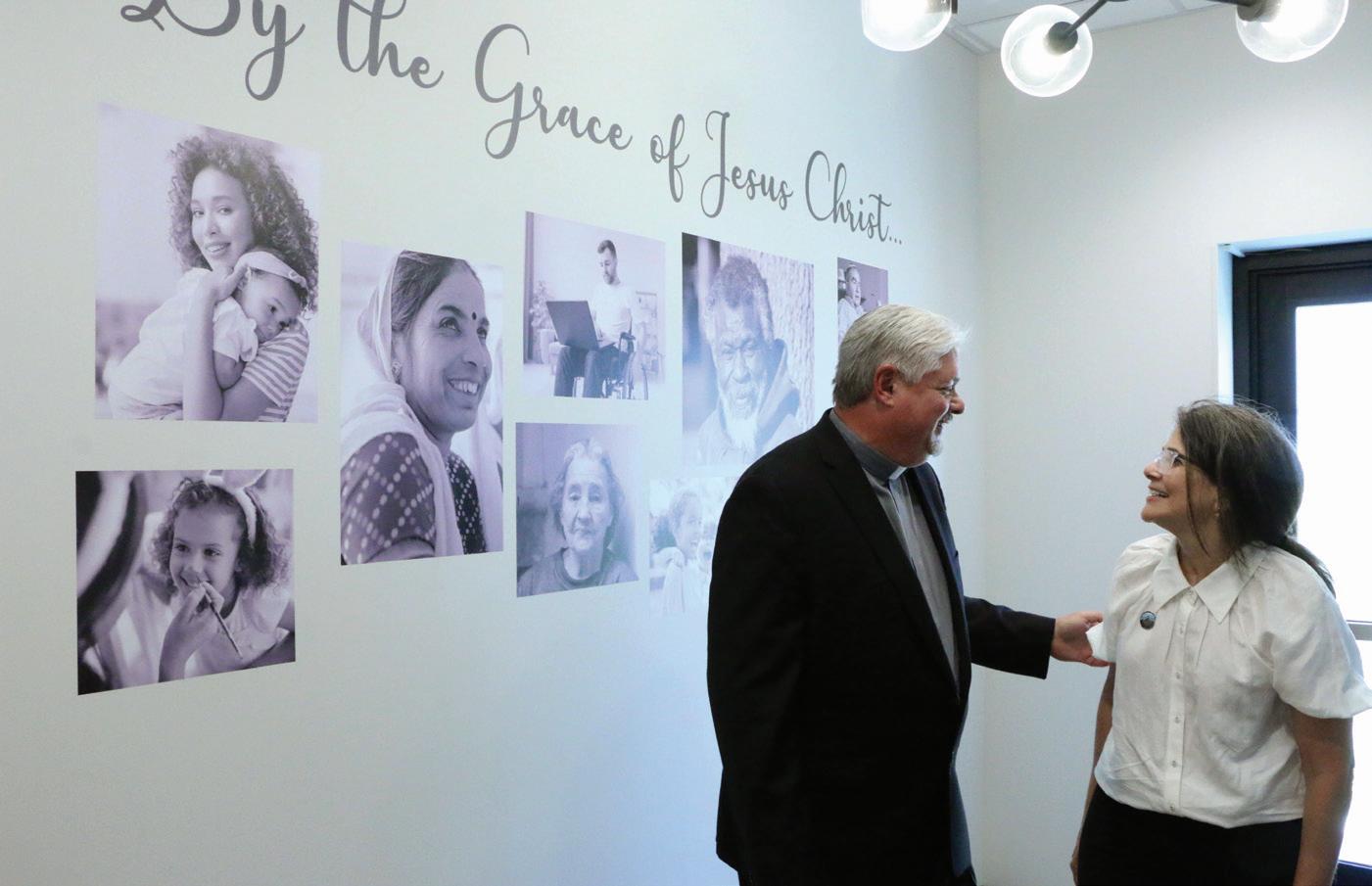

“I want to mention one other thing that is personally important for me to share with you. In the building there is a painting of the image of Jesus. It is the Divine Mercy image. If you are not familiar with the Divine Mercy image, the artist was asked to paint the image with the inscription ‘Jesus, I trust in You.’ This Catholic Charities painting happened to come out of Rome ... and it was hung directly across the hall from the hottest point of the fire, three feet from the burning office the arsonist first set ablaze,” Mrs. Healy shared.
“The image is almost unscathed. For me personally, this image is a reminder that God is in control. God is good and makes good out of the worst things, including devastating arson fires. Look what has been built from the ashes of a fire, a beautiful building, expanded services to help more people, new community friends, challenges we overcame that made us better.
“I am confident that by God’s grace Catholic Charities will continue to provide help and hope for many years to come from this wonderful new building,” Mrs. Healy concluded. ■
THE EAST TENNESSEE CATHOLIC A16 n OCTOBER 1, 2023 www.dioknox.org
CCETN continued from page A2
The sounds of silence People pray during an ecumenical prayer vigil led by Pope Francis in St. Peter's Square on Sept. 30 ahead of the assembly of the Synod of Bishops.
CATHOLIC NEWS SERVICE PHOTO/LOLA GOMEZ
DEACON SCOTT MAENTZ
BILL BREWER
Sister Mary Georgeanna Mankel, RSM
Sister Mary Georgeanna Mankel, RSM, died peacefully on Sept. 7 at the age 86.
Sister Mary Georgeanna, who served as a Sister of Mercy for 69 years, was born on Nov. 2, 1936, in Knoxville.
She was preceded in death by her parents, George Mankel Sr. and Willia Mankel, her brothers, Monsignor Xavier Mankel and George W. Mankel Jr., and a niece, Susan Fefolt.
Sister Mary Georgeanna is survived by nephews Mike Mankel (Tatsiana McGee), Eric and Sally Mankel, and Dave and Cathi Fefolt; nine great-nieces and nephews; 10 great-great nieces and nephews; and her Sisters of Mercy.
Sister Mary Georgeanna entered the Sisters of Mercy on Sept. 8, 1954. She earned her bachelor’s degree in mathematics at Our Lady of Cincinnati College, her master’s degree in education at the University of Tennessee, and her registered-nursing degree at Aquinas Junior College.

Sister Mary Georgeanna served as a nurse at St. Mary’s Medical Center in Knoxville, St. Bernard Retirement Home, and Mercy Convent in Nashville.

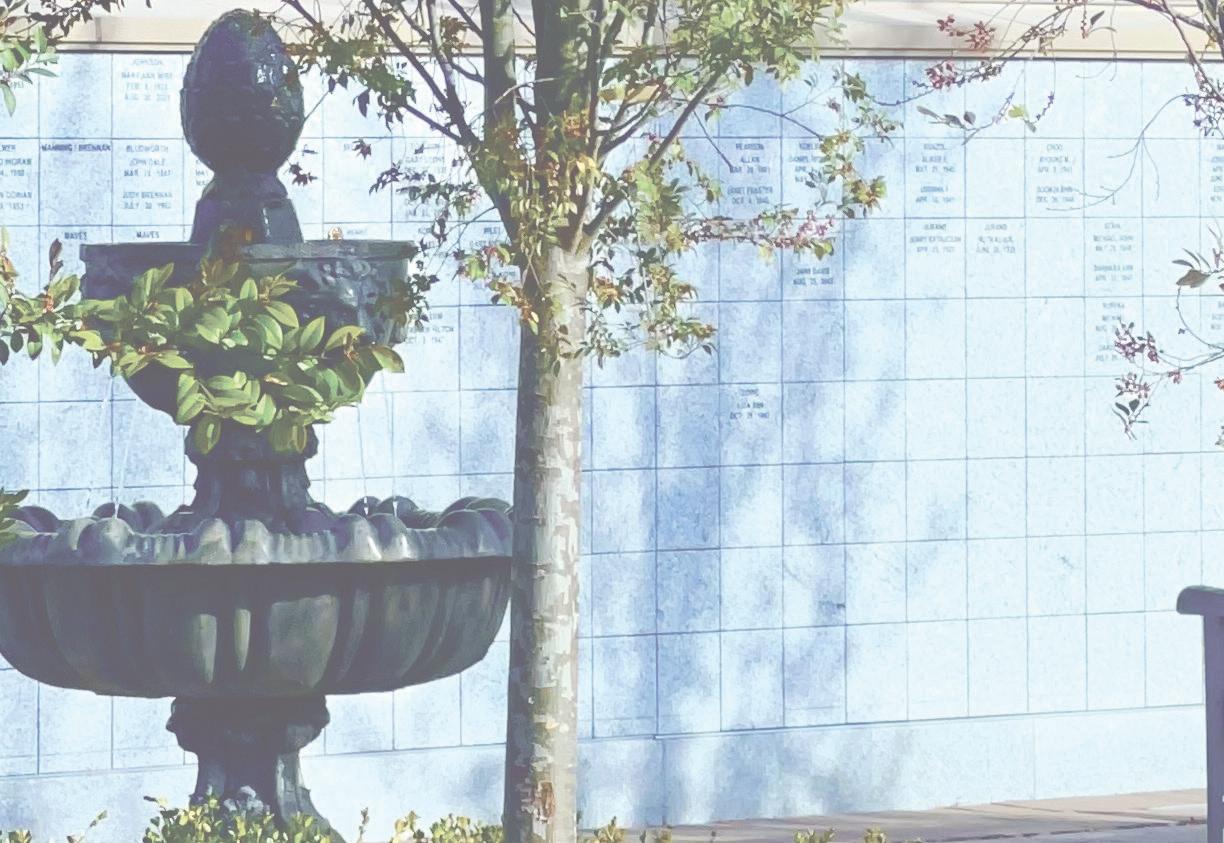
Sister Mary Georgeanna also was a teacher, mission coordinator, and music minister in Tennessee parochial schools, including St. Joseph School and Sacred Heart Cathedral School in Knoxville, St. Dominic School in Kingsport, St. Mary School in Johnson City, Sacred Heart School in Lawrenceburg, St. Edward School in Nashville, and Sacred Heart School in Loretto.
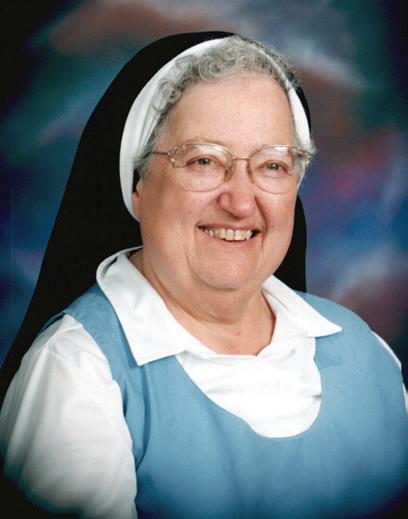
She also served as spiritual care and support for patients and their families at St. Mary’s Hospice.
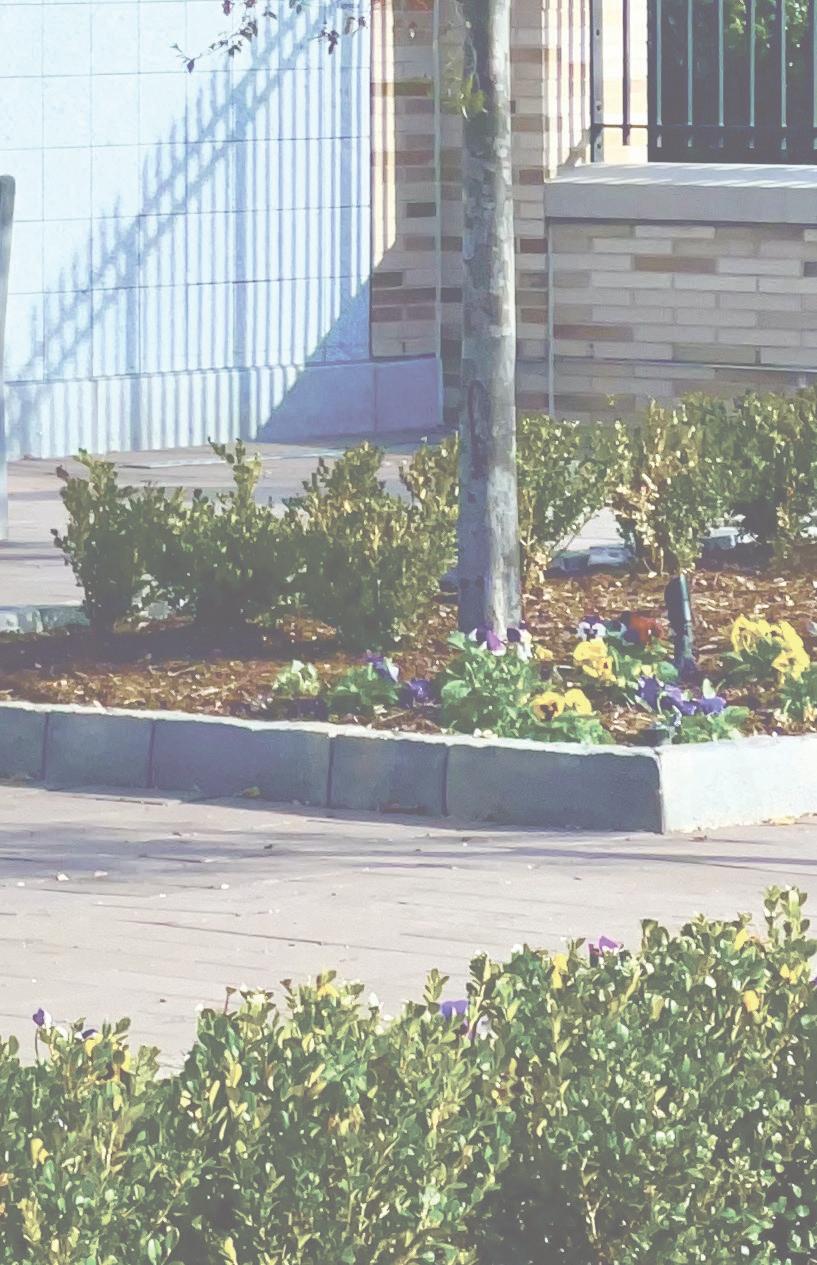
Her hobbies included reading, puzzles, and playing the guitar and piano.

Her commitment to God was refl ected in her choice of the work of Pedro Arrupe, S.J., “Fall in Love With God.” In her fi nal years, Sister Mary Georgeanna received the love and support of her Sisters of Mercy and the devoted nursing staff at Mercy Convent.
A private funeral Mass was held at Mercy Convent in Nashville, followed by burial at Calvary Cemetery in Nashville.



Sister Luke Hollerbach, OP
Sister Luke Hollerbach, OP, a member of the Dominican Sisters of St. Cecilia Congregation in Nashville for 63 years, died Sept. 22. She was 81.
Sister Luke, who was born in Michigan, was the daughter of the late Florian Joseph and La Verne Osberg Hollerbach. She attended Notre Dame High School in Chattanooga and entered the Dominican Sisters in 1960, making her profession of vows in 1962.
Sister Luke served as a teacher or principal in Catholic schools in Tennessee, Alabama, and Virginia from 1963 through 2006. In Nashville, she was a beloved kindergarten teacher at Overbrook School during the 1977-78 school year and from 1987-2005. Within the St. Cecilia Congregation, she served as subprioress of the motherhouse from 1993-2000, assisted in the novitiate from 1994-2004, and was elected vicaress general from 2006-12.
She is preceded in death by her brother, Steve Hollerbach, and is survived by her sister, Mrs. Kathy Carroll; her brother and sister-in-law, Mr. and Mrs. Joseph S. Hollerbach; nieces and nephews Matt and Littany Hollerbach and their children, Evelyn, Daphne, and Margaret; Ben and Hayley Hollerbach and their children, Elinor and Thacher; Angie and Rick Gattone; and Amy and Scott Ingell and their children, Sarah Faith, and Will.
Wakes for Sister Luke were held on Sept. 25 and Sept. 26 at the St. Cecilia motherhouse, with her funeral Mass following the Sept. 26 wake.
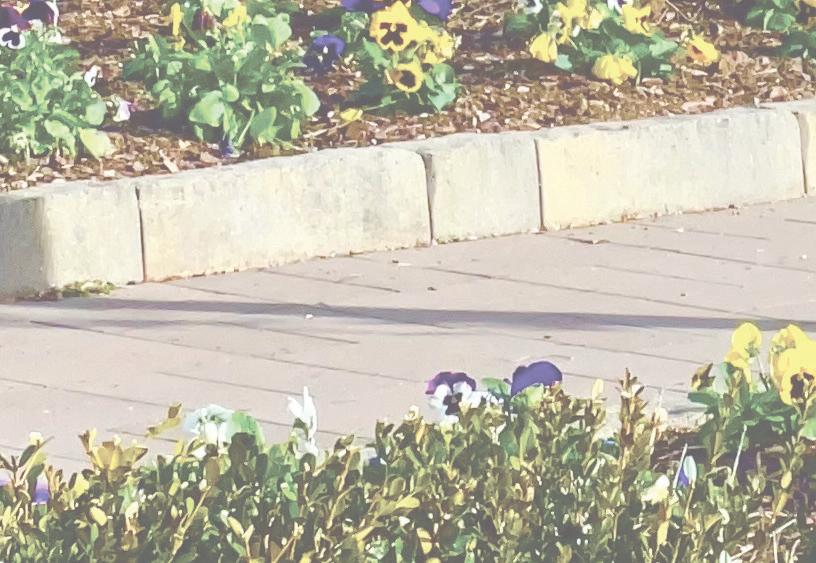
George Henry Krebs Sr.

George Henry Krebs Sr., 92, of Clinton passed away Sept. 22 at Canterfield of Oak Ridge with his beloved wife Shirley “Tootie” at his side.


Mr. Krebs was born in Newport, Ky., to the late George L. and Julia J. Strategier Krebs. He met his wife, Tootie, as a second-grader at St. Therese School in Southgate, Ky. As a high- schooler, he was employed by Brienes Jeweler in Cincinnati, where he apprenticed to learn the art of clock
and watch repair. He was a graduate of Newport Catholic High School and attended Xavier University in Cincinnati.

During the Korean conflict, Mr. Krebs served in the U.S. Air Force as an aviation instrument mechanic in Japan and attained the rank of staff sergeant.
George and Tootie were married in February 1954 at St. Therese Church in Southgate, Ky., after his return from Japan. He worked at Simon & Fischer Oldsmobile in Newport until 1969, when Mr. and Mrs. Krebs and their family moved to Clinton. There, with Mrs. Krebs at his side, he started Krebs Chevrolet Inc. in Clinton, operating it for 22 years until retiring in 1991. He continued to collect and repair clocks and watches throughout his life.
Mr. Krebs was a devout Catholic and longtime member of St. Therese Church in Clinton, where he was one of the original founding members. Left to cherish his memory are Tootie, his wife of 69 years; sons Dr. George Krebs Jr. (Myra) and Joe Krebs (Chantel); daughters Lori Puryear, and Julie Edmondson (Carl); grandchildren Sarah Burns (Joseph), Alex Krebs (Emma), Katie Schreiber (Bryan), Andrew Cook, Ryan Cook, Matthew Puryear, Blake Edmondson, and Peyton Krebs; stepgrandchildren Branton Brown, Dan Edmondson, Josh Edmondson (Charity), Katie Meister (Jon), Carla Pimental (Mike), Cory Richardson, Cameron Richardson (Carolyn); and great-grandchildren Avalyn Maier, Josie Burns, Keaton Schreiber, and Kaiden Schreiber.
Mr. Krebs was preceded in death by his parents, George L. and Julia J. Strategier Krebs; brothers Rev. Paul F. Krebs and Stanley M. Krebs; son-in-law Marshall H. Puryear; and granddaughter Leza A. Watts.


The family wishes to extend special thanks for the loving and compassionate care received from Canterfield of Oak Ridge, Amedisys Hospice, and dear friend Deacon Dan Hosford of St. Joseph Parish in Norris. A funeral Mass was celebrated on Sept. 30 at St. Therese Church in Clinton. Burial followed at Grandview Memorial Garden. A separate memorial Mass was held on Oct. 7 at St. Therese Church in Mr. Krebs’ hometown of Southgate, Ky. Donations in Mr. Krebs’ memory may be made to the Building Debt Reduction Fund at St. Therese Church, 701 S. Charles G. Seivers Blvd., Clinton, TN 37716 or the Employee Fund at Canterfield of Oak Ridge, 200 Bus Terminal Road, Oak Ridge, TN 37830. ■
The Assurance of Peace, Quiet Reflection, & Prayer The
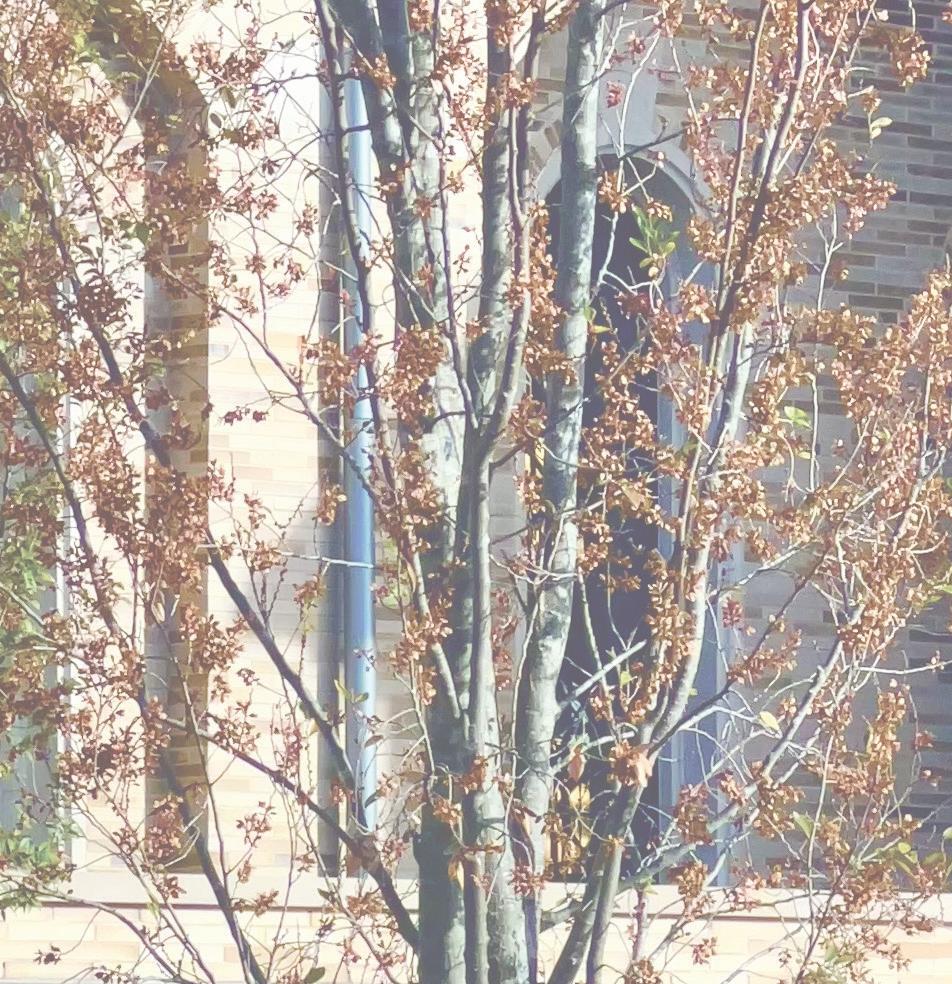
THE EAST TENNESSEE CATHOLIC OCTOBER 1, 2023 n A17 www.dioknox.org
For
reserve,
Faithful Departed
Columbarium
more information on how to
please contact Scott Barron: sbarron@shcknox org
Sr. Georgeanna
Sr. Luke
Mr. Krebs
Expert continues to be bullish on vocations
Priest and director of seminarians sees reasons for hope amid secularism popularity
By Gina Christian OSV News
Adecrease in religious belief remains a “significant challenge” in cultivating vocations to the priesthood, said a vocations expert at a recent conference.
Diocesan vocation directors continue “to work against a culture of secularism in which the purpose and meaning of one’s life for so many of our young people ... is defined by themselves,” Father Chuck Dornquast, director of vocations for the Diocese of St. Petersburg, Fla., told OSV News.
Father Dornquast shared his thoughts during the Aug. 28-Sept. 1 convention of the National Conference of Diocesan Vocation Directors, or NCDVD, of which the priest is vice president.
Founded in 1962, the nonprofit works closely with the U.S. Conference of Catholic Bishops to promote and support priestly vocations. Membership is open to all Catholic dioceses and eparchies in the United States, with associate memberships available to Catholic dioceses outside of the United States.
The convention, now in its 60th year, drew more than 218 priests, some 20 men and women religious, and laymen and laywomen from six countries to the Immaculate Conception Retreat Center in Huntington, N.Y., NCDVD executive director Rose Sullivan said “Prayer, fraternity, and conversations about the sacred ministry of vocations” were at the heart of the gathering, Ms. Sullivan said.
The solidarity experienced at the convention bolstered participants for the work of inviting young adults to consider vocations their living out the particular call to discipleship that Jesus Christ calls them to that are diametrically at odds with the prevailing culture, Father Dornquast said.
Youth and young adults have “become the determiner of the meaning of their lives,” he said. “Seeking their own happiness is their primary goal, and (it’s) what they’re formed to seek after.” Vocation directors are “working against that culture of secularism,” he said, noting that at the same time those labors are not in vain.
“Thankfully, we’re also witnessing great fruit,” Father Dornquast said. “There is a
spirit of holiness, which is coming about in many young people across our country, and (we’re) finding the ways to work with them. ”
As the Catholic Church in the United States celebrates the National Eucharistic Revival, nurturing devotion to the Eucharist is one of the ways in which vocation directors can encourage young men to discern whether Jesus has called them to the priesthood.
According to the 2023 “Survey of Ordinands to the Priesthood” by the Center for Applied Research in the Apostolate at Georgetown University, regular eucharistic adoration figured heavily in the pre-seminary prayer practices of the class of 2023, cited by 73 percent of the survey participants.

Following adoration was the rosary (66 percent), prayer group or Bible study (45 percent), high school retreats (37 percent), and lectio divina (35 percent). Parish youth groups and participation in liturgical ministries like altar server were also significant factors in vocational development.
A majority of the survey respondents (63 percent) cited parish priests as those who most encouraged their priestly vocations. ■
THE EAST TENNESSEE CATHOLIC A18 n OCTOBER 1, 2023 www.dioknox.org
Men of the cloth Archbishop Shelton J. Fabre, front row center, is joined by Father Arthur Torres, pastor of Our Lady of Perpetual Help Parish in Chattanooga and director of vocations for the Diocese of Knoxville, standing left of Archbishop Fabre, and the young men of the diocese who are in seminary studying for the priesthood.
Front row from left are Deacon Renzo Alvarado Suarez, Gerald Stults, Eli Holt, Daniel Cooper, and Bobby Denne. Second row from left are Nicholas Hickman, Deacon Bo Beaty, Deacon Michael Willey, A.J. Houston, and Deacon Daniel Herman. Deacons Beaty, Willey, and Herman attend St. Meinrad School of Theology in St. Meinrad, Ind. Deacon Alvarado and seminarian Abrahan Da Silva attended Seminario Hispano de Santa Maria de Guadalupe in Mexico City. Mr. Houston, Mr. Cooper, Mr. Denne, and Mr. Hickman also attend St. Meinrad. Mr. Holt and Mr. Stults attend Conception Seminary College in Conception, Mo

Americans want larger families as fertility rates remain at historic lows
By Daniel Payne Catholic News Agency
Americans are increasingly of the view that families should be having more children. Yet most seem unwilling to do the job themselves.
That’s the takeaway after recent polling from Gallup, which found that “Americans’ belief that the ideal family size includes three or more children has been rising steadily in recent years.”
Forty-five percent of recent respondents to Gallup’s decadeslong survey claim the ideal family size is at least three children, with 12 percent preferring four children and smaller percentages choosing five or six. The 45 percent is “currently up four percentage points from the previous reading in 2018 to its highest point since 1971.”
Preference for larger families began plummeting in the late 1960s, per Gallup’s polling, but it has
ready and is open to listen to people—and invite people—to be very active in those big decision-making and discernment processes in the Church,” she added.
The Synod on Synodality will mark the first time a synod includes voting delegates who are not bishops. Nearly a third of the 366 voting delegates were chosen by Pope Francis, including laypeople, priests, consecrated women, and deacons. Fifty-four voting members are women.
Ms. Oseka, who calls herself a feminist and has said she dreams of being a physics professor one day, is the only female physics scholar in St. Joseph’s University’s prestigious John P. McNulty Program, which awards scholarships to women in science, technology, engineer-
been on a slight but steady incline since 2011.
Yet federal data show that the U.S. fertility rate continued its equally steady decline over that time period, including sharp drops among American women in their 20s; overall, the rate declined from about 70 births per 1,000 women in 1990 to 58 per 1,000 in 2019.
Brad Wilcox, the director of the National Marriage Project at the University of Virginia, said Gallup’s data are reason for optimism.
“Given falling fertility rates, it is a surprise and welcome development to see a growing share of Americans would actually like to have two or more children,” he said. “The key here is marriage. Young adults who marry in their 20s or early 30s have a much better shot at realizing their dreams of having two or more children. So we need to make marriage more attractive and attainable for young men and women today.” ■
ing, and mathematics (STEM).
She said she finds inspiration in her confirmation saint, Thérèse of Lisieux, whom Ms. Oseka thinks is “so relatable.”
“She was so young when she passed away and led a heroic life. She’s a doctor of the Church and a great woman,” she said.
Despite preparing for her monthlong trip and taking part in interviews for the media, Ms. Oseka still has managed to focus on her schoolwork and spiritual life.
“I have been praying before. I am praying still. I’m doing my Ignatian examen daily and trying to pray different forms of prayer as well,” she shared.
Ms. Oseka won’t be the only young adult attending the synod from North America. Father Ivan Montelongo, 30, a priest of the
who attend Mass at least once per week, at 95 percent. Among Catholics who attend less than weekly but at least once per month, it was 80 percent.
It also found that weekly Mass attendance dropped seven percentage points during the COVID-19 pandemic from 24 percent in 2019 to 17 percent in 2022—around 5 percent watch Mass on television or online due to the pandemic. An additional 18 percent attend less than weekly but at least once per month. Twenty-six percent attend Mass a few times per year, and 35 percent rarely or never attend Mass.
“What we need is not just good catechesis—we do need that—but we also need to invite people to a relationship,” Bishop Cozzens said.
“Helping people understand that it (lack of belief in the Real Presence) is not just an intellectual problem, it’s a problem of the heart in that sense of relationship with Jesus.
What we’re really seeking is inviting people to an encounter with Jesus in the Eucharist, because that’s
Diocese of El Paso, Texas, who was ordained only three years ago, also will participate. So will Wyatt Olivas, an undergraduate at the University of Wyoming and a member of the Diocese of Cheyenne, where he served as a catechist and music minister.


Ms. Oseka has said she believes women and LGBTQIA+ people should have greater roles in the Church. She told CNA that during campus-level synodal meetings organized by SCHEAP, she and her peers were touched by the “joys and hardships” that others voiced. And this is when she realized that “there are people in the Church who are underserved.”
“They’re on the ‘peripheries’ as Pope Francis would call that—not a lot of attention or guidance is devoted to those people, and young
what will have the biggest impact.”
The national study was commissioned by the McGrath Institute for Church Life at the University of Notre Dame in South Bend, Ind., “to better understand what the current Catholic population (self-identified) believes about the Catholic Church’s teaching on the Eucharist,” the report stated.
The survey included 1,031 respondents age 18 or older with a margin of error of 4.45 percentage points. It was offered in both English and Spanish and administered through an online form or via telephone with a live interviewer from July 11 to Aug. 2, 2022.
The McGrath Institute commissioned the CARA study because of its collaboration with the National Eucharistic Revival and the importance of having clearer data on Catholics’ beliefs regarding the Real Presence, Bishop Cozzens said.
Affiliated with Georgetown University in Washington, D.C., CARA is a national, nonprofit research center that conducts social scientific studies about the Catholic Church. ■

people are part of that group, I believe, as many of my peers voiced that, and hope and wish for more spaces for them to be the now of the Church currently,” she explained.
Ms. Oseka hopes the synod “will facilitate openness to the Spirit.”
“During the discussions lately with other synod participants, something that really struck me is that we have to be open to the mystery and immerse ourselves in the mystery that is fundamental for all synod participants,” Ms. Oseka continued. “So I really hope that all of us will open our hearts for the surprises of the Spirit and will be brave enough to embrace those surprises.”
“I’m looking forward to what it will bring, but I’m sure it will be filled with grace and the Holy Spirit among us,” she said. ■
THE EAST TENNESSEE CATHOLIC OCTOBER 1, 2023 n A19 www.dioknox.org PROVIDING CHRISTIAN BOOKS & GIFTS OPEN MONDAY THROUGH FRIDAY 9AM - 6PM & SATURDAY 9AM - 5PM 417 ERIN DRIVE I KNOXVILLE TENNESSEE 865.588.0388 OWNED AND OPERATED BY THE CATHOLIC DIOCESE OF KNOXVILLE C pa racletec atho lic.o rg ID� 7 •jewelry art • books • videos • candles • sacraments • seasonal gift•
Voter continued from page A15
CARA continued from page A8
JIM WOGAN
Schools continued from page A7
In addition to schools ensuring safer buildings, many of the buildings have seen upgrades, as well.
“Our facilities are wonderful. Since we’re what would be considered a baby diocese in the United States, our schools are much younger than some of the other places,” the new superintendent pointed out. “The campuses, the connection they have with their parish, they were wonderful. I was walking on campuses that were huge, and the outdoor spaces for the learning that could take place or the playground facilities were absolutely wonderful.”
She noted that several of the buildings uti-
lized the GEER funds or other resources to update interiors, such as painting and flooring, removing old carpeting, and more.
“It’s as though they were almost new schools that we were walking into. It was exciting to see all of that, and the differences between the communities were very obvious, based on what their school and parish decided was important. Some places added lockers or painted their hallways, so that was really exciting to see all of that,” she said.
Mrs. Deschaine said, “It’s refreshing to see all the priests supporting Catholic school education, even the ones that don’t have a parish school. They’re there encouraging and support-
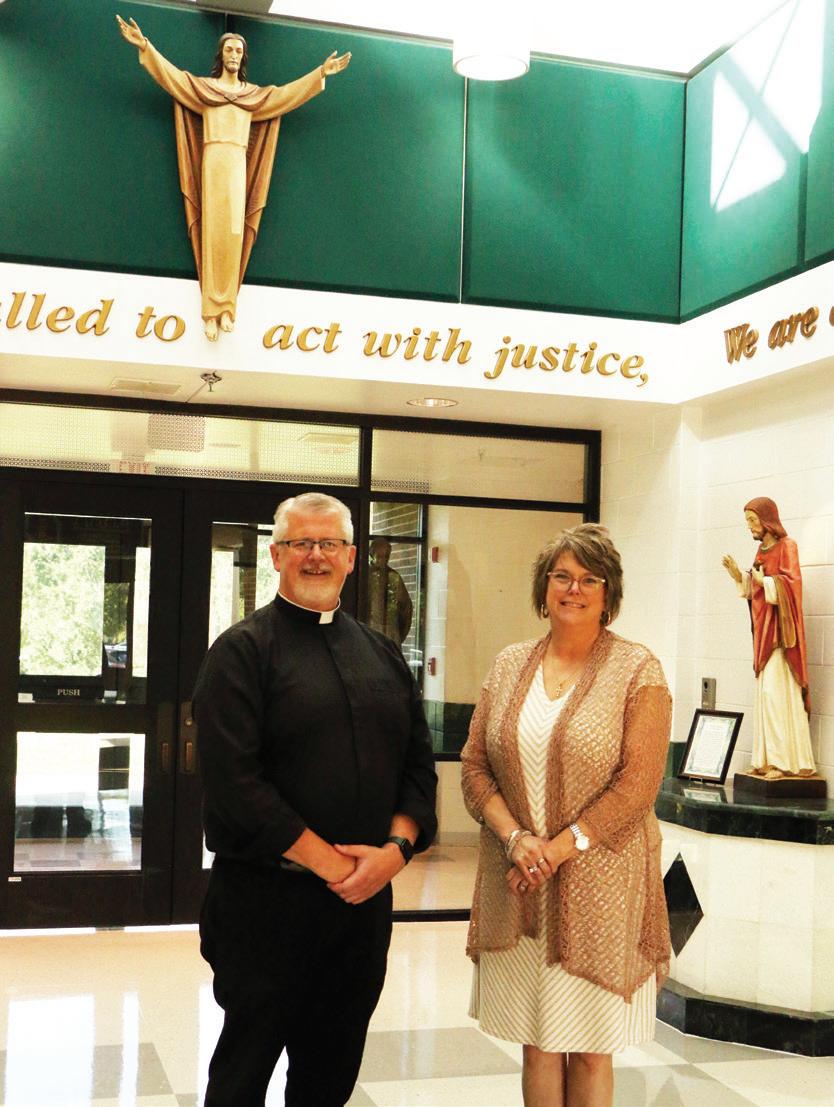
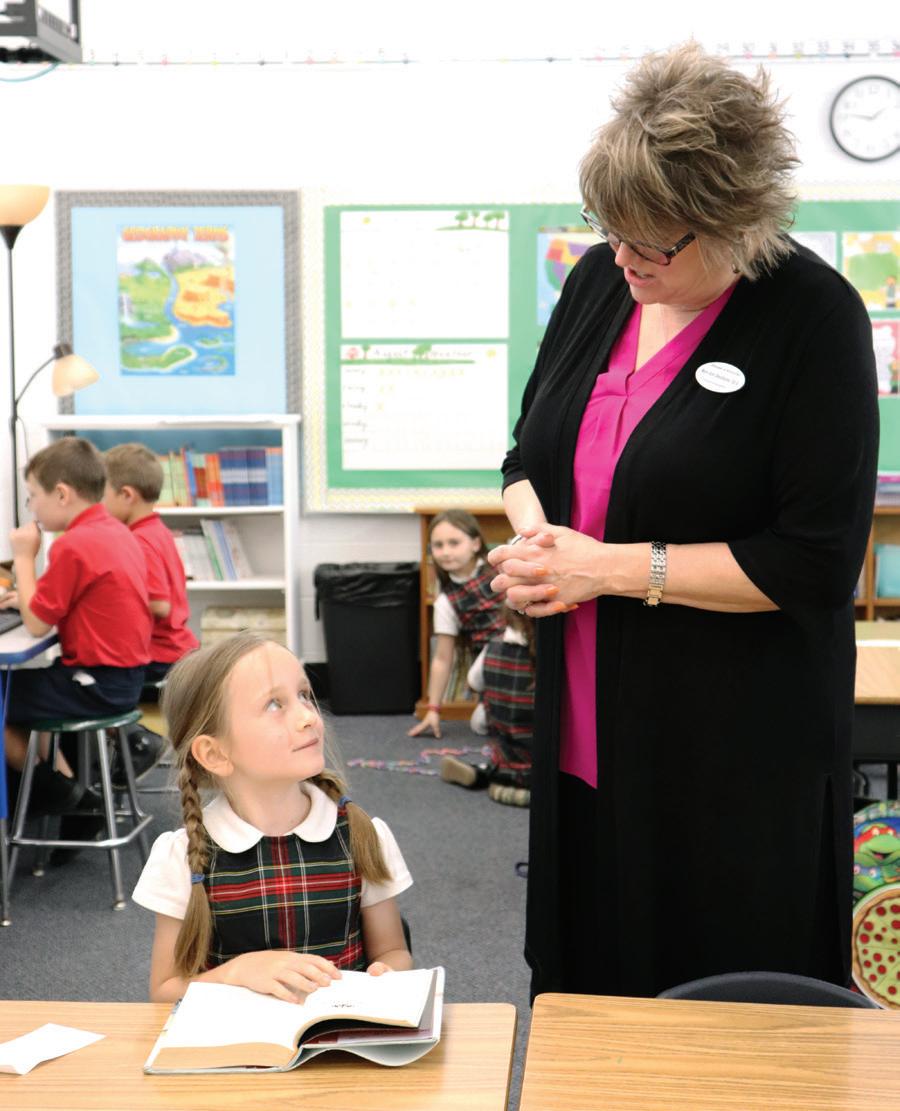

ing in any way that they can.”
“I was able to meet with some priests at a deanery meeting in Chattanooga, and just hearing the wonderful experiences that they have with Catholic education was encouraging because they accept it, they promote it, and they want to continue to support it going forward,” she continued.
Mrs. Deschaine noted that she loved her conversations with school pastors and principals during her visits.
“My goals are to teach Jesus and help to prepare souls for the kingdom,” she said. “That’s what I’m doing this first year, is getting to know everyone and seeing what they need and how we can help them.” ■
Making Catholic education accessible to students with disabilities also is key, said Andrew McLaughlin, secretary for elementary education for the Archdiocese of Philadelphia.

“We are really pushing for full inclusion for children with disabilities, rather than have separate schools for them," said Mr. McLaughlin, whose schools have seen strong growth and in contrast to national trends little learning loss during the COVID-19 pandemic, as evidenced by standardized testing.
“Ensuring every school can support students with identified special needs is a vital part of our Catholic mission, to serve all who wish to come to our schools,” Mr. Rigg said.

Along with expanding access, school administrators with whom
OSV News spoke are focused on addressing both mental health and school-security concerns.
While their students are not immune from national increases in mental-health challenges a trend highlighted by Surgeon General Vivek Murthy in a 2021 advisory Catholic schools, equipped with psychological and spiritual resources, can provide a strongly supportive environment for students and families navigating such issues.
“Often we hear families say, ‘Thank God this happened in a Catholic school, because there is a community of care,’” Mr. Rigg said. “(The) community will rally around a family in crisis.”
School security also is a priority for Mr. Rigg, given the 2018 mass shooting at Marjory Stoneman Douglas High School in Parkland, Fla., which killed 17.
“That weighs heavily on the psyche of everyone in South Florida,” said Mr. Rigg, whose safety investments include on-site police officers, cameras, and enhanced standards for ensuring campus doors are locked appropriately.
But the biggest draw at many schools is the fundamental nature of Catholic education itself, according to experts.
“When you create the type of Catholic culture that people want to be part of, you don’t have to worry about enrollment,” said Kevin Ferdinandt, headmaster of St. Agnes School in St. Paul, Minn.


The pre-kindergarten-through12th-grade school draws students from dozens of area ZIP codes, drawing from “a really broad area” and functioning “a lot like a regional school,” Mr. Ferdinandt said.

Admitting that St. Agnes had “al-
most closed in 2007” due to financial struggles, Mr. Ferdinandt said the school revisited its roots—and bore fruit as a result.
“We’ve got a very clear mission, and we serve Catholic families that are really serious about engaging their kids in education, and making sure their kids get a chance to learn what we as Catholics really believe,” he said. “If we’re going to call ourselves a Catholic school and not be serious about teaching the faith ... then we’re just private schools with a religion department. We worked hard for a lot of years to establish an extraordinary student and faculty culture (of Catholic education), and with that came the success of our school.”
“Our first role as Catholic schools is forming disciples,” Mr. Snyder said. “We are a ministry of the Church, and we want to form children who love Jesus Christ.” ■
THE EAST TENNESSEE CATHOLIC A20 n OCTOBER 1, 2023 www.dioknox.org
Getting the message Students at St. Mary School in Johnson City are always inspired by the Word of God during their coursework as are the faculty and staff.
NCEA continued from page A7
DAN MCWILLIAMS
Their happy place Students at St. Mary School in Oak Ridge receive a blessing from St. Mary Church pastor Father Ray Powell, who is sprinkling holy water on the class.
Special guest Students at Sacred Heart Cathedral School in Knoxville receive a visit from new Diocese of Knoxville schools superintendent Mary Ann Deschaine, who visited each diocesan school in August.
Prayers of the young faithful Students at Our Lady of Perpetual Help School in Chattanooga participate in an all-school Mass at Our Lady of Perpetual Help Church
Showing and telling A student at St. Jude School in Chattanooga tells diocesan schools superintendent Mary Ann Deschaine what she is reading during class.
Having a ball A student at St. Dominic School in Kingsport participates in a fun classroom activity as new diocesan schools superintendent Mary Ann Deschaine visited.
COURTESY OF SACRED HEART CATHEDRAL SCHOOL
With all our heart Students at St. Joseph School in Knoxville say the Pledge of Allegiance to begin their day. St. Joseph was among the diocesan schools to get a visit from superintendent Mary Ann Deschaine.
Pastoral support St. John Neumann Parish and School pastor Father Joe Reed is joined by diocesan schools superintendent Mary Ann Deschaine.
EMILY BOOKER (2)
GABRIELLE NOLAN
EMILY BOOKER (2)
BILL BREWER
there is no record that we know of in which he himself boasted about the work that he had done. And so we have those three H’s: heroic, holy, humble. Boy, our world needs examples of people who are heroic. In a culture in which we seem to glorify the anti-hero, the person who, if he has a fault, let’s make sure everybody knows about it, but not to lift up the example of someone who goes beyond the call of duty to serve others. We need the hero in our lives. We need the person who shows himself or herself to be filled with holiness, with a desire to follow Jesus Christ. And we need a person who’s willing in many ways to be humble. The world will offer the glitter of those three temptations that we’re told were the temptations of the devil to Jesus in the desert of pleasure, possessions, and power. And for someone to turn his or her back on those in order instead to follow the path of Christ is a saintly act. It is a step that we’re taking, but we ask for His help,” the archbishop said.
Archbishop Kurtz said that he prayed those in attendance would be more than just spectators of the event but be inspired and “allow ourselves, through God’s grace, to become a saint.”
He concluded his homily with a story about one of the most famous saints in the Catholic Church, St. Teresa of Calcutta.
“Back in 1976 I was serving as a priest in a foreign country by the name of Pennsylvania,” the archbishop quipped. “And at St. Thomas More Parish, I remember it distinctly, Mother Teresa of Calcutta, now St. Teresa of Calcutta, came to give a talk. … She spoke with a whisper, and we all leaned forward in order to hear what she was saying. And she spoke in very plain language about simply seeing people in the streets of Calcutta who had not a home or anything to put over their heads, and she could not turn her back on them. She was so inspiring that a man in the first pew, halfway through her talk, stood up in the middle of the church and said, ‘Mother Teresa, you inspire me; I want to come back with you to Calcutta.’ And what she said to him that day I’ll never forget.
“She said, ‘Sir, thank you, but the person that Jesus wants you to serve is already at your doorstep.’ You and I, inspired by the example of Father Patrick Ryan, now 145 years deceased, are asked to look at who is at our doorstep. For whom are we called to be heroic? To be holy? And to do so in a manner that is humble, befitting of Jesus Christ? It’s only when we cease to be spectators and become followers of Jesus, announcing as did Patrick Ryan, I believe in the victory of Jesus Christ over sin and death, that you and I will truly be touched by this cause for canonization. God love you,” Archbishop Kurtz said.
Following the homily came the reading of the Decree of Conclusion and the Swearing of the Oath of the Ordinary.
Archbishop Kurtz read the following in place of Archbishop Fabre:
“I, the undersigned Most Rev. Shelton J. Fabre, apostolic administrator of the Diocese of Knoxville, by law, the competent authority in the Diocesan Inquiry on the offering
of life and the fama sanctitatis ac signorum of the Servant of God Father Patrick Ryan, having heard the Episcopal Delegate, in conformity with Article 144 §1, 1 of the instruction Sanctorum Mater, DECLARE the definitive conclusion of the Diocesan Inquiry, enabling the Cause to proceed to the celebration of the Closing Session on Sept. 28, 2023, at 5:30 p.m., at the Basilica of Saints Peter and Paul, having completed the last formalities by the norm of law. Furthermore, since I am not going to be present at the Closing Session and have delegated that role to Archbishop Joseph E. Kurtz, hereby swear to have faithfully fulfilled my task in the Diocesan Inquiry on the offering of life and the fama sanctitatis ac signorum of the Servant of God Father Patrick Ryan; I further swear to maintain the secret of office, so help me God. Given at Knoxville on the seventeenth day of August in the year of our Lord two thousand and twenty-three. Signed by MOST REV. SHELTON J. FABRE, Apostolic Administrator of the Diocese of Knoxville and DCN. SEAN SMITH, Chancellor of the Diocese of Knoxville.”
Following came the Presentation of the Acts and Swearing of the Oaths by the officials of the Tribunal, including Father Carter, as episcopal delegate for the cause; Father Orr, as promoter of justice for the cause; Deacon Armor, as notary for the cause; Marie A. Martin, as notary for the cause; Rebecca Dempsey, as adjunct notary for the cause; Jennifer Morris Haug, as adjunct notary for the cause; and Deacon DeGaetano, as vice postulator for the cause.
Dr. Waldery Hilgeman, the postulator for the cause, was unable to be present due to health reasons but had signed his oath of conclusion.
Each of the officials of the Tribunal stated the following oath:
“In the name of God, Amen. I, [NAME], appointed as the [TITLE] for the Cause of Beatification and Canonization concerning the life, virtues, offering of life, reputation of holiness, and signs of intercessory power of the Servant of God Father Patrick Ryan, swear to have faithfully fulfilled my task in the Diocesan Inquiry. I further swear to maintain the secret of office, so help me God.”
Additionally, Deacon DeGaetano swore an oath as carrier of the documents to “hand over the transcript and public copy of the Diocesan Inquiry” to the Congregation of the Causes of Saints in Rome.
Following the oaths came the sealing of the documents. Each set of documents was sealed in brown paper wrapping, tied with red ribbon, and secured with wax to ensure that there was no tampering upon the documents arriving in Rome.
Lastly was the Signing of the Instrument of Closure, where Archbishop Kurtz stated the following:
“I, the undersigned Most Reverend Joseph E. Kurtz, Archbishop Emeritus of Louisville, appointed as the Delegate of Archbishop Shelton J. Fabre for this Session, by law the competent authority as Ordinary of the Diocese of Knoxville, concerning the Diocesan Inquiry on the offering of life and the fama sanctitatis ac signorum of the Servant of God Fr. Patrick Ryan, in compliance
with Article 150 of the Instruction Sanctorum Mater, declare that on September 28, 2023, in my presence, with the Episcopal Delegate, Promoter of Justice, Notaries, Adjunct Notaries, Postulator, and Vice Postulator present, during the celebration of the last Session of the Inquiry, the closing and sealing of the boxes containing the Archetype, and the two copies conforming to the original, was carried out. On the outside of the four packages containing the transcript and the four packages containing the public copy was attached an inscription by me, furnished with my signature and that of the Notary, that describes the contents therein and the definitive Closing Session that occurred. Given at Chattanooga on the 28th day of September in the year of Our Lord two thousand and twenty-three.”
After the conclusion of the session, there was a reception held in the parish hall.
Denice Eckler, a parishioner of Our Lady of Perpetual Help in Chattanooga, attended the event because of her family.
“My husband [Wade] is a deacon, and he also serves here at the basilica in the mornings, and my daughter was very interested in seeing something that we’ve never seen before,” Mrs. Eckler said.
“This is really a historical and spiritual event that we were privileged enough to attend. Just beautiful to be able to attend evening prayer and then watch the closing of the ceremony,” she added.
Mrs. Eckler considers Father Ryan to be an inspiration to others.
“I think Archbishop Emeritus Kurtz said it well when he said that courage is acting even when you are afraid, and we can all use that example. Going into the unknown but knowing that we’re serving the Lord can be a very beautiful example,” she said.
Brian Labudde, a new parishioner at the Basilica of Sts. Peter and Paul, attended the event for his children.
“We wanted to bring our children so they could see the process and learn the process of someone being declared a saint,” he shared. “And… even though we’re new residents of Chattanooga and Tennessee, we’re definitely proud of Father Patrick Ryan, and I think that he serves as a model for my children to live a heroic life and to live for someone else, not just for himself. And that’s what I want to show my children.”
As guests enjoyed food and fellowship, Archbishop Kurtz made his rounds greeting the people of the diocese he once served.
“Oh, what a grace it was. I was so pleased that Archbishop Shelton gave permission for me to do so,” he said. “And I knew I would enjoy it, but I didn’t think I’d enjoy it this much. And first of all, the ceremony was beautiful and uplifting, and then seeing the hour program on EWTN made it even more meaningful for me. And, of course, seeing my brother priests and so many laypeople, it doesn’t take long to think, yeah I feel like I just was here.”
Archbishop Kurtz said there is a “certain simplicity” in the life of Father Patrick Ryan.
“He didn’t necessarily choose a place that had yellow fever; yellow fever came to him,” he said. “And in everybody’s life there’s going to be certain things that we plan and certain things that we don’t plan. And the manner in which we respond is really where God’s grace is alive in us. … But especially the fact that you don’t have to go seeking some special thing; God’s plan comes to you. And that’s what happened with Father Ryan, and he responded in a generous way.”
For more information about Father Patrick Ryan and his cause for sainthood, visit frpatrickryan.com ■
East Tennessee Catholic News
Archbishop Fabre assigns deacon to St. Francis of Assisi
Archbishop Shelton J. Fabre has assigned Deacon James Schmall to St. Francis of Assisi Parish in Townsend to provide diaconal support to Father Antonio Giraldo.
The assignment was effective on Sept. 16.
Deacon Schmall has served at St. William Parish in Millington in the Diocese of Memphis and has relocated to the Townsend area with his wife, Lesa.

Archbishop Fabre thanked Deacon Schmall for his service to St. William and the Memphis Diocese, and the archbishop said he is grateful for Deacon Schmall’s willingness to share his gifts with the parishioners of St. Francis of Assisi.

Archbishop issues decree on sacrament of confirmation
Archbishop Shelton J. Fabre, who is serving as apostolic administrator of the Diocese of Knoxville until Pope Francis appoints a new bishop for East Tennessee, has issued a special decree involving confirmations in the diocese.
Since the archbishop is dividing his time between the Archdiocese of Louisville and the Diocese of Knoxville, it isn’t possible for him to celebrate the sacrament of confirmation at all parishes.

The archbishop has therefore issued a special decree that makes it possible for pastors to confirm their parishioners until the new bishop has been appointed and installed.
St. Stephen Church looking to fill music director position
St. Stephen Church in Chattanooga is looking to fill the position of music director and music coordinator.
The music director/music coordinator is responsible for providing the music liturgy for the 5 p.m. Saturday vigil Mass as well as Sunday Masses at 8:30 a.m. and 11 a.m. A music group assists with the Mass in Spanish at 1 p.m. on Sunday.
Anyone interested in this position should contact St. Stephen pastor Father Manuel Pérez at 423-892-1261, ext. 2. ■
THE EAST TENNESSEE CATHOLIC OCTOBER 1, 2023 n A21 www.dioknox.org
(2)
GABRIELLE NOLAN
Supporting the cause Archbishop Emeritus Joseph E. Kurtz delivers the homily for the Closing Session of the Tribunal of the Diocese of Knoxville in the cause for sainthood of Servant of God Father Patrick Ryan
Hand-held testament Marie A. Martin, Father David Carter, and Deacon Hicks Armor record and place signed documents in the cause for sainthood of Servant of God Father Patrick Ryan in official packaging for delivery to the Vatican.
Father Ryan continued from page A11
Deacon Schmall
Retreat continued from page A16
sential for the journey of Christian unity.”
Silence “is fundamental to prayer, and ecumenism begins with prayer and is sterile without it,” he said. “The more we turn together to the Lord in prayer, the more we feel that it is He who purifies us and unites us beyond our differences.”
To put the vigil’s message into action, eight minutes of silence were observed in the ornate square that was decorated with Dutch flowers. Earlier in the day, Pope Francis had created 21 new cardinals at a consistory in the square.
“In a world full of noise, we are no longer accustomed to silence; indeed sometimes we struggle with it, because silence forces us to face God and ourselves. Yet it lies at the foundation of the Word and of life.”
—Pope Francis
of the Word and of life.”
The pope noted that the silence that fell upon the square was “not an empty silence but a moment filled with faith, expectation, and readiness.”
“In a world full of noise, we are no longer accustomed to silence; indeed sometimes we struggle with it, because silence forces us to face God and ourselves,” he said. “Yet it lies at the foundation
Before the vigil, young people from Lebanon, Indonesia, and Slovenia shared their experiences of participating in the Catholic Church’s synodal journey. Tilen from Slovenia shared that he was struck by how a single question could start an “all-night series of listening, disagreeing, growing, and seeing how taking the time to
listen to each other helped us to go deeper.”
Ukrainian children dressed in traditional outfits and Nigerian musicians performed for the vigil, which was accompanied by music from the Taizé Community.
Joined at the center of the stage by the other Church leaders, Pope Francis closed the prayer vigil by praying that the Holy Spirit would fill the synod participants with “wisdom and courage in order to be servants of communion and bold witnesses of your forgiveness in today’s world.”
The Synod for a Synodal Church will continue through Oct. 29 in Rome. ■
physically, he said.
“We knew the difference, right? We knew what we were missing,” Father Boettner said. “We knew what wasn’t occurring because we weren’t able to physically receive the Lord into our bodies. That’s an important reminder to us that we are not just spiritual people. We are not just disembodied spirits wandering around the earth. We are bodily people, and that’s why we believe in a bodily resurrection. That’s why God cares about the temple of our bodies. That’s why those healings, those miraculous cures, that are associated with Padre Pio and other saints are important signs to us. It’s not just that somebody got lucky and got a miracle. They’re signs, and they’re signs of the importance of us as tangible realities and that God is concerned about us as a whole person. That’s one temple.”
The two families are the biological families Catholics are born into and “a secondary blessing: our family of choice, which includes our church family,” Father Boettner said.

“Because we belong to the human family and the family of God, we can make intercession through the saints, and they are part of our family as well,” he said. “The wonderful thing about being Catholic is we have this whole host of saints who we can learn about, who we can befriend, who we can seek their intercession, and that they have a role to play in our lives. They pray for us. They pray for us because they love us, and they love us because they see in us what God sees in us. They see the creation of God, the image and likeness of God. So today we have this special opportunity to pray with and through the intercession of Padre Pio, and his intercessions are still very effective.
“It would be the same thing—if I wanted to ask Father Dustin to pray for me, which I do, I know Father Dustin will pray for me. He’s a man of prayer, and if I asked him to pray for something specific, he would do that, too, because he’s a man of prayer. The same is true of Padre Pio. Padre Pio is a man of prayer. Even though he’s united with God in heaven, he still prays for us. I invite you today to take that opportunity to ask Padre Pio to
pray for whatever need you may have. Be as specific as you can be. Be as bold as you can be. Be as full of hope as you can be because God desires our good. God desires to save us. God desires the ultimate good for us: to draw us close to Himself so that we might be happy with Him forever in heaven. Today, pray—pray through the intercession of Padre Pio. Pray for your brothers and sisters in the family of God, and pray that God might not only hear and respond to our needs but that we might become more aware of those in need of our prayers.”
Father Boettner spoke after Mass as a line of the faithful stretched from the relics in the front of the cathedral to the back doors.
“As you can see, it’s really drawn a lot of people together. I talked to some folks from Ohio, some from North Carolina, some from Crossville, some from Knoxville. It just drew a lot of people together who wanted to pray through the intercession of Padre Pio,” he said. “At the beginning of Mass, I mentioned all the people we brought with us, not physically, but so many of us have people on our hearts who we’re praying for, people who are going through serious illness, depression, or job loss, all these different needs. Padre Pio was such a beautiful intercessor and a gift to the Church. I’m just thrilled that we can have this today and draw people together in prayer.”
Padre Pio’s popularity may be
due to the fact that “he’s relatable to people,” Father Boettner said.
“So many people who came back from World War II brought stories of Padre Pio with them, and that devotion to Padre Pio really spread throughout the United States with all those U.S. soldiers coming home. It seems like it’s really remained strong— people still identify very much with Padre Pio,” he said.
In the basilica’s Varallo Parish Hall, Father Michael Hendershott, associate pastor of Holy Ghost Parish, gave a reflection in English on Padre Pio, and Deacon Renzo Alvarado Suarez offered a reflection in Spanish. A multilingual Mass in honor of Padre Pio was celebrated at 7 p.m. in the basilica.
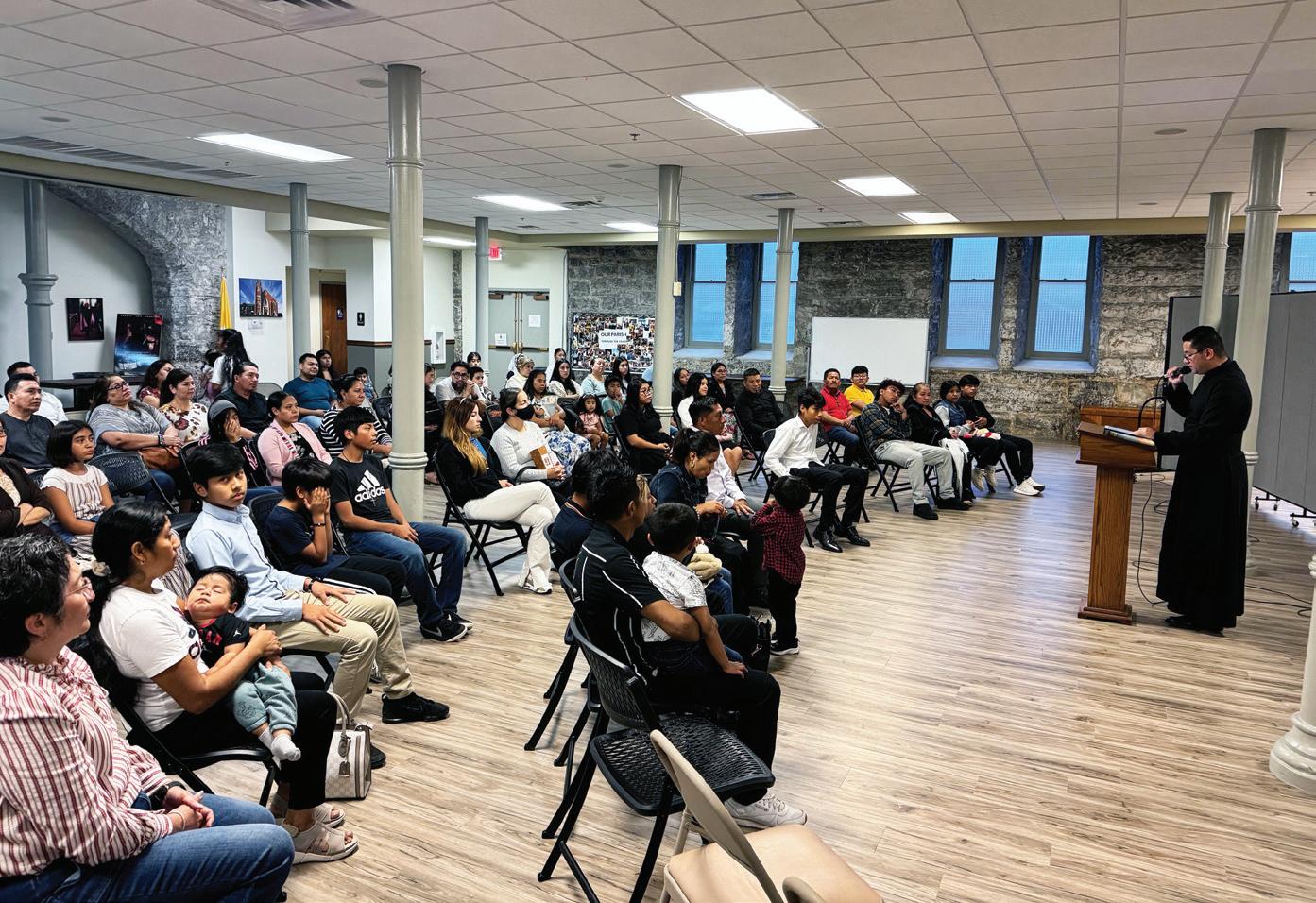
“Padre Pio is a reminder that God is still at work in the world,” said Father David Carter, rector of the basilica. “He is still calling men and women to holiness every day. He assists us through the examples of saints like Padre Pio. God also shows His care for us by answering our prayer and working miracles through the intercession of great saints such as Padre Pio.”
A relic of a saint “is what remains of the earthly body of a person whose soul is now enjoying the beatific vision of God Himself,” Father Carter said.
“As a human being, we are composed of body and soul. At death these are separated. But we know that on the last day the body and soul will be reunited through the resurrection of the
body. That is why we hold these bodily remains (relics) in such veneration. These are the bodies that will share in the resurrection of the just and stand in the presence of God almighty.
To have the relics of a saint as well-known and as powerful in intercession and working miracles has caused many people’s hearts to move closer to God. The closer we get to saints, with whom we can relate as human beings, the closer we get to God, with whom that saint is now joined in heaven. This is a part of the mystery of belonging to the body of Christ and the communion of saints,” he noted.
As did the cathedral, the basilica “had a steady stream of visitors and people from all over who came to venerate the relics of Padre Pio. It perhaps wasn’t as large a number as at the cathedral the previous day, but we counted the number in hundreds,” Father Carter said.

“We had people from all over the Chattanooga area for sure, but even people from as far away as Nashville, Atlanta, and Birmingham took advantage of the visit of these relics to the basilica. It was a great way to gather together many who otherwise would be spread out over large distances. By all of these people coming together in devotion, the body of Christ and the communion of the saints was made manifest. This was especially true at the Mass we offered at the close,” Father Carter continued.
“We had people from many diverse communities at one liturgy. To respond to this diversity, we expressed the universality of our Catholic faith by having Mass in multiple languages. The readings and the parts for the people were prayed in English and Spanish, and the Canon of the Mass and the sung ordinary were prayed in the Latin language common to all Roman Catholics. Singing the Sanctus and the Agnus Dei together with one voice, we were able to manifest the unity of faith that is our sacred heritage, which includes Padre Pio and the many holy men and women who prayed in this universal language throughout the history of the Roman Catholic Church.
also sang the Kyrie in Greek as a nod to our Eastern brothers and sisters who shared the faith with the early church in Rome,” he con cluded. ■
THE EAST TENNESSEE CATHOLIC A22 n OCTOBER 1, 2023 www.dioknox.org
We
Padre Pio continued from page A6
Reflecting on St. Padre Pio Left: Father Michael Hendershott, associate pastor of Holy Ghost Parish in Knoxville, leads a reflection on the life and sainthood of Father Pio of Pietrelcina, more commonly known as Padre Pio. The reflection was given in Varallo Parish Hall in the Basilica of Sts. Peter and Paul in Chattanooga, where the relics of Padre Pio were displayed on Sept. 27. Right: Deacon Renzo Alvarado Suarez, who is serving at the basilica, gives a reflection on St. Pio of Pietrelcina to the basilica's Hispanic community in Varallo Parish Hall on Sept. 27.
COURTESY OF BASILICA OF STS. PETER AND PAUL (2)
In touch with a saint A parishioner touches her hand to a Padre Pio relic of a gauze with the saint's bloodstains at the Cathedral of the Most Sacred Heart of Jesus on Sept. 26.
DAN MCWILLIAMS


















 By Gabrielle Nolan
By Gabrielle Nolan
































 By Maria Wiering OSV News
By Maria Wiering OSV News

























































































